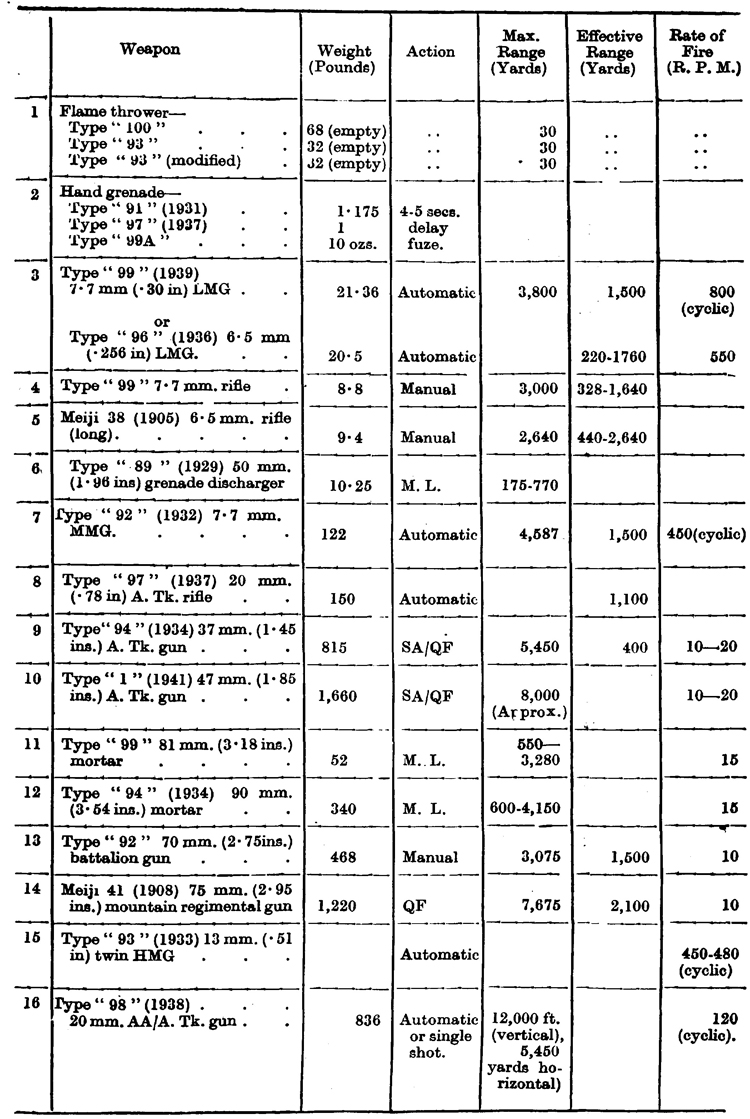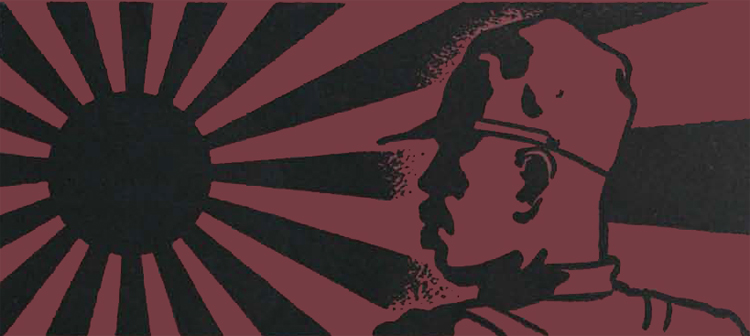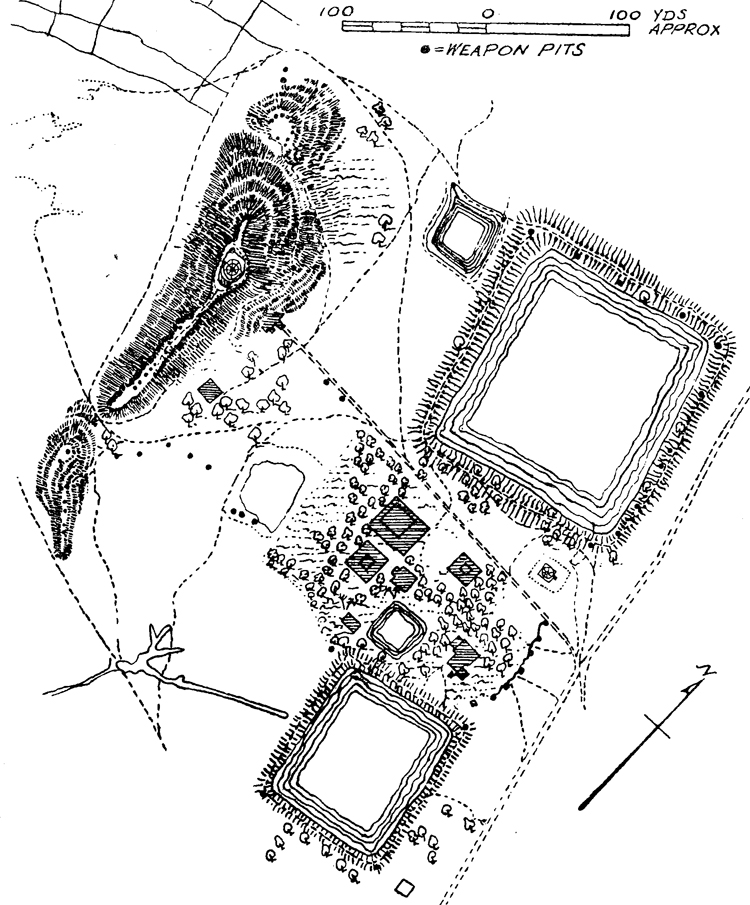Slave to the Game
Online Gaming Community
ALL WORLD WARS
JAPANESE IN BATTLE
First and Second Edition, 1943, 1944
ENEMY METHODS
JAPANESE IN BATTLE
1st Edition
GENERAL HEADQUARTERS, INDIA
MILITARY INTELLIGENCE DIRECTORATE 4/G.S.I. (t) MAY 1943
THIS DOCUMENT MUST NOT FALL INTO ENEMY HANDS
FOREWORD.
The Japanese are an island race who have mastered the art of war, not through any mysterious or indefinable quality inherited from their Emperor, their islands, or their ancestors during your grandfather's time they were still in the bow-and-arrow stage—but through serious study of ancient and modern methods, and by intensive training. If we analyse their tactics, reducing them to fundamentals, all that they practise is to be found in our own training manuals, or in the military histories of ancient campaigns ; not even the snipers in the trees are new— the jungle tribes of Africa and Brazil have employed them since time immemorial.
In their long history the peoples of our Empire have shown the world that they possess more than an average share of courage and tenacity, and today we must add to these advantages our undoubted superiority in arms and equipment. Any success which the Japanese have had against us was due to intensive training, carefully rehearsed plans and normal guts. Whatever the task in hand—be it the digging of a single fox-hole or the preparation of a large-scale invasion—their work is done with meticulous care, and by intensive and sustained training alone can we hope to outmanoeuvre them.
This pamphlet is largely the work of soldiers and airmen fighting in Burma and the South West Pacific who, in notes, sketches and photographs, have recorded their observations of the Japanese in Battle.
Special acknowledgement is due to the American Marine Liaison Officer of the Pacific Ocean Areas whose appreciation of Japanese characteristics and methods has been quoted in Chapter I, Section 2. Acknowledgement is also due to our Allies for the drawings reproduced as Examples 13 and 15 in Section 4 of the Chapter on Defence.
Part II, which is devoted to the important subject of counter measures, is being prepared by the Military Training Directorate, G.H.Q., India Command.
CHAPTER I. GENERAL
1. Morale.
"When I received my mobilization orders, I had already sacrificed my life for tny country. . . .you must not expect me to return alive "
1. This sentence is quoted from a letter found on the body of a dead conscript. It is by no means exceptional and indicates a fanatical conception of service which finds expression in a disregard for personal safety and a readiness to fight to the last man and the last round. The morale from which such feelings of self-sacrifice spring, is based on an attitude of mind assiduously cultivated from a very early age.
Japanese moral training instils a strong religious belief; " Comrades who have fallen !" reads what is almost the last entry in a soldier's diary, " Soon we shall be fighting our last fight to avenge you, and all of us together, singing a battle song, will march to Kudan ". (Kudan is a shrine near Tokyo dedicated to the war dead). The second pillar of Japanese morale is deep personal devotion to the Emperor. The last blood-smeared page of a diary captured in Burma has " Three cheers for the Emperor " scrawled across it. The Army belongs to the Emperor and its mission is his divine will. Finally the Japanese believe they are a chosen people, a superior i-ace. Such is the basis of a morale to which is closely allied a high state of individual and collective battle discipline.
All this does not mean that the Japanese are immune from fear and defeat* By a different process they have reached that stage of fanatical self-confidence which the Nazis reached in 1939. " We are a superior race with a divine mission. We are invincible ". These are the foundations of sand upon which Germans and -Japanese alike'have built their morale, and the initial military successes which both these countries achieved against their ill-prepared enemies gave ample credence to the lie of invincibility. But the Nazi no longer goes into the attack making the Hitler salute or with " Heil Hitler " on his lips, and his arrogant self-confidence, subjected to the growing armed might of the United Nations, is crumbling. And so with the Japanese ; faced with the example of Germany and the just retribution which will most assuredly overtake them, they cannot hope to maintain a morale which is based on the fallacy of invincibility and a divine mission. Even now (May 1943) when our main effort is still confined to Europe and North Africa and the situation is more favourable to the Japanese than it can ever be again, we find that the desire for self preservation can at times be stronger than the desire to stay and fight it out. To quote from a recent situation report—
"After a fairly quiet night the enemy attacked the 1 Punjab posns from the North. No ground was given, but the feature known as the Pimple, not previously occupied by us was occupied by the enemy.... a counter attack was put in by a coy of 1 Punjab and a pl of 15 Punjab with the bayonet. It was completely successful and drove the enemy off the Pimple and out of the village. The enemy retreated across the open country NE where they were caught by our arty..."
Our counter attack cost the enemy about 103 killed, of which 73 have been checked over not counting those killed and wounded by our arty...."
A prisoner of war describing the action said—" The fire fight developed in earnest at about thirty yards range and then the bayonet charge which followed completely overran our position. I was wounded twice in the chest and before losing consciousness saw my comrades beat a hasty retreat ".
In conclusion a statement made by a Japanese recently captured in the Arakaa is worthy of note. He volunteered the information that our shelling and bombing ihad caused, besides shell shock, several cases of nervous prostration.
2. Tactical Characteristics.
2. To quote from an American appreciation : " Japanese tactics in general are
based on deception and rapid manoeuvre. They will go to extremes to create falsa
impressions. Sheer weight of numbers and steam-roller tactics are apparently
distasteful to them, as they lack finesse, though such would probably be used if
required. One gets the impression that the perfect solution to a tactical problem is
a neatly performed strategem, followed by an encircelment or a flanking attack
driven home with the bayonet. This allows of the commanders to demonstrate
their ability and the men to show their courage and ferocity in hand to hand
fighting. Their plans are a mixture of military artistry and vain-glorious audacity ".
" Deception, strategems and ruses must be expected at all times. Bull-dog tenacity in carrying out a mission, even to annihilation, will very frequently give a most erroneous impression of the Japanese strength and will often result in small forces overcoming larger ones, as their units are not rendered ineffective until they are nearly all casualties ".
" This capacity for driving on despite losses is not only displayed by officers. Training for the Japanese has been so thorough that every man will keep plugging until his own part of the main mission is completed. Long experience has taught even the privates what must be done before a mission is completed, and discipline, lack of imagination, and fatalism, drives them on despite losses.
"To the Japanese leader, tactics is an art, with decisions gained by skill, not by sheer power. Their policy for the use.of manoeuvre may appear to lead towards complicated evolutions. Training and the delegation to subordinates of the initiative for independent action are most probably the factors that make such tactics simple ".
3. The Principles of War.
3. In the second edition of Japanese Military Forces it was stated that the principles of Surprise and Mobility characterized all Japanese land operations. To these must undoubtedly be added the principle of Offensive Action.
4. Surprise is achieved in both strategy and tactics and ruses are extensively, employed. Approaches through country regarded as impassable and the conduct of operations during foul weather are means by which troops more sensitive to ground and climate have been placed at a disadvantage. The fifth column has been freely employed, and with their aid it has been possible greatly to increase the methods by which the enemy can be taken by surprise.
Ruses include the use of disguises, calling out in the language of the troops opposing them and feigning panic and disorganised withdrawal. This last ruse may be accompanied by strewing the line of withdrawal with stores and equipment— all carefully covered by concealed machine guns.
5. Mobility, which is achieved in a number of ways, has been one of the most
important factors in obtaining surprise. The ability to exploit to the full the
exceptional marching powers of the troops—they are capable of covering thirty or
more miles per day—is closely allied with the ability to feed them. They may, by
chosing a circuitous path through difficult country, attempt to overtake and cut the
line of retreat of a force withdrawing along a road, but mobility does not end there;
if the chances of living on the country are small troops may carry as much as seven
days rations with them thus freeing themselves during this period from the encumbrance of an administrative tail. Impressed local inhabitants, with carts if the
country is suitable, supplement their carrying powers, whilst opportunities to seize
local supplies are never neglected.
The Japanese soldier has been trained to carry up to 58 lbs., which is what Napoleon's troops carried when they marched to Moscow—but their total load included 15 days rations ! Lest either of these loads should be thought exceptional we should not forget the British troops in the Peninsular who carried about 60 lbs. and those at Mons in 1914 who carried only a few pounds less.
It should on no account be construed from this paragraph that the Japanese habitually carries a heavy load of rations and equipment, for like us he prefers to fight as lightly equipped as possible, but the pointworthy of note is that if several days' mobility can be achieved only at the price of carrying a load of rations on his back, he is prepared to carry itr
About our own mobility the Japanese have stated " Although the English Army has some mechanical mobility, in general it does not have much manoeuverability "
6. Offensive Action is described in one of our training pamphlets as a principle which gives moral superiority and, tends to confer the initiative and, with it, liberty of action. A famous British general recently simplified it thus " The object of every soldier will be to kill Germans ", and this is very near to the Japanese interpretation for the latter applies the principle of offensive action not only to his attacks but also situations in which his defeat is a foregone conclusion. Whatever the situation his object is to kill the enemy. " If only I can die killing six or seven of the enemy instead of by his first onslaught " writes a diarist just before the last attack is made by a small party.
In August 1942 American marines raided an island held by about 90 Japanese. The raid was a complete success and most of the garrison were annihilated. The remnant, however, estimated at about a dozen, attacked the raiding party as it was leaving the island and thus suffered further casualties. It is an interesting example of offensive action in desperate circumstances.
4. An Example of strategic mobility.
An outstanding example of strategic mobility on the part of the Japanese was their advance through the Shan States from Karenni in the South to Myitkyina in the North, a distance of some 450 miles, covered in three weeks. This feat is even more remarkable when it is realised that during their advance the Japanese fought three not inconsiderable engagements and were hindered by numerous delaying actions.
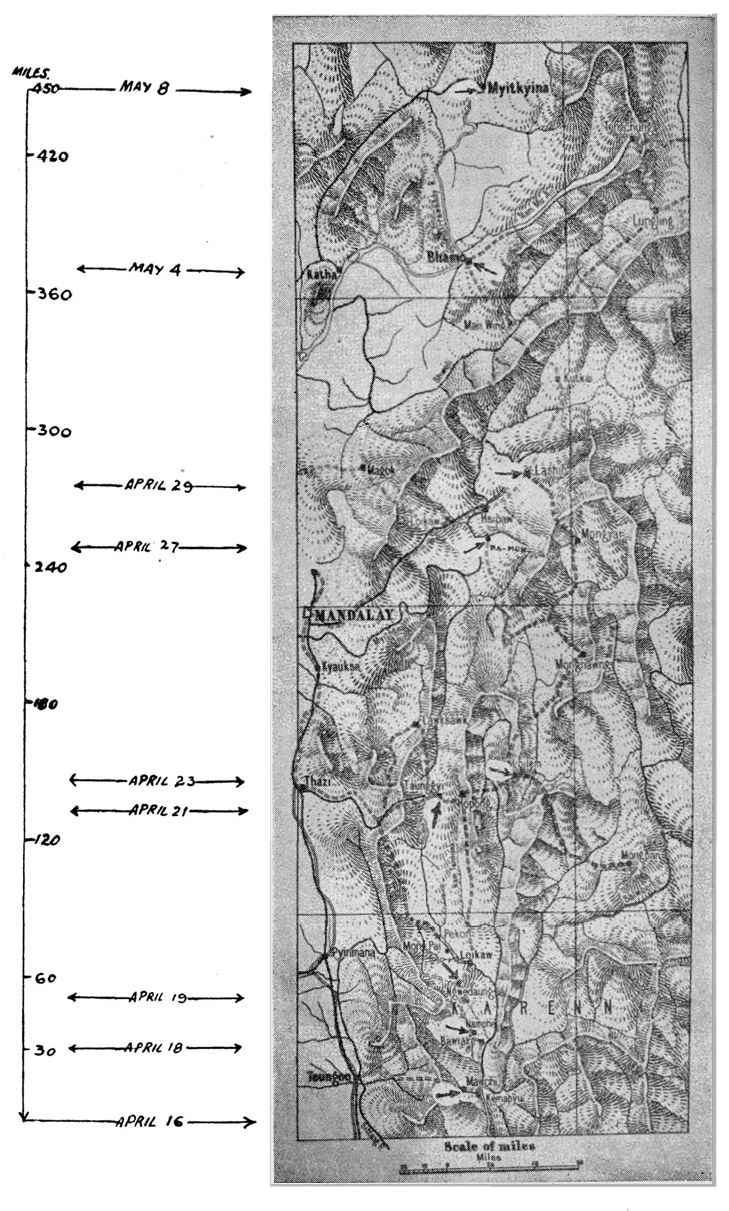
In early April 1942 the Japanese forces, consisting of the 56th Division, advanced northwards between the Salween and Sittang Rivers and occupied the town of Mawchi. Facing this advance the Chinese disposed four battalions in depth along the road Mawchi-Loikaw.
On April 17th, the Japanese, having made unsuccessful frontal attacks against the Chinese, by-passed the position and cut the road between Bawlake and Namphe, reaching the town of Namphe on the following day. Here, there was heavy fighting but the enemy overcame all opposition and pushed on another 20 miles, reaching Ngwedaung on the morning of the 19th.
Two days later, on the evening of April 21st, the Japanese had occupied Taunggyi, having carried out a large scale encirclement of the Chinese positions-Loilem, a town some 40 miles away, was their next objective, and this they captured on April 23rd after by-passing the Chinese, who had taken up defensive positions along the Taunggyi-Loilem road.
In the next four days the Japanese force pushed on another 120 miles, reaching Na-mon on April 27th. Two days' heavy fighting ensued, but the enemy succeeded in maintaining their advance and pushing the Chinese from Lashio, to positions at Kutkai some 40 miles northward. Once having succeeded in ejecting the Chines© from this position, and having surprised the force holding the bridge over the Shweli River at Man Wing, no further organised resistance was offered to the Japanese advance. As a result Bhamo was entered on May 4th and Myitkyina was occupied four days later, on May 8th.
DISCUSSION.
The maintenance of a daily average advance of some 21 miles despite delaying actions and despite having to fight battles speaks for itself as an example of strategic mobility.
In considering how this advance was achieved the following points are outstanding. :—
Firstly, the skill of the Japanese in the choice, direction and execution of their encircling movements which, probably more than any other single factor, accounted for the speed and great distance of withdrawals the Chinese were compelled to undertake.
Secondly, the refusal on the part of the Japanese to be deterred from their primary objective by threats to flank or rear.
Finally, there is the ability of the Japanese to move without a cumbersome administrative tail.
5. Orders.
7. Japanese operation orders are often extremely brief. The general absence of detail suggests that battle has, where possible, been reduced to a drill. In the large number of captured orders available for examination little reference is made to frontages, dividing lines, or supporting fire; this is because Japanese units are generally given clearly defined features as objectives while artillery is placed under the command of units or even sub-units and may fire by observation at targets of opportunity.
In Chapter XII of the second edition of Japanese Military Forces examples were given of an order for the advance to contact and an attack order. Below are three orders for the defence, the first two, which are more in the nature of instructions, are extremely brief, the third is in some detail and it was accompanied by a sketch ; the •ketch has not been reproduced.
Example 1.
HORI Order No. A-137 South Seas Detachment Order
6 Nov. 0900
ILIMOW
1. Since yesterday (5th) morning YAZAWA Unit (BUTAI) has been attacked by approximately one enemy battalion which was repulsed. Since last evening, security unit (BUTAI) of KUWADA Battalion has been attacked by a small number of enemy, which were repulsed. The situation at the rear of the enemy line is not clear, but troops seem to be there.
2. The Detachment will consolidate the key point along the road to the south of ILIMOW.
3. One Coy. of the YAMAMOTO Regiment (less 1/3 2 M. G., 1/2 P, casualties collecting detachment unit, No. 3, portable wireless attached) shall depart from its present position immediately, followed by the main body, and proceed to BAIBARI and consolidate the key points in the vicinity of said place.
4. YAZAWA Regiment is to carry on its present duty.
5. I will be at ILIMOW.
Detachment Commander
HORI, Tomitaro
Method of distribution :—
Summon Lt. Colonel TSUKAMOTO and issue it verbally. After it has been sent to Colonel YAZAWA by telephone, it will be issued verbally, to be written down.
Example 2. HORI Order No. A 316.
South Seas Detachment Order 0600 3 Nov. PAPAKI.
1. According to the reports from YAZAWA Unit (BUTAI), a portion of the enemy is now advancing toward the vicinity of KOKODA and ISURABA road south of FUKURAKUHI (T. N :—FUKURAKU-tombstone or monument. This may be the name of a place) A part of YAZAWA Unit (BUTAI) was attacked last evening, but repulsed the enemy.
2. A part of the detachment (SHITAI) will protect the rear of the left flank in the vicinity of ILIMOW.
3. The YAMAMOTO R (T. N :—Regiment) will occupy a position in the vicinity of BAIBARI, 6,000 kilometers south of ILIMOW, with its main strength (3rd. Bn.) in order to protect the Detachment's left flank YAMASAKI Engineer platoon will assist.
4. YAZAWA R is to carry out its present duty. No. 88 Wire Company of HOZUNI unit H.Q. is released from the detail.
5. I will be here.
Detachment Commander :— HORI, Tomitaro.
Method of distribution:
After substance is sent to YAMAMOTO Unit (BUTAI) Commander by runner or radio, verbally issue to the order receivers for their notes.
Example 3.
SECRET
Order No. 5 for No. 3 Company of KURE No. 3 Special Landing Party— August 17th 1942, at KAVTENG Company Headquarters. Commander of
No. 3 Company, Kure No. 3 Special Landing party, MARUYAMA JUNTA.
Order for No. 3 Company.—
1. Enemy situation.—The enemy appeared in the seas near the Solomon Islands with powerful operational units, and a large number of transport ships, opening an attack against position " X " at daybreak of August 7th.
2. Situation of our troops.—No. 1 Coy. has despatched sentry groups and is in the midst of constructing defensive positions on the plateau south of the pasture in the PANAPEI district, and on the seacoast of PANAPEI.
3. Company Commander's Decision.—This Company, following the secret operational Order No. 17 of KURE No. 3 Special Landing Unit, will construct defensive positions along the coastline of the Seaplane Base south of NUAN and perfect the defensive preparations against the ocean front.
4. (1) No. 1 Platoon Commander will direct his own. platoon, the H.Q. Platoon, and No. 2 Platoon (all members except those on duty), and must quickly construct defensive positions as designated.
(2) The HQ Platoon Commander, and the No. 2 Platoon Commander will place under the direction of No. 1 Platoon Commander the necessary number of men required during the construction of the positions.
5. Distribution (disposition) of troops on the ocean-front as per attached map
No. 1.
(1) Nos. 1 and 2 Platoons (To each will be attached one quick-firing gun, one heavy machine gun, one light machine gun, one heavy grenade discharger) the first line. Positions No. 2, No. 1 Platoon, Position No. 1 and No. 2 Platoon. The Q Platoon, reserve unit.
(2) The HQ Platoon Commander must lay telephone lines between the 1st
and 2nd positions. (In case there is more than 2 distribution of positions).
(3) The Front Line Platoon Commander will diligently strengthen defensive
(defence) positions in the area under his charge, clearing the field of fire so as to give
maximum fire power, and facilitate speedy movements of troops.
It is also necessary to take strict precautionary measures in the flank and rear.
6. Distribution (disposition) of troops on the Land side, is to stand by at the
Company Headquarters.
7. Orders for commencement of movements of various units will be given later.
Particulars of Commands.
1. Alarm Call.—(Landing Unit Assembly Call) by bugle call (Landing Unit
Assembly Call) or by verbal orders (messengers).
2. Personnel.—All members except those on duty. (Even those who are unable
to participate in the actual battle on account of illness, must arm and stand by at the
'Company Headquarters).
3. Assembly Point.—East side of the Company Headquarters.
4. Armaments, and ammunition carried by troops—As prescribed by the
Landing Unit. (Reserve ammunition will be loaded in the trucks).
5. Vehicles.—Five trucks (for transporting units and moving men).
One machine gun carrier (for use in commanding and liaison).
One Passenger Car (for use in commanding and liaison).
6. Information, reconnaissance and patrols.
8. The Japaneseadvanced into Malaya and Burma using reproductions of British Ordnance Survey maps upon which Japanese translations had been super-imposed. The information which these maps provided was supplemented by a detailed study in peace time of the probable area of operations. This study involved the " planting " of commercial photographers in places of operational interest and other forms of " economic " penetration the primary task of which was espionage. Consider able success was also achieved in organizing the fifth column through which it was possible to continue the collection of information after photographers, barbers, tatoo artists and all the other Japanese who had found their way westward, had either left hastily or been interned. With fifth column assistance it was possible to obtain up-to-date information on dispositions and defences and during mobile operations to direct aircraft onto headquarters and other suitable targets.
9. During the early days of the war in the South West Pacific and Burma, the Japanese often subordinated reconnaissance to speed of advance; Frontal attacks were launched against imperfectly known positions and bold decisions were taken even where information was lacking. The initial offensive had succeeded and whatever the cost the momentum was to be maintained; the operations evolved themselves into one vast encounter battle in which the Japanese, having siezed the initiative sought to maintain it. As resistance hardened, however, their attention to reconnaissance became once more evident and operations in Burma in particular show an intimate topographical knowledge which could only have been obtained by extensive patrolling and by the employment of local inhabitants as guides.
10. The use of small patrols in a purely reconnaissance role has often been
reported. According to the nature of the country and the task involved these
patrols may either remain in observation in one place or make a reconnaissance
involving a march of several days during which they are entirely dependent on what
they carry themselves. Patrols of this nature often consist of three to six other
ranks commanded by an officer or N. C. 0. They will often be in local civilian dress.
Reconnaissance reports are frequently accompanied by sketches the general standard of which is high. If it is considered that the task involved does not warrant the employment of a patrol a couple of scouts may be used instead. Their tasks may be to lie in hiding near our positions and observe.
11. Fighting patrols vary in strength, but a platoon or less is commonly
employed. In Burma the activities of these patrols have been confined almost
entirely to the hours of darkness, the exception being when they have been sent
out by day some distance to a flank—sometimes with the object of seizing local
herdsmen for interrogation.
The tasks of troops patrolling at night vary from drawing fire in order to discover our positions, to determine raids in which attempts are made to overwhelm small posts. Drawing fire is, however, by far the most common activity.
12. Reports from New Guinea describe how once, strong patrols (30, 60 or 120, are the figures quoted) were employed by the Japanese whose " movements were similar to those of troops in an encounter." It is clear from the account given, that these were small aggressive detachments which advanced along jungle tracks until they made contact with our troops ; they then endeavoured to hold them frontally whilst sections or platoons tried to outflank them through the jungle. It is possible that such offensive action will be taken by patrols covering the occupation of a defensive position.
7. Training and rehearsals.
13. In peace the Japanese train for war. In war they train for important operations. The severity of their training is worthy of note, and the following extracts from reports by officers who were attached to the Japanese Army before the War give some indication of the thoroughness of their preparations :
" The autumn manoeuvres of the Guards Division took place in the first halt of November in the mountainous region round the semi-active volcano Mount Asama about a hundred miles northwest of Tokyo.
The weather was extremely severe, the temperature well below freezing point in the daytime and considerably colder at night, with snow, rain and high wind. "... .According to the plan of the directing staff, a defensive position should have been occupied the following evening.... but owing to the ice and snow the mountain roads had become dangerous for horses and vehicles so that part of the scheme was called off and the division marched on to the starting area for the next phase, whilst that part which was to form the skeleton enemy marched back over the Torii Pass to their billeting area, arriving at about six that evening surprisingly fresh considering they had marched some seventy miles in forty-eight hours under very trying conditions...."
Another report—
" The march to camp, a distance of twenty-six miles, was done under company arrangements, after the whole Regiment had left barracks together On arrival at camp, after an average of eleven hours on the road, all companies carried out P. T. or rifle exercises before the evening meal. The companies of the battalion to which I was attached had breakfast at 4-30 A.M., lunch at 12-30 P.M. and supper at 5-30 P.M.
A third report—
" A full pack and three ammunition pouches were carried on all training " (This was in 1938. The full weight of equipment carried will have been approximately 58 lbs.)
14. When War comes this tempo is, if possible, intensified—
" August 25th 1942. Get up at 0300 hrs for landing practice. 0400 hrs landed and took up battle positions. 0600 hrs the first fight ended near swamps. Have breakfast. From about 0800 hrs do second attack and defence exercises and then-some sea bathing. Return to ship. From 1500 hrs cleaning of arms and equipment. How busy we are bathing every day fully-equipped. Since formation of unit only 3 hours sleep per day."
Before the attack on Malaya troops trained in French Indo-China carrying full equipment, i.e. 58 lbs. Subsequently they advanced down the peninsular carrying the absolute minimum. The practice of making the troops carry more in training than in actual operations is an old one dating back to the time of the Roman legions.
Operations may be carefully rehearsed ; this does not mean that the Japanese train on a model of the position they will eventually attack, but rehearsals include intensive training under conditions closely approximating those under which they will be required to operate. For example Japanese troops have achieved surprise more than once by advancing through what has been regarded as more or less impenetrable Mangrove swamp. Without careful training this would hardly be possible, and troops are practised in overcoming such obstacles for weeks before they are committed to the actual operation.
Finally an element of surprise is introduced into training as often as possible, and a unit resigned to several weeks routine may easily be woken up in the middle of the night and ordered to move fifty miles at once.
8. Road blocks.
15. The Japanese employ road blocks— to cut off a force retiring, to protect one or both flanks of an encircling movement, as part of a defensive system.
16. As far as possible road blocks are sited in positions where they effectively prevent all movement until attacked and cleared; this is particularly the case in defence when they are most likely to be encountered on defile3 the possession of which is vital to an advancing force. The following sites have been chosen in the past— area of a bridge upon which several routes converged, single road with dense jungle on both sides, centre of a town or village. The exact position may be just over the crest of a rise, or round the bend of a road—in fact anywhere where vehicles will be close upon the road block before drivers can stop or turn round.
17. Roads may be blocked with felled trees or vehicles. Some blocks have been formed simply by firing at point blank range at the first few vehicles to round a, bend or clear a crest. Occasionally roads have been blocked by a series of three obstacles sited at approximately half-mile intervals.
18. A road block position may be covered by a force varying from a small party
with a machine gun to a whole regiment. If not brought quickly to battle and
destroyed small holding forces are often reinforced, until finally the block becomes a
well organized position defended with the greatest determination.
Blocks are normally covered by an infantry gun sited about 50 yards from the block in a position from which it can fire straight down the road. If we are using tanks, the 37 mm. gun must also be expected. At the same time machine guns— light or medium—deny the road to unarmoured troops. Sites chosen invariably include cover on both sides of the road in which troops protecting the flanks of th& road block conceal themselves.
CHAPTER II.—THE COUNTRY YOU MAY FIGHT IN.
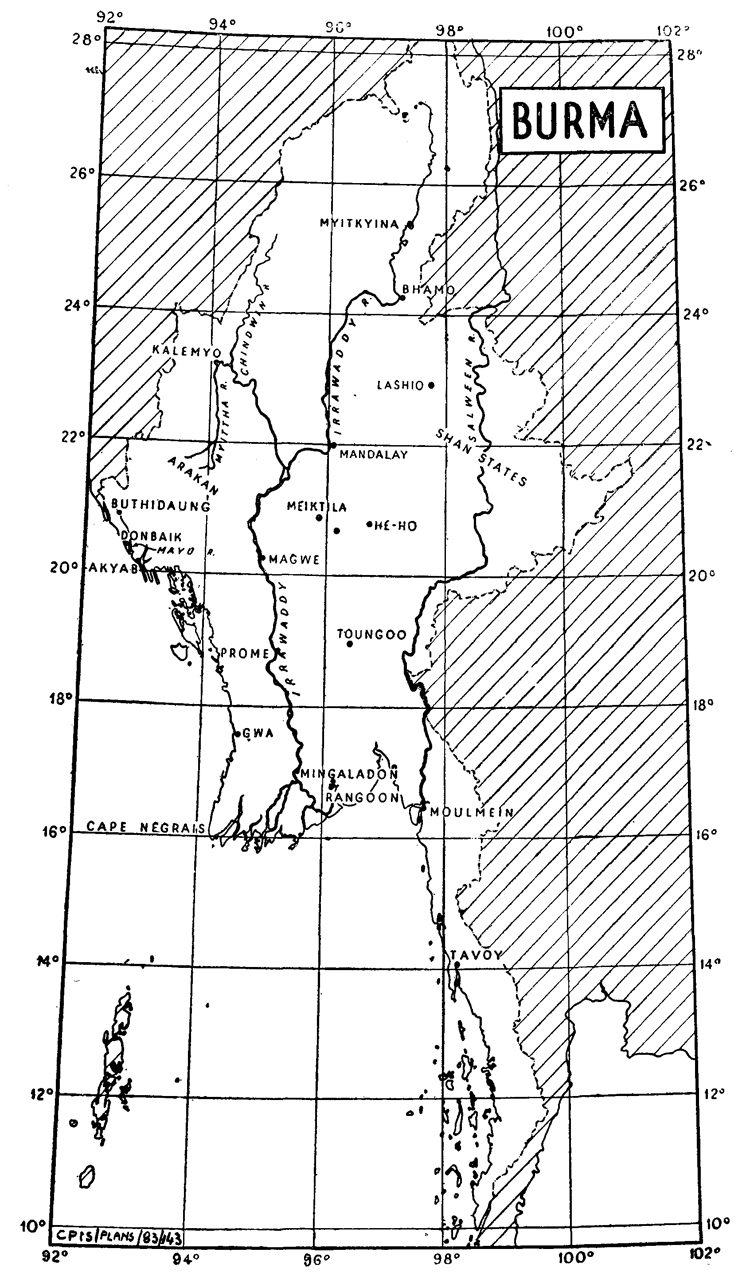

1. Part of the Mayu River area, showing the flat plain with occasional nullahs a and wooded hills,
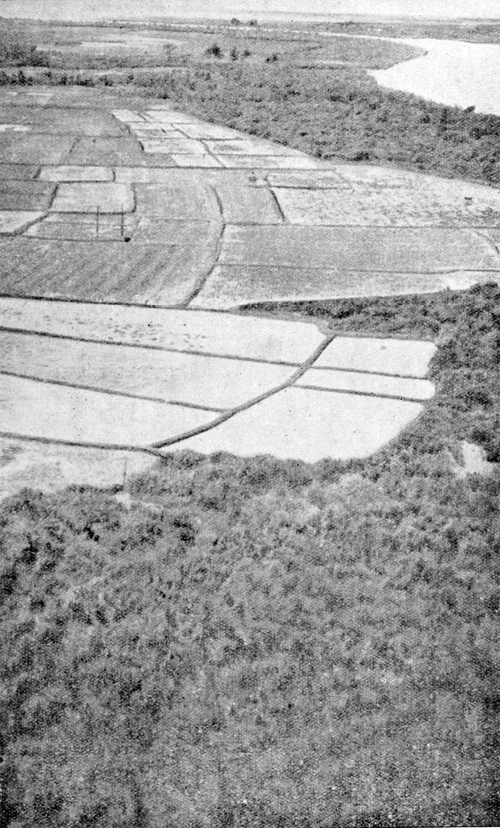
2. Typical of very large areas in the Arakan and the deltas of all Burma's larger rivers, this picture, shows an area of tidal creeks, scrub mangrove and rice fields near Akyab.

3. This picture of the Myittha Valley, south of Kalemyo, gives a good impression of conditions existing over large areas of the undeveloped portions of upper Burma.

4. A beach scene on the west coast of Burma, Similar country may he seen, anywhere between Gwa and Cape Negrais.

5. A photograph showing typical dense evergreen forest. Large areas of this type are met in the Arakan Yoma and in other areas of heavy rainfall including Upper Burma.
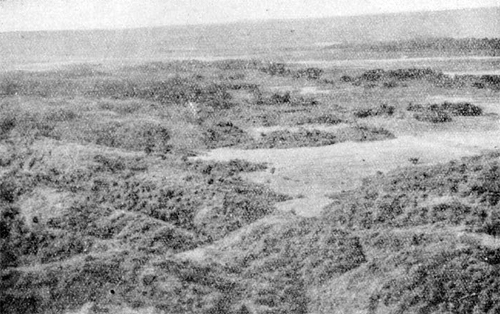
6. Foothills and valley near Buthidaung. Cultivation can be seen on the flat pound, but the hillocks are clothed in scrub. Similar conditions may be experienced throughout Burma between cultivation and hill forest.
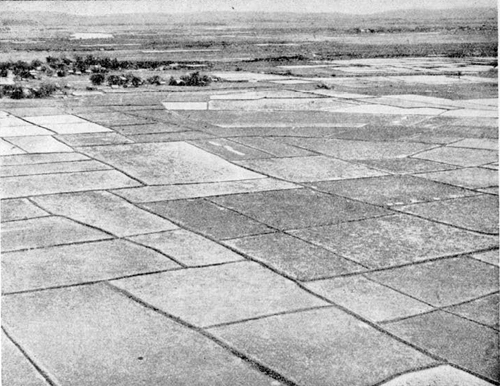
7. These paddy fields near Akyab are typical of rice fields in the plains anywhere in Burma.
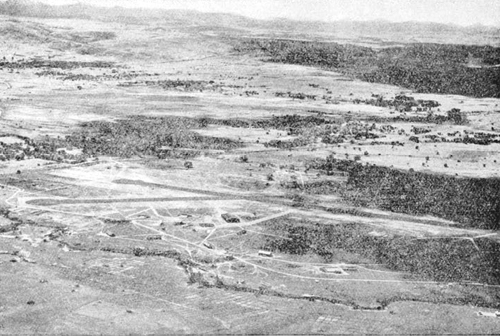
8. A view of Heho landing ground on the Shan Plateau, giving a good impression of the open, grassy downland encountered over wide areas with an altitude ot between 4,000 and 7,000 feet in the Shim States.
CHAPTER II.—THE DEFENCE.
1. General considerations.
" We must avoid static defence as much as possible. Even when fully on the defensive we must work to keep our forces mobile "—Japanese dictum.
1. Japanese defensive tactics are essentially offensive and mobile, and whilst J apanese forces may resign themselves to being firmly held frontally, the sea, rivers, or thick jungle are no obstacle to the threats which they develop against the flanks of superior forces opposing them. These threats vary greatly in scope: some are made by nothing more than a handful of men who, having approached under the cover of darkness throw a few grenades and fire an automatic weapon at a rear platoon which imagines itself to be a mile or two from the nearest enemy. Others involve a, company or more who, seizing at night a strong natural feature in our rear, disrupt communications and make a general nuisance of themselves until they are attacked und annihilated.
2. " Passive defence " it is stated in an official Japanese document, " has the disadvantage of making it easy for the British to build up their strong fire power ". The Japanese never sit and do nothing ; if the front is quiet it is very probable that a surprise is being prepared on one or both flanks. During operations in Burma this year there have been examples of infiltration up a valley lying parallel to the flank of both forces, a bold advance by a small force along the foot tof jungle covered Mils four miles from our flank, and finally penetration in rear of a flank resting on a wide river, by using boats and landing on a mangrove covered shore. This offensive characteristic is more than a tactical doctrine, it is a deep-seated attitude of mind which will seek expression even in the toost desperate situation. " There are few of us left and we have no arms..." writes a soldier diarist, " but those of us who are left are to carry out a night attack from about 4 o'clock ".
3. The very word " defence "is, whenever possible, avoided. This, for example, was the wording of the intention paragraph of a recently captured operation order for the defence:" The unit will secure its present positions for an advance. While continuing generally to disrupt the enemy's activities it will prepare for future attack ".
4. All through this book reference is made to surprise. In defence it is achieved
by a high degree of camouflage and concealment. Having observed a Japanese
position for two days or more one is forced to ask oneself. " Is it really occupied ? "" Is anyone there ? " " Have they left it and gone somewhere else ? " And one
will seldom know the answer until our assaulting troops are closing in with the
bayonet.
5. Finally the introduction to this Chapter would be incomplete if it did not remind the reader that like a countless host of warriors who built and held our Empire for three hundred years, the Japanese in defence invariably fight to the last man and the last round.
2. Choice of a defensive position.
6. In Section 4 appear drawings of various Japanese defensive positions which it has been possible to examine in detail. They vary in size from section posts to battalion localities, and from a study of these and other positions which are still in•Japanese hands it has been possible to identify certain common features—-
(i) Where possible, one or both flanks rest on natural obstacles, such as the sea, n'ivers, creeks and steep hills. (Examples 9 and 10).
(ii) Positions chosen invariably include a natural tank obstacle or a nala which can with, a little digging be made into one, and even though we may have no tanks in "the area of operations, in Burma the possibility of their use has never been excluded when siting a defensive position. When the situation has demanded that localities should be sited where no natural tank obstacles exist, anti-tank ditches have been 'dug (Example 9)
(iii) High ground is invariably strongly held and the Japanese have no qualms -about occupying the crest of a hill, even if its prominence is accentuated by the addition of a pagoda. It will be noticed in Example 5 on page 23 that a trench has been <lug around a pagoda, and weapon pits added.
(iv) Swampy ground is not considered an obstacle in the selection of a defensive position and if it is not possible to dig down bunker type earth works are built Up to a height of as much as eight feet above ground level. (Example 14)
3. Organization of a defensive position.
7. If the strength of the forces at his disposal permits, the Japanese Commander occupies a position in depth, if however he is faced with the alternatives of frontage or depth, he appears to sacrifice the latter in order to maintain the former. At Buthedaung one battalion occupied a frontage of 3000 yards (Example 10). Near Maungdaw a force of not more than two companies held a front of 1500 yards (Example 7). The enemy evacuated both these positions before he was brought to battle, it is therefore impossible to say how the defence would have been conducted. It must be assumed, however, that in both cases he was depending on his reserve to deal with any penetration of his front or threat to his flank.
8. The principle of all round defence is not applied as an invariable rule, but given the time to develop a position and the troops to hold it, both all round defence and depth will be achieved. The positions depicted in examples 12 and 13 have been the scene of frequent battles in which ground has been won and lost by both sides. Here, it will be noticed, the principle is strictly followed. Again on beaches where the Japanese anticipate determined attacks, positions are dug and sited to meet an assault from any direction (Example 9).
9. Positions vary in strength from a single sniper up a tree to strong points containing about a hundred men armed with anti-tank guns, medium and light machine guns, grenade dischargers, and perhaps flame throwers and mortars.
10. In British and German manuals stress has been laid on the importance of holding advanced positions, or otherwise denying to the enemy observation of the main defensive position. Isolated section or platoon posts are often found in Burma anything from 300 to 1000 jTards in advance of the general line of foremost defended localities. In some instances they are obviously intended to cover lines of approach (see Examples 10 and 13) and the troops holding them may be expected to fight to the last round and the last man, but other, smaller posts, have been found in thick jungle often sited on small nala junctions ; if these posts are discovered they are usually abandoned. The function of the small post in dense jungle appears to be that of a " hide " from which the garrison can either sally forth as a patrol by night or, by remaining where it is, embarrass any of our own patrols using the nala it overlooks.
11. Alternative positions are dug, whilst the care with which some positions are concealed compared with the total absence of camouflage in others suggest the use of dummy trenches.
12. Up till now (May 1943) the enemy has very seldom used wire. In the small locality illustrated in Example 4 it will be noticed that he constructed a single three strand fence right around his position. This, however, consisted of captured wire— half barbed and half from the neighbouring telegraph poles—and was a refinement which all other localities in the neighbourhood lacked. If he considers it necessary the enemy uses wire lavishly both on shore and in the sea. An example of a wired position appears on page 26. As distinct from the conventional barbed-wire fence the Japanese sometimes lay a few strands through hedges or single strands at ankle height across likely approaches.
13. The use of steel plates. It has been suggested that one-man weapon pits are fitted with hinged steel lids. There is no evidence to show that this is the case, but it is certain that the Japanese occasionally embody " armour " in their earthworks—either pieces of metal picked up locally or, perhaps, metal sheets brought with them. Recently (March 1943) it was discovered that the turret had been removed from one of our tanks which had been immobilized in a position still held by the enemy and it is possible that this was used to form part of an earthwork. In 1938 steel plates about three feet long and nine inches high were used by the attackers to cover the slits in Chinese M. G. emplacements, but they have been used by the Japanese chiefly in the defence. In the South West Pacific Area they have been reported as being built into the earth and sandbag sides of M. G. and other posts. A pamphlet of field instructions captured at Milne Bay contains the following paragraph on the use of small steel plates. A rectangular steel plate about 3 Shaku by 1 Shaku 5 Sun (i.e., about 1 ft. by 1 ft. 6 ins.) is very handy and has many uses. Placed inside a sandbag position these .plates will stop 13 mm. (i.e., 1/2 inch) bullets. Particularly, on account of the ease with which they can be transported, they can be used for the rapid construction of sniping posts, makeshift positions, positions inside buildings, etc. When taken up to the upper floor or roof-top of a building, they can be stood up against the surrounding walls ; with 2 or 3 sandbags piled up, they will form a strong position.
14. The various types of earthworks will be described in the next section, here it only remains to be said that defended localities are mutually supporting and if a natural field of fire is not available the Japanese cut narrow fire lanes through the jungle.
4. Examples of defensive positions.
14. The average one man weapon pit or " fox-hole " is 2 to 2£ feet in diameter at the top and from 4 ft. to 4 ft. 6 ins. deep. Dependent on the degree of cover from view in the area where it is sited, it may have a parapet 9 ins. high.
15. Communication trenches are narrow (about 1 ft. 10 ins. wide) and vary considerably in depth. In the position depicted in Example 4 they were 3 ft. 6 ins. deep and a parapet 1 ft. high gave additional protection. Both the trench and the parapet were completely covered over with branches. Tn flat open plains excavated earth is dumped behind the position and no parapets are used.
16. There are two types of M. G. positions. The first. which has space for a tripod, is probably for a M. M. G. and the second for a L.M.G-The frequency with which the M. M. G. type is dug suggests :—
(i) that it is preferred because both the L. M. G. (using the bipod if necessary) and the M. M. G. can be fired from it.
(ii) that there is a light tripod in use for the L. M. G. On the evidence available.. (ii) is improbable.
Example 1.
Site.—Corner of a village under trees and behind a cactus hedge. The M. M. G position was sited to cover a bridge, but the cactus hedge had been left undisturbed,, with the apparent intention of shooting the necessary gap in it only when necessary.

Example 2.
Site.—-An ordinary water tank suoh as those found in Eastern India and Burma. 'Such tanks provide all round defence, water for the garrison, a ready made " communication trench " around the water's edge, and they are often rich in natural cover. The banks, being higher than the surrounding country, afford a good field of fire, and nor the same reason heavy rain has less effect upon them than upon the fields which surround them. They are inclined to stand out in the landscape, but the Japanese are prepared to accept this disadvantage.
The tank illustrated below was on the right rear of the position depicted in Example 7.

Example 3.
Site.—This is a small post sited in dense jungle forward of the line of foremost: defended localities. Its function appears to be that of a " hide " from which the garrison can either patrol at night or ambush our own patrols. Note that it has been sited on a nala junction. In such thick country movement along nalas is generally the only alternative to cutting a path, and therefore the chances of ambushing a patrol? are good. Fire lanes were cut as far as the nala and a carefully camouflaged sniper's-post had been constructed in a large tree which covered the arear. A Dogra unit captured the position before the garrison had an opportunity to become active.
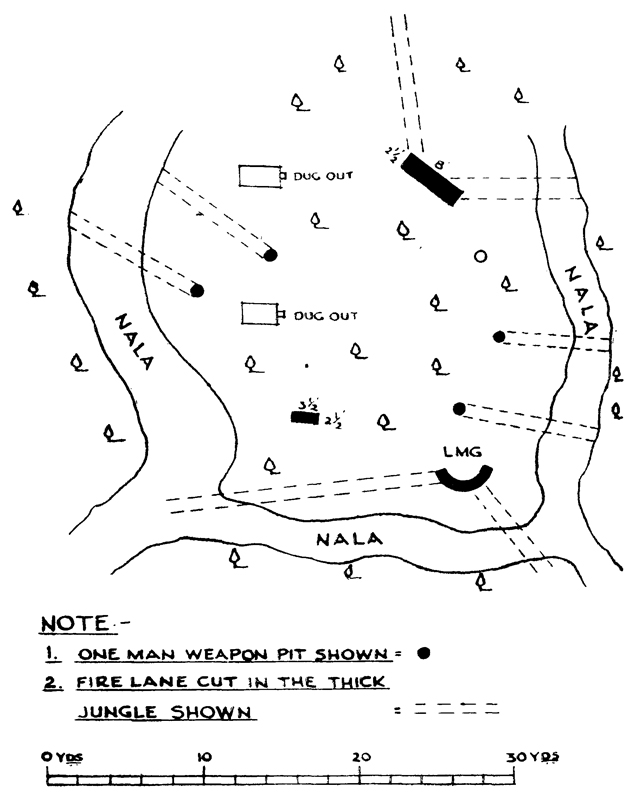
Example 4.
Site.—This is a common type of defended locality sited on a small hill. An - alternative (fox hole) type of hill defence is shown in Example 5. This locality was just north of the road on the extreme right flank of the position depicted in Example 7. Unlike all other localities in the area, this was wired with barbed and telegraph wire fixed to bamboo uprights 4 feet high. The trenches are depicted below as if they were clearly visible but in actual fact they were either completely covered over with branches or camouflaged by laying carefully cut turf on the parapet. The hill aide was oovered partly with grass and partly with shrubs.

Example 5.
This is an interesting example of a defended locality consisting almost entirely of unlinked weapon pits. It is possible that at least some of those on the hill have been linked by tunnels and that shelter from the shelling and aerial bombardment to which this position was frequently subjected, has been provided by burrowing deep into the hill side. This sketch was made from an aerial photograph and therefore only shows positions visible from the air, but it can safely be assumed that the line of weapon pits was continued under the trees on the south edge of the locality. It should be noted that in this drawing a black dot has been used to indicate both foxholes and M. G. positions.
This locality will be recognized as part of the battalion position given in Example 12.

Example 6.
Site.—This locality was dug on the forward edge of a village and is part of the position illustrated in Example 7. It was sited behind a bamboo fence along which grew trees, shrubs and cactus. It was well camouflaged and bushes and cactus were, as far as possible, left untouched. In front the field of fire was unlimited; behind, village buildings and trees obscured the view. This position contained no features of special interest.
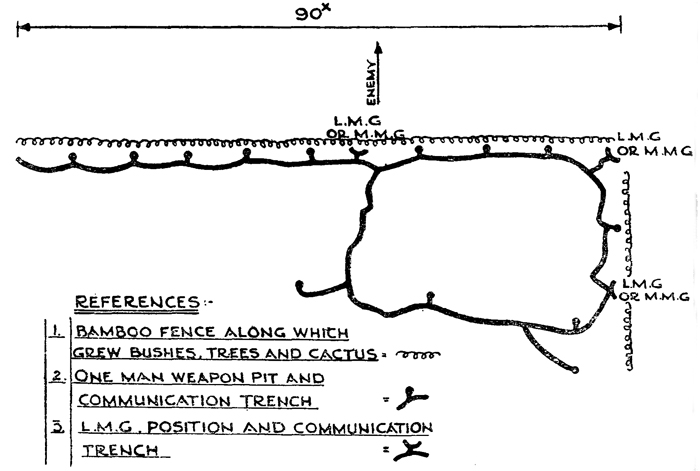
Example 7.
Site.—In the Arakan two miles East of Maungdaw. This position was sited on the forward edge of a village. All localities, except No. 1 and those dug on tanks, were dug behind the bamboo fence of the village ; along this fence grew cactus and numerous bushes and trees, which completely concealed the earthworks. Where overheaded cover was thin branches were thrown across the trenches. The M. M. G. sign used on the sketch below indicates M. G. positions, but it is not known which were L.M, Gs. and which M. M. Gs., also some of the positions shown (for examples 14 and 16) may have been alternative and thus unoccupied. Localities 1, 2, and 9 are shown in detail as Examples 4, 2, and 6 respectively. North and South of the river line the country is generally very open and 300 yds. is the minimum field of fire. Locality 14 consisted of unlinked fox-holes surrounding a small group of houses ; all other localities contained communication trenches.
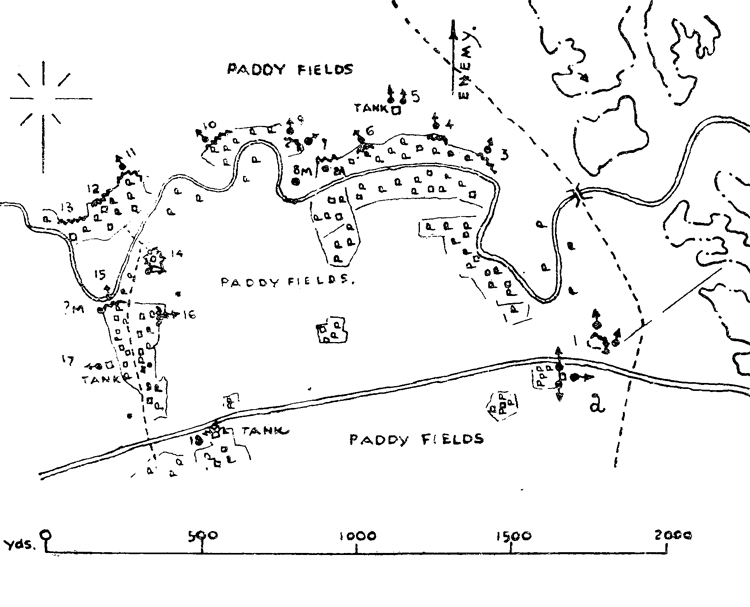
Example 8.
Site.—A beach in Burma. The diagram below shows in detail a typical beaefe defence position which the Japanese have constructed, and are still constructing in Burma. It is a trench system within wire defences.
The trench system consists of two groups enclosing irregular areas and' separated by a tidal creek. The trenches are approximately 5 feet wide at the top, and have-firing bays projecting outwards from them, thus affording an all-round field of fire. The trenches zig-zag irregularly, and the fire bays are spaced at interval's varying between 23 and 70 feet. There are about 66 bays, equally divided between the two groups.
The only defensive structure within the trench system is a pill box, about 10 feet square, within the northern of the two areas. Between this pill box and the river a large tree had been felled to obtain a clear line of sight.
A single line of wire, set on posts at approximately 10 feet intervals, enclosed the two trench systems on the north and south. On the landward side the tidal creek i& used as a boundary to the locality without wire defences along it.
Along the foreshore wire has been laid in double lines, 10 feet apart and in shallow zig-zags, joining at the north and south to the single lines of wire described in the preceding paragraph. A single line of wire in shallow zig zags continues the foreshore-defences northwards along a sandy beach for about 300 yards. The overall width of the defences enclosed by wire is about 600 yards ; its depth about 250 yard's.
A forward double line of wire runs northwards through shallow tidal water from the southern end of the double line on the foreshore for about 550 yards to a point 200 yards forward of the position.

Example 9.
Site.—Burma. The sketch below provides an interesting example of an all sound anti-tank obstacle, partly natural and partly made by digging a ditch. This drawing was made from an aerial photograph and it would appear that the position is still a long way from completion. In this case the preparation of a tank ditch ihas taken precedence over the digging of fire positions. The ditch is about 20 feet wide and about 7 ft. .deep ; spoil has been thrown out on both sides, making a small parapet. The ditdh is full of water.
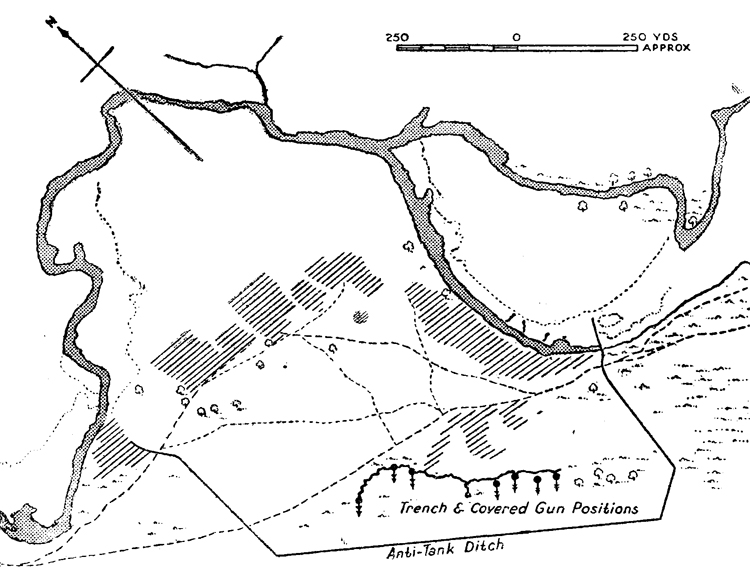
Example 10.
Site.—This position was dug in and around Buthedaung in the Arakan. A point of interest is the siting of localities outside the main line of F. D. Ls.; their apparent function was to hold the lines of approach as long as they could. One flank is resting on a good river obstacle and the Letwedet Chaung is being used as an obstacle for the front.
It is not possible to say which positions contained M. M. Gs. and which L. M. Gs., nor is it possible to estimate how many machine guns were in each locality. It is however worthy of note that out of the eighteen localities shown on the sketch as containing M. Gs., eleven contained well concealed M. G. nests, each for two M. Gs. (i.e., Localities 2, 4, 5, 7, 8, 9, 10, 11, 14, 15, 16). These nests were protected by a 3 feet thick timber, corrugated iron and earth roof ; inside they were six feet long, five feet broad and five feet high. On one of the 6 feet sides were two M. G. platforms revetted with bamboo, in front of each platform was a loop hole 1 foot wide giving two guns together an arc of fire of not more than 60°.
Localities 8, 9, 10 and 11 were linked by paths to form one position. The paths were cut on the rear slopes of the hills and tunnelled through the jungle so as to be invisible from the air. Localities 14, 15 and 16 were linked in the same way.
Locality 6 was sited on a hill covering an important approach to the position. It contained a M. G. nest, four open M. G. positions, and eight fox holes.
Locality 12 was constructed on a tank, as depicted in Example 2.
One man weapon pits unconnected by communication trenches predominated -i» this position.
Localities were mutually supporting.
Battalion Position at Buthedaung.
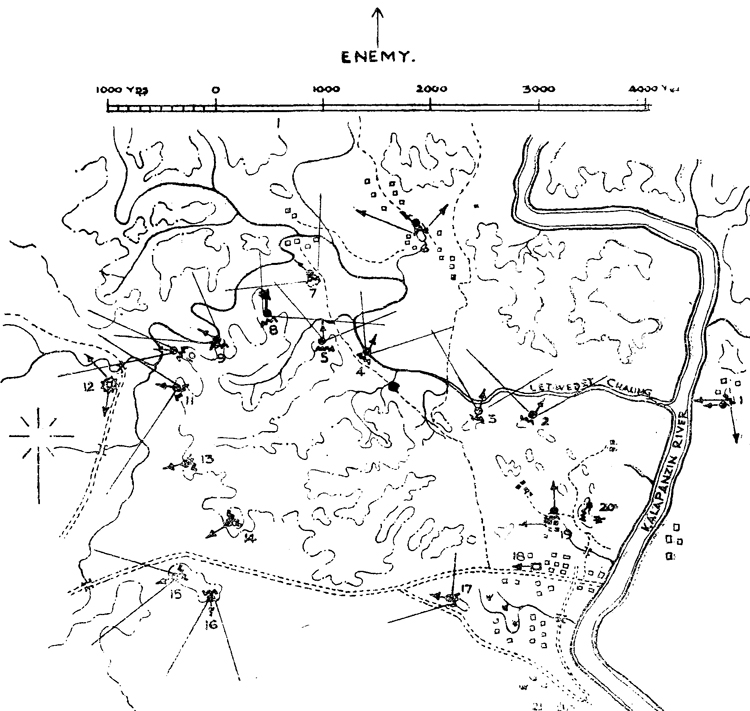
Example 11.
Site.—This illustrates enemy defences in Gona. Unfortunately there is little to indicate the strength of the force engaged, but the number of light machine guns (57) suggest the fire power of approximately six rifle/L. M. G. companies at full strength. The most southerly line suggests a company with two M. M. Gs., attached ; in marked contrast to company frontages in Burma it occupies a frontage of exactly 200 yards. It should be noticed that the right flank of this company rests on a creek and its left flank is fairly close to what appears to be a small marsh.
Sketch map enemy Defence Gona.
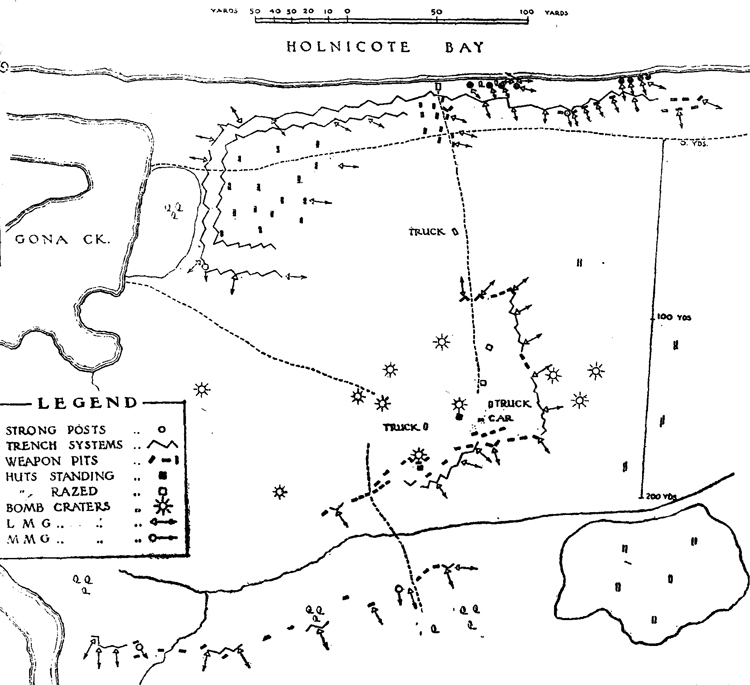
Example 12.
Site.—Rathedaung. Except in the case of the locality illustrated in Example 5 it is only possible to show this position generally. It is reproduced here because even without detail it gives some indication of the frontage and depth occupied by a battalion holding a defensive position amongst small thickly wooded hills. This position was held by the Japanese for some weeks and narrow flanking movements against it failed.
Forward localities were sited on the highest ground in the sector and organized for all round defence. Trenches in the most northerly localities were continuous.
Our own positions were North of those shown in the sketch map.

Example 13.
Site.—Buna village. This is another example of Japanese defence in the South West Pacific. Again flanks rest on natural obstacles, and the advanced posts 30 to 80 yards outside the main position should be noted. The defences in this position •consisted almost entirely of " bunkers ", the detailed construction of which is shown in Examples 14 and 15.

Example 14.
Strong points.—Strong points, as seen in Burma, fall into two types, both of which are illustrated below.
The Double Bay " Bunker ".—These are built in two sizes, 25 ft. by 15 ft. and 60 ft. by 40 ft. They consist of mounds of earth from 5 ft. to 12 ft. in height, with a rear entrance well recessed into the mound. Forward, a central, apparently solidr block projects to form two bays. These bays vary in size.
The smaller sized earthworks form part of the main trench system, with which they are linked, but the large " bunkers " appear to be isolated.
The single Bay " Bunker ".—This consists of a ronghly circular mound of earth about 25 ft. in diameter and 5 ft. high, with entrance at the rear opening on to a craw! trench or the main trench system. In front is a firing-slit on, or slightly above ground level, from 6 to 8 ft. long and about 1 ft. 6 in. to 2 ft. high. Inside there is presumably a timbered diig-out partly below ground level.
A typical beach defence position is illustrated in Example 8. It is in positions of this type that the " bunker " strong points have been seen.
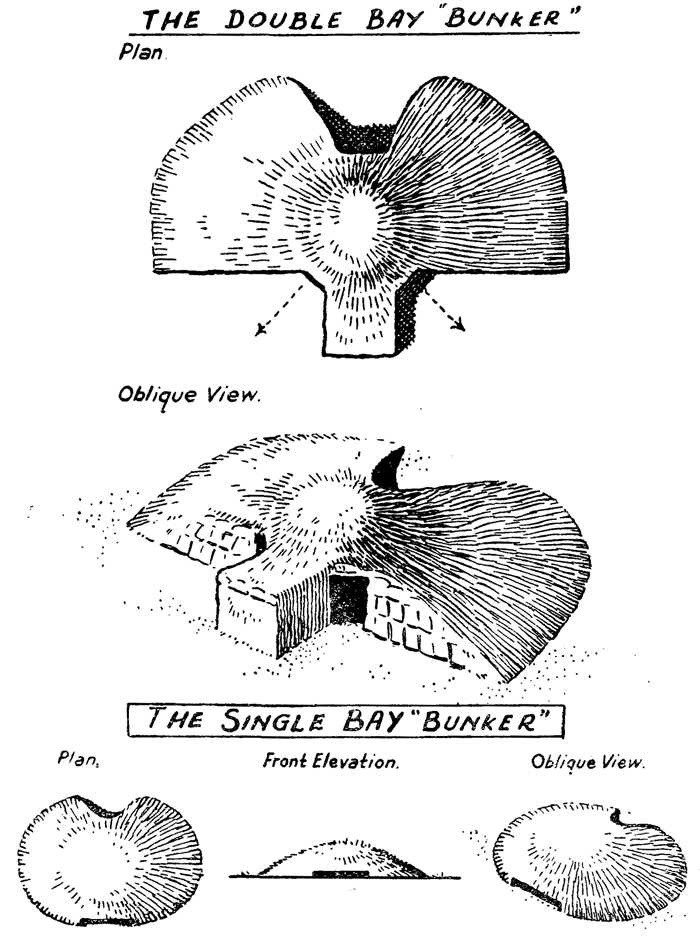
Example 15.
Earthworks in the South West Pacific Area.
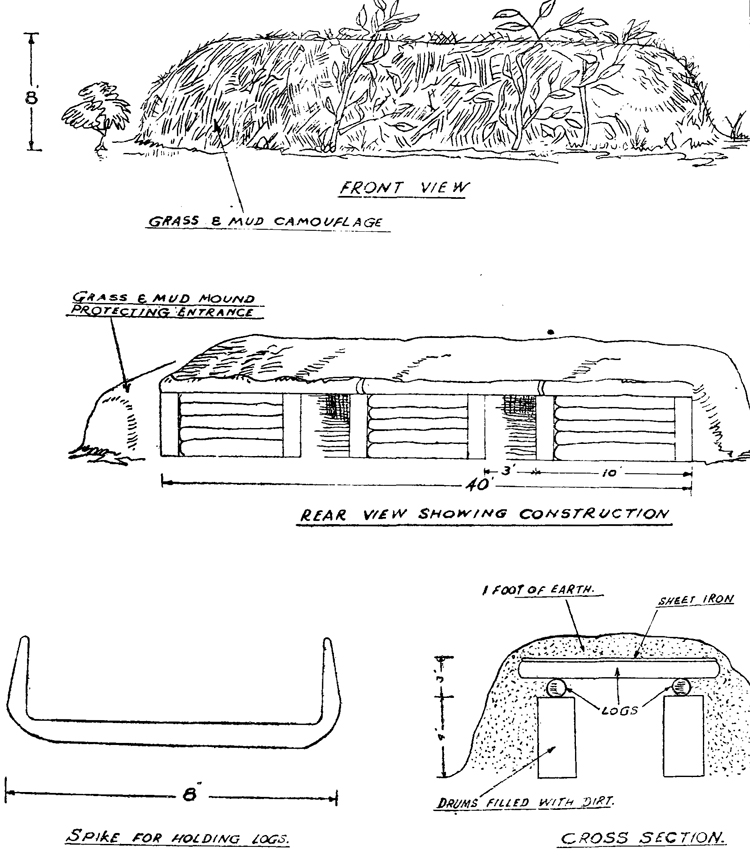
DETAILS OF BUNKERS-JAP DEFENCES—CAPE ENDAIADERE DEC. 42.
All dugouts and bunkers have had firing slits so small as to be invisible from the-front, and with heavy overhead cover made it impossible to reduce th.em with a frontal assault with infantry. It is therefore necessary either to secure a direct hit with artillery or to overrun or envelop them and attack from the rear.
JAPANESE SHELTERS & BUNKERS—CAPE ENDAIADERE AREA.
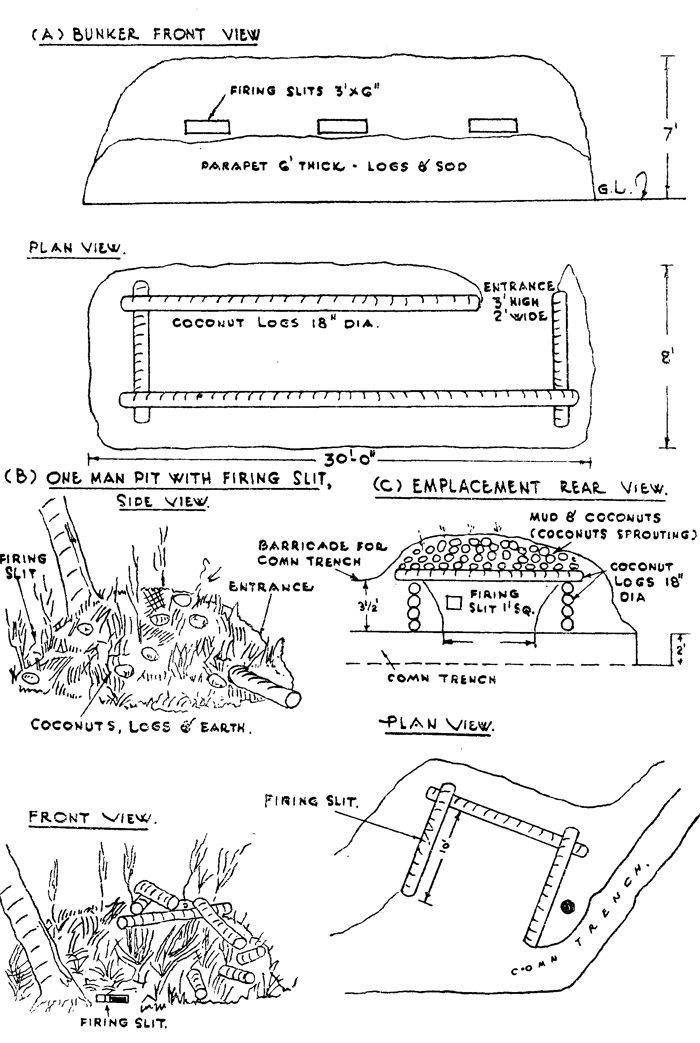
CONSTRUCTION DETAILS JAP EMPLACEMENTS—CAPE ENDAIADERE
DEC. 42.
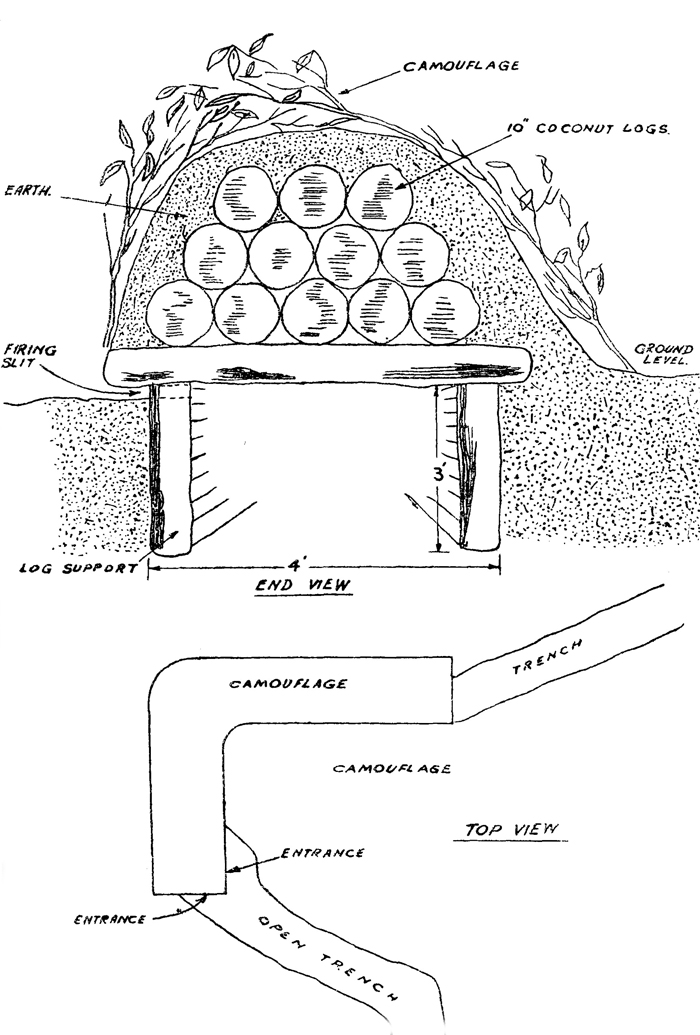
The angular plan of some of the dugouts made it impossible to eliminate all enemy resistance from one dugout by throwing in a grenade. There have been instances where this was apparently assumed, with the result that men who have actually got. nto the entrenchments, have been shot from behind.
5. Conduct of the defence.
17. Surprise is achieved by silence and concealment. Until attacked, troops occupying forward localities very seldom open fire even if the target offered is a good one, consequently it is rarely possible to pin-point their machine gun positions.
From a hill four or five hundred feet above an enemy company locality sited in ;an open plain, there is surprisingly little to be seen : no wire, nothing resembling trenches, and no movement. Here and there a few feet of obvious camouflage, perhaps a single hole showing in the bank of a nala, and that is all. On the defensive in the Arakan the enemy rarely initiated any movement himself during the hours of daylight. The complete still suggested that he slept during the day in order to reserve his energies for the night, when his patrols were invariably active.
18. Machine Guns.—Following normal practise the Japanese make the machine
gun the principle weapon of defence. Automatic weapons are sited to fire along prepared lines, lanes being cut in the jungle if necessary. Medium machine guns are
sited well forward and are generally sub-allotted to platoon localities, they are often
to be found on high features or dug into the banks of tanks, they are also sited to cover
the main lines of approach. They are often sited singly and are invariably provided
with alternative positions. An important point to remember is that during the defensive battle M. M. Gs. sometimes fire along a line about ten yards from the forward
edge of Japanese F. D. Ls., and assaulting troops, if unprotected by smoke or darkness, may therefore suffer heavy casualties just in front of the enemy position, particularly if they have got bunched in converging on to the objective.
19. Mortars and Grenade Dischargers.—In the defence, mortars and grenade dischargers come next in importance to the machine gun. Mortars of 3 inch or larger calibre may be allotted to rifle companies at the scale of one per company, but the weapon most frequently used by forward units is the 2 inch grenade discharger of which there are three in each platoon. This is a rifled weapon which throws a small shell 700 yards. Once an attack is launched mortar and grenade discharger shelling is frequently directed on areas which cannot be reached by flat trajectory weapons. Particular attention is paid to probable lines of approach and likely forming up places.
20. Snipers.—The extent to which snipers are employed varies greatly with each front. The minimum effort is made by one or two snipers covering paths between our own localities, and the maximum effort, which was experienced in the South West Pacific Area, is a large number of snipers left behind by troops who advance and then fall back. Although sniping varies a great deal in intensity there are certain places where snipers posts may be expected—
(i) above small advanced positions, (ii) on the flanks of localities,(iii) covering lines of approach to the Japanese positions, (iv) covering paths in our own area, (v) covering gaps made in our telephone cables (this has been reported once).
21. Patrols vary in strength from one N. C. O. and three men to an officer with eighteen or more other ranks. They are active every night and their tasks vary from drawing fire in order to discover our positions, to determined raids in which the assault often comes in from a direction opposite to that in which crackers, red tracer and auto matics have been fired. In one instance in Burma this year a patrol crept up to a section post without being seen or heard, they then rushed the post the garrison of which was taken completely by surprise and overwhelmed. Finally as an example of patrol activity at night the practise of infiltrating between localities held by troops new to a sector, must be mentioned : the object in this case is to get localities in a difficult sector (for example in close hilly country) to engage each other. In this they have occasionally been successful.
In the South West Pacific daylight patrols of six to ten men have also been met, while a document recently captured in Burma detailed a party consisting of a cadet, a serjeant, and five soldiers (including one nursing orderly) for a patrol which was to carry provisions for four days.
22. Artillery.—Up to the time of going to press little use has been made of artillery in the defence. Where it has been employed against us, its activities have been confined mainly to counter battery work and it is interesting to note that artillery has not been employed against attacking troops. In future operations, however, artillery must be expected. The 37 mm. anti-tank gun has been in action against our tanks. This was sited in a foremost defended area, and carefully concealed in a nala.
23. Battle.—From the Japanese point of view, the defensive battle begins only
when the assaulting troops are too close to be missed by their light and medium
-machine guns. Carefully concealed M. G. positions then come to life, and now, when
the assaulting troops are too close to the objective to receive additional.support from
artillery, M. M. Gs. and mortars, they are, if unprotected by smoke or darkness,
met by accurate and heavy concentrations of machine gun fire. If they are assaulting
up a hill to this is added showers of grenades, and any L. M. G. detachments who stop
to lie down and fire at short range from exposed positions are engaged by grenade
discharger shell and light machine gun fire.
The Japanese tunnel into hill sides and build dugouts which afford adequate protection against all but a direct hit from a field gun. Well built earthworks often render his destruction by the normal supporting weapons impossible. Supporting fire shakes him and makes him keep his head down, but if the assault does not go in with all possible speed after the supporting fire has lifted he is quick to seize the momentary advantage which slow troops may give him, with the result outlined above.
24. Counter-attacks.—The Japanese launch immediate counter-attacks against troops who have captured part of a locality. These small local counter-attacks may be made by only a dozen men led by an officer ; they are preceded by a shower of grenade discharger shells and the charge is made with automatic weapons. This immediate counter-attack may be launched five to ten minutes after the locality has been penetrated. A wild war cry, to which is sometimes added the shout " Charge !" m English, gives warning of what is impending.
6. Examples of the defensive battle.
Example 1.
The Japanese sited a foremost defended locality on the hill illustrated below. All earthworks were carefully camouflaged and had it not been for sentries in our own foremost positions, about fifty yards down the left slope of the hill, hearing the Japanese talk at night, it would not have been possible to say definitely that they were there.
Reconnaissance parties, exposing themselves boldly on a ridge facing this position and 400 yards from it, were never fired upon, and many rounds of 3 inch mortar bombs were fired into it without producing any reaction.
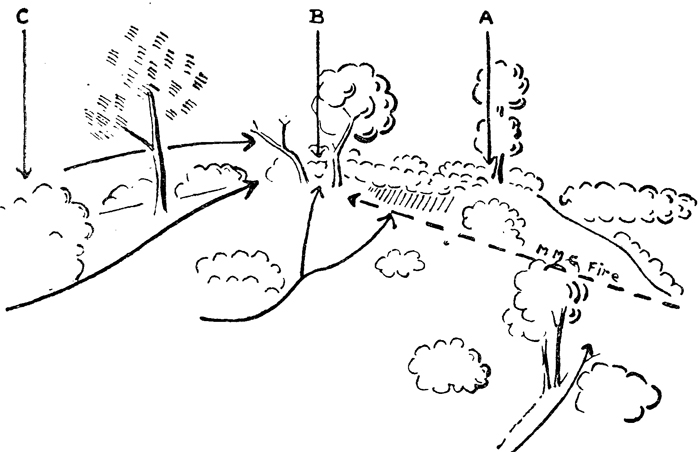
The general line A-B was nearest to the point of observation, the position, however, continued on the right of A following the high ground which curved back slightly.. It also receded behind B following the highest contour.
The post around A-B was probably held by a platoon as part of a company holding the main hill of which this feature was only a part.
The information then, available to the attacking troops, was that there were some enemy on the hill who had never been seen. They had been heard to talk at night and they were believed to consist at the very outside, of one platoon.
After an intensive mortar bombardment one company launched an attack up< both sides of the spur from C. The black arrows indicate approximately the line of advance of the main assaulting parties.
The leading assaulting troops made good progress until they were about 30 yards1 from the general line A-B ; then a veritable hurricane of fire was let loose upon them. They were engaged by L. M. G. fire and grenade discharger shell and began for the first time to suffer appreciable casualties. Shouting then* war cries they continued to-climb the hill, making use of such meagre cover as the small bushes and folds in the ground offered. As the action grew in intensity camouflage began to slip off the parapet of what could now be identified as a continuous trench, part of which ran along the front A-B. When the foremost troops were about ten yards from the parapet, they were subjected to accurate M. M. G. fire from a gun sited in another locality. Although greatly weakened by casualties they continued to advance and, led by their Company Commander who hurled grenade after grenade into the Japanese position, they finally stormed and occupied the trench, killing or driving out all Japanese in that part of the locality.
About ten minutes later there was a wild howl, as of jackals and hyenas; a shower of grenade discharger shells fell amongst our troops, and with shouts of " Charge ! " the Japanese counter-attacked with automatic weapons, forcing our troops off the hill again.
DISCUSSION.
This company battle serves as a vivid example of Japanese method in the defence. Their positions were well concealed and nothing tempted them to give them away ; thus at zero hour the attackers could be certain neither of the extent of the position nor the strength in which it was held. They had heard Japanese talking in this area at night and with the Japanese predilection for commanding ground they could reasonably be expected to have a defended locality there.
Fire was held till the attackers were thirty yards and less away, and not until they were ten yards from the parapet were they engaged by a medium machine gun in a neighbouring locality. This is a common Japanese method of achieving surprise in the defence.
Finally success which was not reinforced was turned to failure by a small but determined local counter-attack. The immediate counter-attack is a common, but not invariable feature. There have been cases in which captured localities have been made untenable by fire alone.
Example 2.
(See sketch maps.)
The following brief account of an attack made by a British Brigade in March 1943 against a strong Japanese defensive position in Burma, on the Mayu Peninsular North of Donbaik, serves as a classic example of Japanese defensive tactics.
The plan for the attack was divided into four phases :—
Phase 1. 0545 hours A. Bn. to capture the Eastern half of the Chaung as far West as Ml6.
Phase 2,—0645 hours B. Bn. to capture the jungle area as far as line marked " A ".
Phase 3.—0710 hours C. Bn. to extend their position on Twin Knobs to as far South as the line marked " B ".
Phase 4.—0850 hours B. Bn. to exploit to line marked " C ".
Supporting Arms.—Artillery and M. M. Gs. supported the attack with a barrage and concentrations.

The Japanese position.—(See sketch map below).—The Chaung itself is a strong aatural obstacle, which the Japanese made into an excellent defensive position, by building an intricate system of communicating weapon pits and strong points, and at least one pill-box (S5). All posts were mutually supporting.
The pill-box, which consisted of an outer covered weapon pit, and an inner chamber which is reported to have had both metal and concrete incorporated in its structure, was sufficiently well constructed to withstand no less than three direct hits from a 3 -7" howr. at point-blank range. It follows, therefore, that assaulting troops on and around the pill-box could be subjected to heavy mortar fire without any dstri-mental effects to the occupants.

All other works were dug well down and presumably provided with dug-outs, for although approximately 124 tons of shell were fired into the Chaung area immediately prior to the attack, there was no indication that the enemy's fire power had been-impaired.
The Chaung is overlooked from the East by two commanding features, Hills 823 and 500. These are both steep and densely wooded. Although no weapons were pin-pointed on these features, mortars, M. M. Gs. and at least two 7 *5 cm. mountain guns undoubtedly fired from there. These weapons could thus put dowra defensive fire anywhere in the area, by day, by night, or through smoke.
Unlike other Japanese defensive positions, the posts, weapon pits and fox holes,, in and about the Chaung were clearly visible from the air and in many cases could be-seen from O. Ps. This does not mean that any movement or weapons were visible^ but it was possible to discern where earthworks have been dug. However, in the jungle and on the hills 823 and 500 positions were so well concealed that with the exception of the two strong points which held up B and C battalions they remained undiscovered to the end of the battle.
Course of the Battle.—A. Bn. commenced their advance without appreciable opposition, but soon the company attacking the Chaung from the North experienced the now familiar Japanese tactics of withholding their fire until the last moment, and it was not until they were traversing low loose strands of wire, about 15 yards from S4 and S5 that intense fire was brought to bear on them. These two posts were attacked repeatedly, but without success ; our troops could find no opening through which to throw grenades and whilst on and about these posts they were subjected to> mortar fire to which the posts themselves were immune. The other two companies were more fortunate, and although they were subjected to showers of grenade discharger shells and hand grenades whilst advancing down the Chaung, succeeded int taking their objective, which was up to inclusive M16. A proportion of these troops advanced up the small Chaung and cleared it as far as S4 where they in their turn were held up. As the light improved, and as presumably the Japanese realised the-position, showers of projectiles from all weapons were fired into and around the-Chaung, and M. M. Gs. opened up from the flanks.
Meanwhile Phase 2 began and B. Bn. advanced only to be held up ?; what was> described as a Strong Point similar to S5 (M52 on the Sketch). B. Bn. were unable to reduce this post and were subsequently withdrawn.
Phase 3 commenced according to plan, but C. Bn. almost immediately suffered the same experience as B. Bn, in that they ran into a cunningly concealed M. M. G. Post just beyond the start line. This post was so well hidden, that it escaped notice when the area was reconnoitered prior to the attack. This Post also held out.
DISCUSSION.
The attack failed through no lack of courage ; the dash and daring of the attackers has been aptly described as an epic of collective gallantry. Why then did the defence succeed ? There are important reasons—
Following his normal practice the Japanese held his fire until the assaulting troops were almost upon him; only then did his machine gun nests come to life— machine gun nests about the strength or existence of which we knew little or nothing. To quote from our own defence pamphlet " The main task of medium machine guns will be to take toll of enemy unarmoured troops " and no M. M. G. is better sited to fulfil this role than one in an undetected nest with a big enough covering of earth, timber, and perhaps steel and concrete, to withstand the preliminary bombardment. In fact by continually improving their positions and by careful attention to camouflage the enemy had achieved surprise in the defence.
Strong posts which could withstand the fire of our artillery could also withstand the fire of Japanese mortars which gave additional protection to their garrisons.
The first and chief problem then, which the Japanese defensive position presents, is the problem which has faced every modern army for more than 25 years—it is the detection and neutralization of the machine gun firing from a well built nest.
It will be noticed that no counter attack was launched in this battle, elements which had penetrated being dealt with by intensive mortar and grenade discharger shell fire alone. This practice of bringing down defensive fire on ones own position is likely to be a common feature of Japanese defensive tactics. In fact either by immediate fire or immediate counter attack the Japanese will attempt to make an over-run locality untenable.
7. As others see us—British attacking Japanese defending. (Translation of a captured Japanese document.)
1. They are generally cautious in attacking and in planned attacks they have a
tendency to use positional warfare and make exhaustive reconnaissance preparations.
We should strengthen our position more and more while they are getting ready, and
at the same time, by stratagem, try to take the offensive.
2. In attack, they endeavour to encircle or break through. However, as they are cautious when carrying out an encirclement, we should strive to utilize our manoeuvrability, further encircle the enemy's encircling force, and fight a decisive action at a point where the enemy does not expect it.
Do not use a passive defence if you can help it, as it has the disadvantage of making it easy for the British to build up their strong firepower. On the defensive, choose a position where the front line will not be under the enemy's fire.
3. Although they realize the necessity of a charge, particularly in gaining the final decision in a conflict, they do not concern themselves much about its strength, but rather strengthen their firepower and their positions. The Infantry weapons for hand to hand fighting are few and automatic weapons are many. The infantry just follow the curtain of fire and occupy the ground. For this reason, it is necessary to plan to split them by means of artillery and machine gun fire and isolate the infantry. Then by taking advantage of a good opportunity, we can counter-attack. It is necessary to carry the battle out of the area selected by him so as to not come under the concentrated fire of the enemy artillery, to prevent his pouring fire on the charging infantry.
It is specially necessary when our forces are weak, to rely on the bayonet against the enemy troops who penetrate our positions and to be prepared to drive them back by this means in the final melee.
4. They are also over-cautious in selecting the main objective of their attack in a
meeting engagement and ordinarily do so after the battle has begun and they have
detailed reports of the enemy's dispositions and strength. For this reason, it is
essential to bring about, by swift and resolute action, a decisive battle before the
enemy's preparations are completed.
CHAPTER IV.—A.A. DEFENCES
1. General.
1. Almost all the available information on Japanese Anti-aircraft defences has been obtained by photographic reconnaissance, literally from a bird's eye view.
2. It should always be borne in mind that the Japanese are prepared to use their anti-aircraft artillery in any role which it can conveniently fulfil and A.A. guns may be sited to engage ground troops as well as attacking aircraft.
2. Equipment.
3. Generally speaking Japanese A.A. equipment so far identified is about as good as our own was fifteen years ago. A.A. regiments are equipped either with the 105 mm. A.A. gun or else with the 75 mm. A.A. gun. Of the former very few have been identified and little is known of their performance. Several models of the 75 mm. have been produced and both static and mobile versions are employed. The A.A. performance of these guns is not outstanding and it is unlikely that their effect against ground targets will be much better than that of the ordinary 75 mm. or 105 mm. field gun, though an increased range can be expected. Their greater muzzle velocity, however, is likely to make them better anti-tank guns, though because of their size, very vulnerable. Though it is probable, it is not definitely established that they are equipped with A.P. shot as well as H. E.
4. In the light A.A. category, they are believed to have two standard weapons,
the 20 mm. Oerlikon gun and the 0.5 in. heavy machine gun.
The former is an oldish gun, and though reasonably effective, is not likely to compare with modern 20 mm. equipments. A triple barrelled model, which is a logical development of the single barrel gun, has been captured recently.
The latter is possible a ground adaption of the Vickers 0.5 in. aircraft gun. Both these guns fire H. E., Tracer, Incendiary and A.P. ammunition and are likely to be sited so that their versatility can be fully exploited in the defence.
5. To this list must be added captured equipment; its extensive and effective use is only to be expected.
6. Not a great deal is known about their fire control system but the following
types of equipment are probably in use.
Fuze Setter.—Both the 105 mm. and 75 mm. guns are believed to have an automatic fuze setter worked mechanically from the range scale drum.
Height finder.—3 metre base of conventional type.
Sound locators.—Photographs of two types have been seen. One appears to be a small conventional trumpet type, the other a large vane type. No details are known.
Data Computer.—Information received on these instruments distinguishes them from " directors " as made familiar by Vickers and other instruments. It appears the range is announced by the battery commander and the word computer is used to translate the Japanese nomenclature. It would appear that it is used only for elevation and corrections in the azimuth and seems to be a limited application of the idea of mechanical computation and electrical control. Its accuracy is entirely dependent on the accuracy of the. data supplied to it.
3. Organization.
7. The following organization is compiled from documents captured in the South West Pacific Area :—
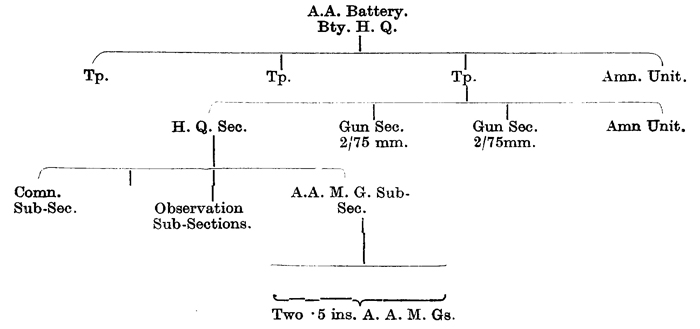
4. Tactics and Layouts.
8. Except in China where they met no air opposition worth speaking of, the Japanese have not fought hi country where it is either profitable or possible to employ mechanised forces. Consequently their employment of A. A. in attack or defence in open warfare is still unknown. Reports indicate that they had their A.A. well forward in the Malayan campaign possibly copying the Germans in the battle of France.
9. On static defence however we have a better knowledge of their tactics.
On several airfields in Burma the A.A. guns have been sited with a view to ground defence and in some cases gun positions have been co-ordinated in a trench system. In several cases the guns were raised above ground level presumably to gain a better field of fire. The illustration below shows these tendencies.
In all cases it seems certain that all guns can fire at least down to zero elevation and probably below.
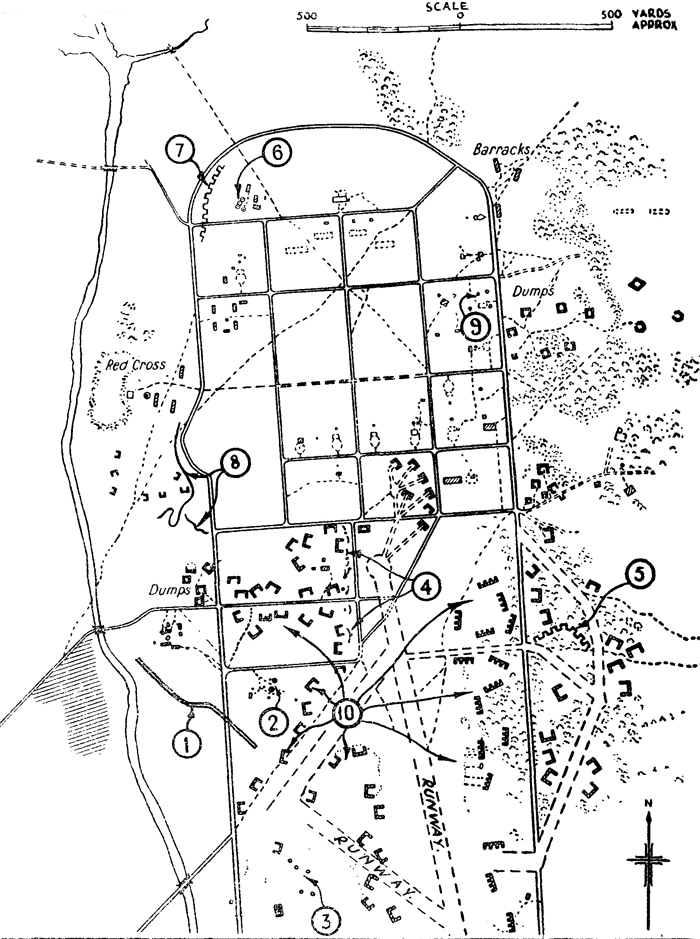
1. Ditch—probably intended as A/Tk. but never completed.
2. Raised emplacements for dual purpose light AA/AT7 guns. (Possibly the 20 mm. Oerlikon)
3. Light A.A. site or L.M.G. emplacements.
4. Small trench systems or weapon pits.
5. Small trench—incomplete.
fl. Site for Heavy A.A. Battery.
7. Shallow Trench.
8. Narrow ditch and earthworks built in conjunction with natural obstacles.
9. L. M. G. positions.
10. Dispersal Bays—These are blast walla for aircraft protection.
Example 2,
11. Originally all guns were sited close to runways and in some oases this practice has been continued. There are two disadvantages to this: firstly when the guns are close to the vital point (V- P.) they engage the enemy aircraft with maximum fire density after it has released its %ombs; secondly the angle at which the aircraft is to the guns approaches 90° as the aircraft gets closer. Recently it has become apparent that the Japanese realize the importance of engaging aircraft early and are siting their guns in suitable positions to do this. They nevertheless appear to attach great importance to the possibility of low-flying and even air-landing attacks on airfields and this might account for their original aim of siting all guns ito cover the runway. The diagram below shows very clearly the outwards movement of defences. All the positions which are now occupied are those on the perimeter while those on islhe airfield itself, the first to be built are now empty.
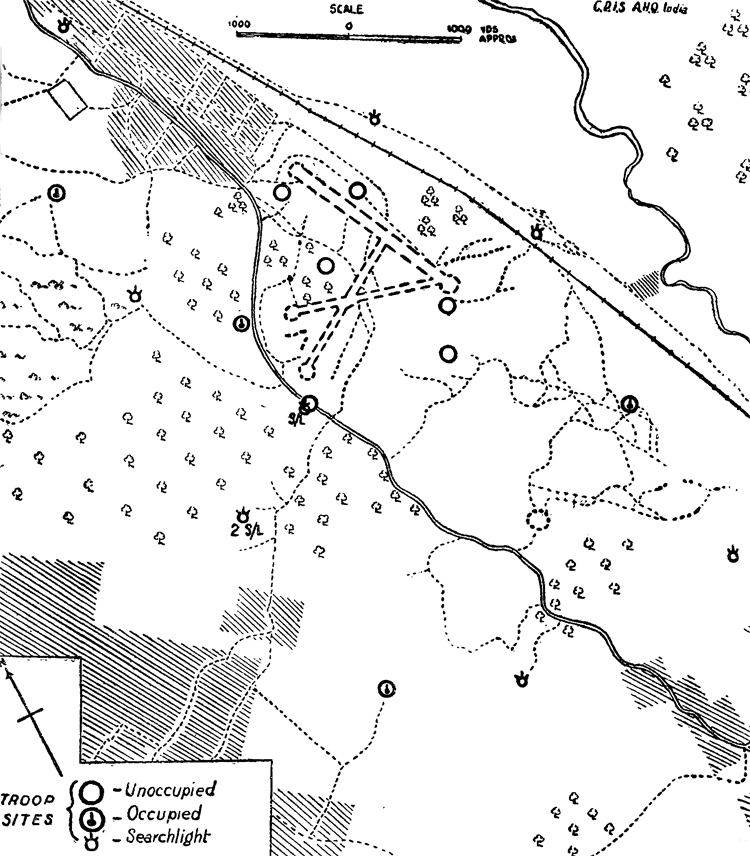
Formerly an attempt was made to cover the airfield with the guns by direct fire. This is less frequent now, but light guns usually have an excellent field of fire over the runway.
12. Usually A.A. defenses are sited on either side of, in a triangle or in a ring around the V.P., depending on the number of troops available for defence. Only in the more recently constructed positions is an effort made to prevent attacking aircraft from actually reaching their objective.
Below is a diagram showing the layout of the A.A. defences of a V.P. and area which have recently become more important to the Japanese. It illustrates the present trend in layout of A.A. defences.
Example 3.

NOTES.—1. The V. P. is in this case, a road and rail bridge.
2. The numbers on the diagram indicate troop areas, not all of which are necessarily occupied at any one time.
13. Troop layout.—The diagram given below illustrates a typical troop layout as seen from air photographs taken over Burma.
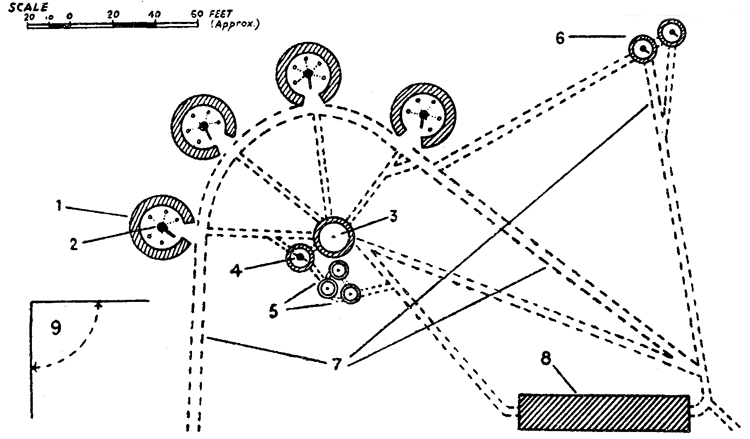
NOTES.—1. Built up emplacements, internal diameter 18 to 22 ft. Walls 5 or 6 ft. thick.
2. 75 mm. Mobile A. A. gun.
3. Command post, usually about 12 ft. internal diameter.
4. Height finder in emplacement about 6 ft, internal diameter.
5. Very small emplacements seen in the vicinity of the Command post.
6. Machine gun emplacements for local defence. Usually 2 to 4 emplacements, internal
diameter 8 to 10 ft.
7. Lack of track discipline—often discloses position of site.
8. A hut to accommodate the crew is sometimes seen near the site.
9. If the site is in the vicinity of an airfield, the field is often from 500 to 2,000 yards away
within this arc.
The control pits (of which there are usually two or more) differ from those constructed by us since we favour one pit for all instruments. The Japanese prefer to accommodate them each in a different pit.
The shape of the actual gun emplacement has varied during the Japanese occupation of Burma. Immediately after their occupation varying designs were in evidence but laterly the type of emplacement has been standardized and the type shown in the diagram above is now far the most common.
The walls of the emplacement are believed made of mud with bamboo insert for strengthening them. Sand bag construction does not appear to be used.
5. Conclusions.
14. From the information available it would appear that the Japanese have not yet established any definite iLA. organization. In this chapter an attempt has been made to indicate trends in both organization and tactics, but remembering that our chief source of information is photographs and observations made from the wrong end of the A.A. gun we must maintain an open mind and be prepared for tactical and material surprises.
CHAPTER V.—THE ADVANCE TO CONTACT.
1. General.
1. A force advancing is preceded by advanced guards the major .tasks of which are to gain information, brush aside minor opposition and, when the main enemy force is encountered, to give the main body time to deploy and envelop rt In order to fulfil these tasks Japanese covering troops employ the methods witnessed in Poland and France in 1939 and 1940, advancing with speed on the broadest possible front.
The speed with which the advance is conducted cannot be over-emphasized, and it is important to note that the commonest reaction to first contact is ivide envelopment.
2. Reconnoitering and Striking Elements.
2. Provided the terrain permits the use of transport, the several parallel columns are preceded by small parties of troops on cycles or in lorries, and possibly accompanied by one or two tanks or armoured cars which cover their deployment on first contact. These leading elements are particularly vulnerable to ambush and a formation often employed by them consists of four to five cyclists followed at a distance of some hundreds of yards by a group of about sixty more. These small parties are really no more than reconnoitering elements whose task on first contact is to move forward on foot in order to discover the strength of the opposition and the extent of the front occupied.
3. Behind them come either what may well be termed main guards, or the main body itself. Main Guards are strong in infantry, normally include artillery or mortars and are provided with engineers to clear obstacles. Also they will probably be accompanied by tanks or armoured cars.
3. First Contact.
4. On making contact the leading elements extend on both flanks, shouting, firing and employing any other ruses calculated to make the defenders open fire and disclose their positions. They also site a machine gun to fire down the road or track on which they have been held up. This gun is carefully sited and protected and difficult to dislodge.
5. If possible the leading elements infiltrate, and once behind the forces opposing them they fire crackers and automatic weapons in order to give the impression that they have, in large numbers, encircled their opponents.
6. If the advanced elements are not able to infiltrate they take up a position astride the road and, supported by machine guns and mortars, endeavour to pin the opposition.
4. Demonstrations.
7. A report from the South West Pacific gives a vivid description of some of the ruses employed by leading elements in order to entice the enemy to open fire :
" Demonstrations are designed to encourage the opposition to reveal themselves by premature opening of fire or movement. On one occasion the pinning elements made feint dashes to cross a bridge which our troops were covering. They were too fast to be in danger, but an immediate reply awaited our own troops who opened fire. Instances have occurred where Japanese have crawled forward to covered positions close up to our F.D.Ls., and, in English, called upon specifically named persons to reveal themselves or come forward. Such methods are obviously those of special troops who speak English well, have little thought for our intelligence and have studied a little psychology. At other times, too obviously loud chatter has been heard in localities on our flanks. Rustling and shaking of bushes is another ruse fco entice nervous firing and movement."
5. The encounter battle.
8. It would appear from the speed with which the battle develops that the heading elements are in close communication with the forces following them, and small wireless sets have been reported with the advanced elements. They are said to be strapped to the chest.
9. It is apparent from the short time between the first contact and first attack that some units are committed to an enveloping role from the earliest stages and the outflanking of the opposition begins almost simultaneously with the holding up of the foremost elements. Pressure is maintained frontally whilst the flank attack or attacks proceed. As the opposition stiffens the normal attack develops, and this is discussed in the next Chapter.
10. In conclusion the reader is reminded that speed, infiltration, early envelop ment and an unlimited advance are the aims of every Japanese Commander in this type of operation.
CHAPTER VI.—OFFENSIVE TACTICS.
" The English Army possesses mechanical mobility but lacks manoeuvrability therefore a quick deeisive battle should be sought by outflanking and encirclement."
Japanese dictum.
1. General.
1. Japanese methods of attack have often been described and all available information on this subject is summarized in Sections 3 and 4 of this Chapter. There are, however, certain features of envelopment, as distinct from actual attack, which will have important bearing on any operations in which we are forced on the defensive, and these are discussed in the next Section.
2. Section 5 is devoted to a study of the application to operations in the Arakan of the mobile warfare methods described in this Chapter.
2. Envelopment.
3. In the past envelopment in Japanese tactics has always been closely identified with attack. Whilst attack by single or double envelopment is undoubtedly attempted, a study of Japanese offensive operations indicates that envelopment may be an end in itself; in fact by placing bodies of troops across their L. of C. the Japanese compel their opponents either to attack them or withdraw. 4. Japanese strategy and major tactics in the offence against well equipped forces offer the defender two alternatives—to attack the Japanese often on ground favourable to the defence, or to give up ground. In the first Burma Campaign, from the time that the Japanese crossed the Salween River at Moulmein until the last action at Shwegyin on the Chindwin there are very few recorded instances of deliberate attacks. Rather was their superior mobility used to force us to attack troops who had succeeded in occupying a position behind us. They chose an area on the L. of C. to hold which would cause us the maximum embarrassment and the focal point of the battle which ensued was often a road block. Infact the Japanese fought defensively in country peculiarly suited to the defence. One big exception to this method during the first Burma Campaign was an attack launched against one of our Brigades at Kyaukse ; here the Japanese suffered considerable losses and the attack failed completely.
3. Attack in mobile warfare.
5. Reconnaissance.—Attacks are preceded by careful reconnaissance in which various ruses are employed in order to discover the location and extent of enemy localities. Trees are shaken in order to draw fire, defending troops are addressed in their own language in the hope that they will respond and small parties are used as bait for enemy fire. Finally if cover permits, scouts may be left in observation for long periods close to the enemy foremost defended localities.
6. Methods of attach.—Attacks may take the form of single or double envelop ment or frontal assaults. Zero hour is often any time from midnight to first light. Between 0300 and 0400 hrs. has recently (April 1943) been a common Zero hour (Night attacks are dealt with in Chapter VII).
7. The enveloping or flank attach.—Pressure is exerted frontally while the main effort is made around one or both flanks. Attacks of this nature often involve a double envelopment, a small flanking attack being made with an objective one to three thousand yards behind the enemy F. D. Ls., whilst a further turning move ment is made some miles behind them. This double attack has sometimes been described as two thrusts—one made against Brigade H. Q. and the other against Divisional H. Q.
8. The frontal attack.—Whilst in Malaya and Burma we have chiefly experienced the attack by envelopment, the Americans report that in the South West Pacific Area frontal attacks has often been made, particularly when an operation demanding more time might have given the defenders the opportunity to improve their positions.
Before a frontal attack, every effort is made by reconnaissance and ruses to locate a soft spot. Against this is directed the main effort of the attack, the object of which is to achieve a break through.
Forward troops infiltrate, taking advantage of all available cover to creep forward. This is in the nature of a battle reconnaissance which goes to ground when >held up by the defenders fire but brings light machine gun and mortar fire to bear on any positions it has discovered.
If the attack on the chosen sector does not succeed it is not uncommon for the anain effort to be directed temporarily against another part of the front, the old axis ibeing reverted to later.
9. The artillery available for the support of a Japanese division in the attack:
in mobile operations has, by Western standards, so far been inadequate, and this
weakness may account both for frontal attacks being launched without covering
fire and for the epithets of " rash and costly " with which an American commentator describes them.
The fire of artillery so far met in mobile warfare—and this was largely artillery from the Infantry Regimental Gun Company—was chiefly directed against our own gun positions. Such counter-battery work in the Arakan has so far been inaccurate and therefore ineffective. Given sufficient data formation and unit headquarters are also engaged.
4. Attack against a fortified position.
10. No fresh information has been received regarding Japanese methods of attack on fixed defences and the information published in October 1942 is therefore reproduced below. In the absence of more detailed information it is safe to assume that Japanese methods will be similar to those employed by the Germans.
11. The predominant considerations in an attack on a fortified position are surprise, preparation and concentration. The Japanese ability to achieve surprise extends to all forms of warfare and has already been discussed in Chapter I. Their preparations for an attack of this nature are extremely thorough and in the case of Hong Kong may be said to have extended over a number of years. Where possible consular staffs, spies, and even officers and men in disguise have been employed in peace time to make accurate and comprehensive surveys of fixed defences and vital communications, while fifth columnists are employed for the same purpose in; war. Besides the study of defences and communications preparation includes the accumulation of engineer stores of suitable size to bridge probable demolitions and the selection and training of special assault troops who have been chosen for their high intelligence.
12. They have been quick to profit by German methods and German experience and to realize that daring and highly skilled assault troops will succeed where no amount of massed infantry will avail.
13. The operation begins with heavy air attacks on aerodromes, anti-aircraft gun positions and headquarters. Later high level and dive bombing is directed against fortifications.
14. A heavy preponderence of artillery is employed and mobile medium artillery (105 mm.) firing armour piercing shells is used against splinter proof shelters.
15. The technique of the assault is ably described by an officer who was in the battle of Hong Kong :—
Numbers of assault troops would infiltrate through our lines under cover of darkness, and would hide in trees and bushes whence they would snipe our troops from the rear.
The position to be attacked would be subjected to very heavy dive-bombing and artillery fire during the day.
Assault troops in parties of ten would stalk the position, making such good use of ground and cover that they were rarely seen. The position, meanwhile,would be subjected to intense mortar fire, and fire from 0.5 inch machine guns to penetrate the iron doors and windows of concrete shelters and pillboxes.
When all parties of assault troops were in position in the dark, the mortar fire would suddenly increase. Then the parties of assault troops would rally, and assault the position, throwing hand grenades and firing Tommy* guns, and at the same time receiving supporting fire from light automatics and machine guns.
If our troops took cover in their concrete shelters, the storm troops would; surround the position, and approaching from the rear., would drop hand grenades down the air vents of the shelters, killing the inmates ; anyone trying to escape from; a shelter, was picked off by someone waiting with a Tommy[Probably the type 96 L. M. G.] gun to receive him.
5. Examples oS Offensive Tactics.
Example 1.—Envelopment and Attack in the Arakan. Map 1.
16. Early in February 1943 the Japanese were on the defensive in the Arakan.
They had withdrawn from the line Butbedaung—Maungdaw, and were occupying positions along the general line Myohaung—Rathedaung—Donbaik. In the Kaladan valley the opposing forces were not in contact with each other.

MAP 2.
During the early hours of the 21st February a Japanese force estimated at between 200 and 300, advancing from the East, attacked our small post at Kaladan, the garrison of which withdrew to Paletwa (15 miles North of Kaladan). The enemy £bt once set about putting Kaladan in a state of defence with the apparent intention of holding any force which attempted to advance Southwards down the valley.
During the second half of February a steady increase in the garrison at Mychauno-was reported and towards the end of the month the Japanese who had previously been singularly inactive in the Rathedaung area began to infiltrate around our left ilank by way of the foothills North East of Rathedaung.
On 6th March enemy elements crossed the Pi Chaung and were engaged hy the •company of Indian Infantry at Kyauktaw. This company was compelled to withdraw Southwards next day.
On 7th March enemy forces attacked our detachments in the Apaukwa—Kan-aauk area. Our troops, and infantry battalion and some Gunners, were forced to withdraw Northwards up the Yo valley, during the night of the 8/9th March and subsequent days.
By now pressure was increasing on the left and right flanks of our force before Rathedaung and by the 12th, when considerable enemy forces from the Kaladan had begun to debauch from the hills into the Mayu River valley, heavy fighting developed East and South East of Hbizwe, the enemy being described by one observer as " coming on in droves ". One company of the 1st Punjab Regiment was attacked six times in four and a half hours but held its ground, inflicting heavy casualties upon the enemy.
Before descending into the plain the Kaladan force was joined by a battalion from the Tawbya. The combined force fanned out on reaching the plain, not only cutting: the L. of C. of our force North of Rathedaung but also advancing up the East bank|of the Mayu River towards Taungmaw.
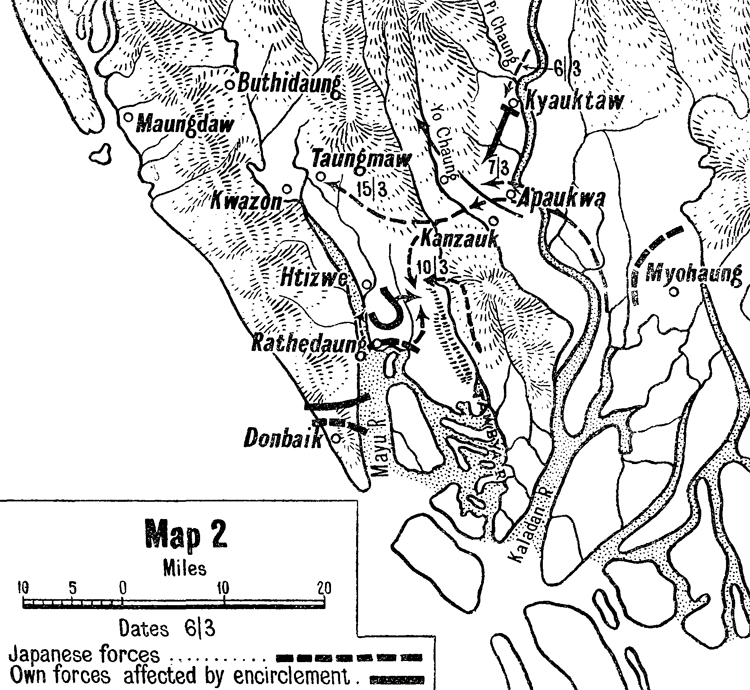
MAP 3.
On the night of the 16th/17th March our forces, no longer possessing a L. of G.:t broke contact with the enemy and withdrew Northwards through a covering force.
The enemy opposite Taungmaw appeared to be in the nature of a holding force-similar to that established at Kaladan. The main thrust was continued Westward across the Mayu and by the 25th March infiltration into the Mayu Range had already begun.
At midnight on 2/3 April a party of Japanese suddenly attacked and overwhelmed a standing patrol on a bridge North East of India ; they were unable to establish a successful road block but the threat to our communications here and further North was such, that we were forced to withdraw our forces Northwards up the coast.
DISCUSSION.
From Kanzauk, where this enveloping movement began, to Indin where it reached the coast, is, as the crow flies, a distance of twenty five miles,,.., but this actual distance gives little indication of the difficulties which faced the enveloping troops. Except for small paths running East and West through the hill areas all lines of communication run North and South, and until such times as British force in the Rathedaung area were forced to withdraw, the enemy depended to a large extent for maintenance on what they carried with them. Later maintenance was based on the Mayu River valley but here too it was not too easy, for the Air Force and the Burma Navy continued to patrol the river. As the-forces involved in the operation increased so did the problem of maintaining them.
The operation was typical of Japanese offensive tactics : although the manoeuvre gradually extended right across our front—or rather rear—few direct attacks took place after the battle around Htizwe. A part of the enveloping force occupied a position around Indin and waited to be attacked, while other elements continued! infiltration Northwards through the hills.
At Rathedaung a double envelopment was made, a small force occupying a position near the East bank of the Mayu river about 3000 yards behind our F. D. Ls. whilst the main thrust came in against our left rear East of Htizwe.
As we have observed before, actual attacks as opposed to enveloping movements^ were made with great determination but they lacked preparation and careful co-ordination. As a result they were very costly and it is estimated that by the time they reached Indin battalions averaged only 450 strong. (The battalions used in this operation contained only three coys, and had a full strength of about 750.)
In conclusion it remains only to be said that once again the Japanese had, where-possible, avoided attack as a means of achieving their object using their superior mobility to occupy a position on our L. of C. where we should be compelled to attack them or withdraw.
Example 2.—A company attack in New Guinea described by one of the platoon, Commanders.
10th August 1942.
The Coy. Commander ordered an attack at dusk. Made preparations in goodi spirit. Superior Pte. Miyabe was fatally wounded in the head by an enemy sniper. At 1430, passed on the order to every section leader to carry out an attack at dusk.
Completed our preparations, and started to advance at 1540. The enemy's sniping was intense. Heard the sound of bullets passing us. At 1620, our grenade dischargers began to roar. 2/Lt. Shimomura aided us with M. Gs. We advanced within 70 meters of the enemy. It began to drizzle. At 1700, fired a smoke candle with excellent results. Pressed closer and closer to the enemy. At 1720, finished our preparation for a charge and discharged 2 smoke candles, one of which failed to explode because of dampness. Nevertheless, the entire platoon carried out a determined charge. During the assault, as I jumped over a fallen tree, my foot caught in something and I fell flat. The platoon instantly lined up alongside me and charged again. We encountered no enemy. Believing they had retired and taken up another position, we approached on our hands and knees. Enemy violently resisted with hand grenades and rifle-fire. At that point, No. 2 Platoon then rushed in and drove them back. At 1900, we occupied a house. The attack ended successfully. During the action, 4 men were wounded.
DISCCUSSION. It will be noticed that full use was made of the 2" Grenade discharger in this attack and that when the writer's platoon was within seventy yards or less of the objective smoke candles were employed.
After the first assault the advance was continued on hands and knees (this was thick country). This is a method of advance which Japanese troops sometimes employ during a night attack {see Chapter VII, Paragraph 9 and Example 2).
6. As others see us—British defending Japanese attacking. (Translation of a captured Japanese document.)
1. Because they often utilize an active defense, it is necessary to dispose your troops carefully, and at the same time, so that they will not discover in this disposition a good opportunity, you must make them abandon their aggressive plans by fierce and resolute attacks.
2. They generally do not give much consideration to their flanks and make their front strong ; therefore, it is best that we carry out encircling movements.
3. As they spend a great deal of time on their defensive preparations, it is essential to attack swiftly in open warfare and not give them any time to spare. Also, as they sometimes do not make a thorough disposition of troops so that they can move them to suit the situation, it is necessary to attack unexpectedly and swiftly and prevent their making suitable dispositions.
4. Their firepower, particularly that of the artillery and machine guns, is disposed densely in front of their position, and therefore it is, of course, necessary to choose a deployment which utilizes the terrain and to move quickly. You must particularly pay heed to secrecy a.nd the concealment of your movements and to utilize darkness and smoke screens.
5. Since they hold out large reserves, particularly mobile reserves you must endeavour to keep your plan hidden and take advantage of surprise. Also, you must use strong striking forces and break through the enemy's lines at one stroke.
6. When their dispositions are in great depth, to break through, you must also organize in depth and break through the position at one stroke. This is especially necessary to prevent their counter-attacking with their mobile reserves and breaking up the attack. To cope with this situation, you must press home the attack with superior force and crush them. Even if there is a deep and somewhat flexible resistance in front of their main position, attack this with the necessary strength, but seek to keep your forces from getting mixed and to keep losses down.
7. Although the artillery is under a unified command, it has various sorts of duties and is kept mobile, you can expect fire almost anywhere. For this reason, you must attack in strength and using concentrated fire to the fullest; try to neutralize their guns.
8. Where the position, especially a position in the rear, is established in depth, and a mobile reserve is used, particularly when a break through is countered by mobile artillery, the co-ordination of the infantry and artillery, for the action after the penetration of the enemy's position, must be very carefully planned.
9. When they discover the attacker's penetration, they call down concentrated fire on it. Therefore, the attacker must make the penetration difficult to observe and his artillery must make appropriate measures to neutralize this fire.
10. They use tanks to good advantage ; and measures against them are essential.
CHAPTER VII.—NIGHT OPERATIONS
1. Training for night operations.
1. The Japanese, who favour Night Operations as a means of achieving surprise and closing early with the enemy, have been quick to realize that to be successful this type of operation demands a very high standard of training. The conscript is care fully trained to fight in the dark, his lessons beginning on the barrack square in bright moon-light and culminating in movement on a dark night across difficult country. His powers of seeing and hearing at night are developed and he is taught to move silently yet boldly. Finally he is practised in control by whistle and verey light.
2. General rules.
2. Japanese regulations lay down certain essentials for the success of any night operation. They are Simplicity, Maintenance of Direction, Control and Surprise.
3. Whilst Simplicity is laid down as the first requirement a high standard of train ing has enabled the Japanese to practise forms of night advance and attack which can hardly be regarded as simple ; these include the capture of successive objectives and the leap-frogging through of a second assault echelon.
4. Direction is maintained by compass, by the employment of guides and by choosing unmistakable natural and artificial features to march on. Flares, white stakes, strips of paper, chalk and flour have all been used, and finally a modern touch has been added by the employment of fifth columnists to light bonfires where they will best serve as a point to march on. The same method has been employed by the Germans in Europe.
5. Control is exercised by imitating bird calls and red flares have often been used to show troops the direction of advance. Whilst the method is simple and—provided the leader knows where he is—fool proof, the employment of flares sacrifices Surprise and gives as much information to the observant defender as to the attacker. For higher control the employment of numerous light weight portable wireless sets is reported by the United States Marine Corps.
6. Rubber soled canvas shoes (" Tabi ") add greatly to the silence maintained during movement.
3. Offensive night operations.
7. Apart from attacks, night infiltration is commonly practised with the object of working small groups into the flanks and rear of a defended position. The two fold role of these groups is to cause panic and to destroy or capture automatic weapons. Such infiltration may precede a frontal attack and once such an attack has begun in filtrated elements in the rear of a defended locality sometimes shout "withdraw!".
8. Night attacks are, when possible, directed uphill. In addition to being an aid to the maintenance of direction such attacks may conceal the assaulting troops and enable them to see the defenders silhouetted against the sky.
9. The objectives of night attacks are usually well defined natural features such as a hill, ridge or stream. A flare fired to hang over the objective has often been the signal for the assault.
9. The assault is sometimes preceded by elements who crawl forward to put down a grenade barrage. In addition the assault may be preceded or accompanied by machine gun fire, this has so far been high in order not to endanger the assaulting troops and must be regarded more as an element in the war of nerves than as covering fire. It must be assumed however that given suitable lines of fire—which are usually available in hilly country—machine guns will be used to fire into the objective over the heads of the attacking infantry. Japanese regulations lay down that failing a more active role the medium machine guns of the attacking force will occupy a secure position and will co-operate with the Reserve.
10. It is most important to remember that the main assault may come from front or rear and in the next section an actual night attack will be described in which our rear most locality was the enemy's first objective.
11. The Japanese occasionally use tanks at night. At Milne Bay two were
employed. They used strong head lamps to illuminate targets for themselves and
for th© accompanying infantry.
Example 1.—Night operation by a regiment.
In the Battle of Pa-an a battalion of the Baluch Regiment made a gallant stand against an enemy considerably superior in strength. When ammunition gave out they fought with the bayonet, with their bare hands and with anything which could be used as a club. " Havildar Major AH Haider Khan was last seen throttling a Jap with his bare hands," writes an eye witness " whilst Naik Amir Khan killed three using his tommy gun as a club."
The story of this battle serves as an interesting example of Japanese preparations for a night attack, and their methods of deception.
On 8th February a battalion of the Baluch Regiment took up a position at Kuzeik, a village on the west bank of the Salween River. The position occupied was a saucer of open paddy land, surrounded by close jungle with thick undergrowth. The main road from Duyinzeik bounded the south of the position and then ran north along the river.
On the opposite bank of the river, 1,200 yards away, the Japanese occupied the town of Pa-an. The role of the Baluch battalion was to prevent this Japanese force crossing the river in the Pa-an area.
To accomplish this the battalion was disposed around the saucer with battalion headquarters in the centre. " A " Company held the river bank, " D " Company the northern face, " B " Company the western face and " C " Company the southern face of the perimeter along the Duyinzeik road. In addition, patrols were constantly maintained along the river bank to Pagat in the South and Mikayan in the North,
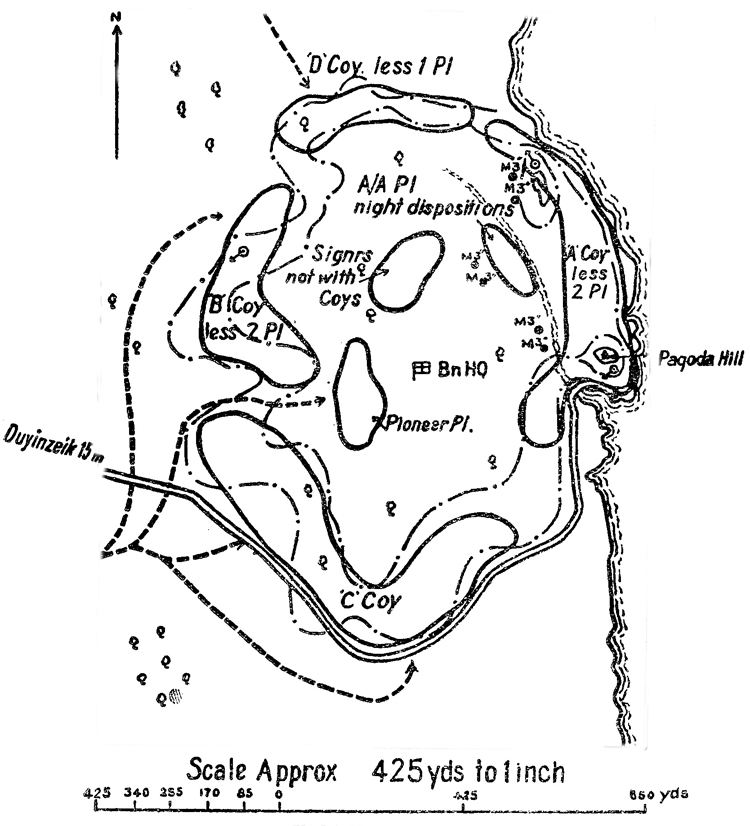
Notes: 1) Contry very wooded. Undergrowth considerable. 2) Field of fire very limited - 50-100 yards. 3) Bn occupied a "saucer": fighting elements on th fringe with H.Q. in bowl.
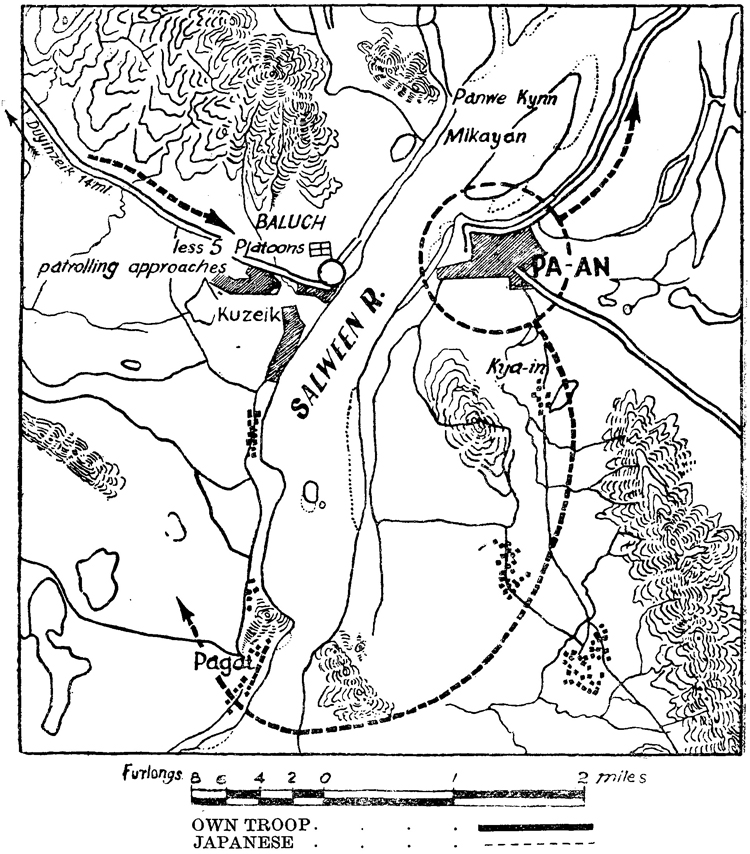
During the night of 10/11 February one of these patrols reported that the enemy had crossed the river near Pagat in strength. The patrol was over-run and a force was sent from Kuzeik to assist it. The advance of this force was shadowed by the Japanese throughout its route, its position being signalled by the tapping of bamboos. However, it drove off the enemy.
On the morning and afternoon of 11th February parties of the enemy were observed crossing the river north of Pa-an, and that evening patrols also reported the advance from Pagat in the South towards Kuzeik of a strong enemy force of about one battalion.
At 1630 hours a small force attacked the Kuzeik position from the South along the river bank. A counter attack by " 0 " Company resulted in the withdrawal of the Japanese.
The enemy were next seen about 0100 hours when a section posted on the road one mile from our positions at Kuzeik, reported that a battalion of Japanese war© advancing in strength from the direction of Duyinzeik.
A quarter of an hour later the main battalion positions were attaoked from the West and South-west, the brunt of the first attack falling on " C " Company. Later attacks were also directed against " B " and " D " Companies from the North-west. The enemy made cat calls and shouted and chattered incessantly in an effort to draw fire and locate our positions ; they also employed tracer ammunition and Chinese crackers.
It was now estimated that the Japanese had deployed a whole regiment, and this superiority in numbers was having its effect on our defences. At 0230 hours, infiltrating between " B " and " C " Companies the enemy attacked " B " Company from the rear. " D " Company was also heavily engaged and the enemy had occupied its West flank. Meanwhile attacks were being made on battalion headquarters and on " A " Company.
The attacks were made in waves, each wave consisting of several parties of 10 to 15 men. These were armed with swords, bayonets and grenades and were supported by automatic weapons. Each party advanced in short rushes, the men lying prone after each advance.
By first light " B " and " D " Company positions had fallen into enemy hands and " A " Company was surrounded. There remained only a very weak " C " Company and Battalion Headquarters after the night's fighting. They put in an attack in an attempt to relieve " C " Company, but this was thrown back by the superior strength of the Japanese.
By 0800 hours the enemy occupied the whole of the Kuzeik position.
DISCUSSION.
This operation serves as a good example not only of the night attack but also of characteristic Japanese methods. Note the wide enveloping movement, the full force of the attack came in along the defenders L. of C, whilst all enemy activity observed up till fifteen minutes before the night attack had been on their South flank.
Once again the enemy used their now familiar methods of drawing fire.
The parties of 12 to 15 men were probably sections, and advancing by rushes was often reported during the early phases of the Japanese war.
The tapping of bamboos to indicate the position of one of our patrols is of interest. In the Arakan bamboos were occasionally tapped together to assimilate L.M.G. fire.
Example 2.—A platoon night attack described by the commander of the platoon which made it.
9th August 1942.
" As dusk approached, we advanced to within 70 metres of the enemy, who concentrated an intense fire on the No. 1 Platoon. Because of our faulty formation and the hindering rain we were unable to carry out a charge. Decided to attaok at night, but men were not properly assembled. Valuable time was wasted in the torrential rain and darkness. Even the section leaders could not be lined up.
Commenced a night attack at 2220 hrs. Advanced stealthily on hands and knees and gradually moved in closer to the enemy. Suddenly encountered enemy guards in the shadow of large rubber trees. Corporal Hamada killed one of them with bayonet and engaged the others, but the enemy's fire finally forced us to withdraw. The Platoon was scattered and it was impossible to repeat our charge. 1st Class Pte. Hirose was killed by an enemy bullet. Corporal Hamada was unable, due to the darkness, to assemble the men remaining. I went to the rear and tried to assemble the men by myself, but beoause of darkness two men and I took the wrong direction. We suddenly realized that we were within 40 meters of the enemy lines. Hand grenades were thrown at us. The night attaok ended in failure. No. 1 platoon also carried out an attaok at about 0300, but it was unsuccessful."
DISCUSSION.—-The attaok was launched in thick country. The' crawl forward should particularly be noted, it is also used for approaching an enemy position prior to a daylight assault.
EPILOGUE
These then are the tactics of our enemy as we know them today, they are the tactics of a modern aggressor army trained to fight in South West Asia. If you study them you will not be surprised by them ; instead, you will, like the Australians and Americans in New Guinea and Guadalcanal, evolve counter-measures to destroy these bandits.
But remember what you are up against—
In general the Japanese is tough and his morale is high.
In defence he is a tenacious foe who digs in well and remains concealed and silent until he can engage assaulting troops with heavy fire at close range.
In frontal attacks he is mediocre but brave. He prefers envelopment and always seeks to achieve it, great stress being laid on this form of offensive action in his training.
At night he is very active and his patrols have often had considerable success against inexperienced troops.
But remember also—
There are no mysteries in Japanese tactical doctrine and practice.
We start with better arms and equipment. We can achieve training and tactical skill at least equal to if not better than his, and we need have no doubt, therefore, of the final outcome. Part II of this Pamphlet indicates how this training is to be carried out.
JAPANESE IN BATTLE
2nd Edition
GENERAL HEADQUARTERS, INDIA
MILITARY INTELLIGENCE DIRECTORATE
9329 K/G. S. I. (t) (i) AUGUST 1944
THIS DOCUMENT MUST HOT FALL INTO ENEMY HANDS
INTRODUCTION
THE object of this pamphlet is to indicate briefly the chief characteristics of Japanese behaviour in the field as they differ from our own and that of western generally. Principles and methods which the Japanese share with most other armies are touched on lightly or passed over. Japanese strategy, though it too is strong peculiarities, is not dealt with in this pamphlet, which restricts itself to tactics, major and minor. The description of Japanese tactics is based on observation of Japanese practice in the field rather than on the rules laid down in Japanese ulitary handbooks, to which their practice often bears little relation.
1. Tactical characteristics and the principles of war
1. The Principles of War.—As a general introduction the following paragraphs eview the manner in which the Japanese apply the principles of war as laid down n our Field Service Regulations.
2. Offensive action.—Japanese soldiers from the highest to the lowest are thoroughly imbued with the spirit of offence, in which they tend to see the solution of all psroblems. The almost instinctive reaction of any Japanese commander in a new, unexpected or difficult situation is to look for some way to assume the offensive.
It must, however, be pointed out that the characteristic Japanese method of ittack often results in a tactical defensive. This is the outflanking march and blocking of the enemy's L. of C, accompanied possibly by small frontal attacks, first to hold and secondly to encourage withdrawal. The method is to get round the enemy on to his Ls. of C. and make strong defences on them ; the enemy, after encouragement by small frontal attacks, jitter columns and the fear of being cut off, will then attempt to withdraw and be ' impaled', as it were, on the defences of the road blocks. The manoeuvre is not a flank attack but an outflanking movement to seize defensive positions which the enemy in his turn must attack. Direct assault is commonly used only when absolutely necessary, as for instance in ordinary counterattack.
3. Maintenance of the object is strongly marked in Japanese operations and is a
source both of strength and weakness. Once battle is joined the Japanese pursue
their object with the greatest energy and the last ounce of strength, and their in
difference to the consequences tends to give them an advantage in actions of the " slogging-match " type when both sides are approaching exhaustion.
On the other hand, maintenance of the objective is often carried to a pitch when lack of flexibility becomes disastrous.
In the Japanese Arakan offensive of February 1944 the Japanese forces were committed to a large enveloping movement intended to annihilate at least two of our divisions. The plan, for which a hard and fast time table had been provided, went drastically wrong soon after first contact, but as days went by it became increasingly clear that no new orders had been issued by higher command. Similarly, in Manipur in April—June, the fiction that Imphal could still be captured was maintained by 15 Army long after the necessity for a revision of the object should have been clear. The result was the wearing down of the available forces in a series of fruitless attacks to the point where a costly withdrawal could not be avoided.
4. Economy of force.—The Japanese are enabled to secure to a remarkable degree by their toughness in defence and their willingness to accept risks and if necessary leave forces to fight and die unsupported in sectors not considered vital. They can thus concentrate for their principal effort a remarkably high proportion of the total forces. A case in point is the way in which 18 Division in the Hukawng and Mogaung valleys was sacrificed to the interests of the Manipur offensive in the spring and summer, 1944.
On the other hand at all levels ambitious objects are regularly attempted
with a relative strength which in Western armies would be regarded as inadequate.
Japanese tactical instructions constantly reiterate that by manoeuvre especially
by superior morale small forces can overcome large ones. The effect of this tactical
doctrine has been a tendency to attempt to attain objects out of all due proportion
to the forces in hand. The striking successes .obtained early in the East Asia War
by small forces against ill-trained 0$ cTemoralised troops have probably helped to
confirm this Japanese tendency.
5. In their interpretation of the principle of concentration the Japanese differ widely from Western and particularly from German methods both in the assembling and handling of forces for an operation.
The characteristic form of attack indicated in para. 2 above implies dispersion and involves advance on distant objectives in a number of columns not mutually-supporting. Of the initial orders for the Manipur offensive in March 1944 not one mentioned assault on any of the main objectives. To isolate and then encourage the enemy to withdraw was the first object. The destruction of the enemy would come about by the disorganization inherent to a certain extent in any hasty withdrawal.
In committing forces for the attainment of a main object the Japanese observe the principle of concentration in that they hold nothing back which could be used, committing even specialist troops in infantry roles. A consequence, however, is that the commander finds himself without reserves under his hand to influence the further course of the operation. Both in attack and defence reserves in the true sense of the term are conspicuously absent from Japanese practice. Similarly, reinforcements are commonly committed to battle piecemeal, as they arrive.
6. Surprise is carefully attended to by the Japanese. Though ruses (including the use of disguise and of the language of the opposing troops) are extensively employed, and although in the early stages of the war extensive use of a fifth, column made it possible greatly to increase the methods by which the enemy was taken by surprise, the principal Japanese method of securing surprise remains the use of country regarded as impassable. This, together with choice sometimes of foul weather, is relied on to place troops more sensitive to ground and climate at a disadvantage. Where the success of a movement depends on surprise the Japanese also show a high degree of skill in concealment. From the exceptional marching powers of the troops—they are capable of covering thirty or more miles per day—the Japanese profit by their ability to feed them and to open routes for them, which make it possible, by choosing a circuitous path through difficult country, to the line of retreat of a force based on a road. These advances are characterized by the rapidity with which their engineers improve tracks to a sufficient standard for the immediate purpose.
If the chances of living on the country are small, forward troops with their own animal transport may carry up to a month's supplies. The Japanese soldier has been trained to carry up to 58 lbs. though it should not be imagined that he habitually carries a heavy load of rations and equipment, for like us he prefers to fight as lightly equipped as possible. Impressed local inhabitants, with carts if the country is suitable, supplement their carrying powers, whilst opportunities are never neglected to seize local supplies and utilize captured stocks.
7. Security —The general impression is that the Japanese are less than normally attentive to security. Their deep and often thorough patrolling is carried out in the service of offensive action and not of security ; for the security of their own flanks and rear the Japanese tend rather to rely upon retention of the initiative. In minor tactics inattention to security is noticeable, and parties on the move or in camp are often unduly liable to surprise.
8. For judging the Japanese practice of co-operation whether between the arms or between air and ground there has hitherto been inadequate material on which to base a judgment, owing to the low scale of air effort generally and the minor part hitherto played in Japanese operations by artillery and the A. F. V.
2. Morale
9. A year ago all evidence showed that the morale of the Japanese troops was extremely high. This was not confined to the armed forces, but was also the case with civilians. A high ranking official of a (then) neutral country, writing from Tokyo in the middle of 1943 said " I wish, with all my heart that I could report that these hardships are weakening the civilian morale but I cannot. His will for war is as hot as ever."
This was the spirit instilled into the Japanese soldier from early childhood and throughout his training. They are taught to believe that the Emperor is a manifest of God descended from the Sun Goddess; that they owe everything to him and that they themselves are God's chosen supermen—soldiers of heaven. This teaching and the added belief that death in battle is the soldier's highest aim in securing the perfect after life must lead to fanaticism.
It is possible, however, that confidence in their legendry superiority, based as/ it is to a large extent on myths, may be shaken by a series of defeats not suffered by the Japanese in wars previous to the present one.
10. There has been this year (1944) a slight but definite change, and although the Japanese troops in Burma still fight with courage and determination, some times against much superior forces, their diaries contain far less heroics than a year ago. The Japanese forces in Burma have this year launched two offensives which, the troops were told, were to bring them down into the plains of Bengal and Assam.
Both their offensives failed and as a result many soldiers no longer possess that fanatical enthusiasm for the war which they had in the past. Some want to finish the job and go home ; others complain about their officers and N. C. Os., their food— or rather lack of it—and the many discomforts of the conditions in which they live and die. The glories of dying for the Emperor have paled and in a few exceptional cases the decline in morale has been sufficiently general in a unit, or group of units, to call for the writing of special directives on the subject. In an order of the day captured in the Arakan in April 1944, the G. O. C. of a Divisional Infantry Group says :—" The general condition of the Infantry Group does not admit optimism.
To win the battle we must develop to the utmost the spirit of Yamato. [Symbolic
of the conquering destiny of Japan]. To indulge in thoughts that we cannot win
because our weapons are inferior is already to have lost the battle. As for the
throwing away and careless abandoning of arms—these things must on no account
happen. To abandon or throw away weapons bearing the Imperial crest is the
height of humiliation, and represents a collapse of morale ".
11. Further, an extract from a special order issued by the commander of the -33 Divisional Infantry Group in the Imphal area in Burma on the 2nd June 1944 reads " Still, should by any chance any delinquencies occur amongst you, I am considering what exceptional measures I shall have to take against the offenders In short, a commander must not hesitate to stain his sword with the blood of his own troops if it is to uphold the honour of his unit".
12. These examples suffice to show a tendency which the Allied effort in and
over Burma has created during the last seven months (Dec. 43—June 44). At
present it is no more than a tendency, but it will develop as our pressure on the enemy
is increased and sustained. It cannot be repeated too often, however, that the
Japanese are, generally speaking, still fighting with determination, and every prisoner
so far captured is convinced that Japan will ultimately win the war.
CHAPTER I. DEFENCE
1. General Principles
13. " Passive defence," it is stated in an official Japanese document, " has the disadvantage of making it easy for the British to build up their strong fire power.
We must avoid static defence as mucn as possible. Even when fully on the defensive we must work to keep our forces mobile".
The very word defence is, whenever possible, avoided. This, for example, was the wording of the "intention" paragraph of an operation order for the defence;—
" The unit will secure its present positions for an advance. While continuing generally to disrupt the enemy's activities it will prepare for future attack ".
The Japanese seldom sit and do nothing for long. If the front is quiet, they may be preparing a surprise on one or both flanks.
14. These threats vary greatly in scope : some are made by nothing more than a handful of men who, having approached under the cover of darkness throw a few grenades and fire an automatic weapon at a rear platoon which imagines itself to be a mile or two from the nearest enemy. Others involve a company or more who, seizing at night a strong natural feature in our rear, endeavour to disrupt communications, and make a nuisance of themselves until they are attacked and annihilated.
For example, after the costly failure of their February 1944 offensive in the Ara-kan, the Japanese were thin on the ground, tired, and completely on the defensive, but still they infiltrated a small force (a battalion not more than 400 strong), to a> position about 4£ miles behind our foremost troops and these disrupted communications until they were located and destroyed.
This tendency to place troops and leave them isolated without apparent intention of relief or supply at points behind our lines, the retention of which they consider vital to their plan, has been repeatedly noticed. It does not appear to matter to them as to what finally happens to these troops once their purpose has been fulfilled.
15. The Japanese normally fight to the last man, but references in Japanese documents to withdrawal without orders and the experience of recent fighting show that exceptions to this rule are not uncommon. Surrender, however, as opposed to withdrawal, is still very rare.
16. Surprise is achieved by silence and concealment. Until attacked, troops occupying forward localities very seldom open fire even if the target offered is a good one. By careful observation it is nevertheless often possible to locate at least some of the enemy's bunker positions ; to quote an extreme case, all three bunkers in the position illustrated on page 30 were pin-pointed and destroyed before we attacked it.
17. On the defensive the enemy as far as possible avoids initiating any.movement himself during the hours of daylight. Studying a hill which he is known to occupy, one is struck by its completely deserted appearance. There is neither noise nor movement, and perhaps a few feet of obvious camouflage alone suggest his presence. There have, however, been exceptions to this. If we by-pass his defended locality and occupy a hill behind him, the normal daylight silence is broken and carriers transporting food and ammunition, troops sneaking down to a stream to fill water-bottles—indeed, any form of movement is greeted with a fusilade of automatic fire and perhaps one or two shells from the battalion gun " whizbang ".
2. Frontage and Depth
18. If the strength of the forces at his disposal permits, the Japanese Commander occupies a position in depth. If, however, he is faced with the alternatives of frontage or depth, he appears to sacrifice the latter in order to maintain the former.
A captured Japanese document gives as the normal frontage for a battalion 1500 to 2000 yards, and a depth of 1000 yards. In Burma the following frontages have been used in the defence:
(i) jungle-covered hills rising about 100 feet on one flank to 1000 feet on the other: 5000 yards front for one battalion plus
(ii) Two-thirds jungle-covered hills mostly under 400 feet), one-third paddy fields and villages : 8000 yards front for two battalions.
(iii) Plain dotted with jungle-covered hills 100 to 200 feet high : 5000 yards front for one battalion.
The depth of such positions has been-1000 to 3000 yards. Such large frontages are held by sacrificing mutual small arms support between localities, which may be 2000 yards or more apart. Artillery and mortar support is, of course, little affected by this wide dispersion.
19. It should not be assumed from the three examples given above, that the Japanese will always be thin on the ground. In positions which they consider vital to the defence of some important centre, one finds the battalion occupying a frontage more in keeping with the text book. For example, at Rathedaung in 1943 a battalion occupied a frontage of under 1500 yards (see Page 21). Rathedaung covers an important approach to Akyab, and is only sixteen miles from Akyab Island.
3. Layout
Examples of typical defence layouts, from platoon to battalion positions, are shown at Appendix " A ". They show no remarkable difference in principle from our own layouts.
All-round defence
20. The principle of all-round defence is not applied as an invariable rule, but given the time to develop a position and the troops to hold it, both all-round defence and depth will be achieved. (Examples).
21. The basic garrison for a locality in the main defensive position appears to be the platoon, which, if low in strength, may not even be divided into sections. Three such localities are sometimes sited to provide mutual fire support and to form a company area to which medium machine guns and/or mortars may be attached.
Covering positions
22. Covering positions are occupied in order to slow down the enemy's advance on to the main position and to provide observation whilst denying it to the enemy. In the early stages of making contact isolated section and platoon localities are found up to about 5000 yards in advance of the main position. The maximum distance was observed in country where the ground is half paddy fields and half small hills, but in hills thickly covered with jungle the most reported was 2000 yards.
Under sustained pressure covering troops normally fall back until, depending on the type of country, they may be found watching likely lines of approach 300 to 1000 yards in advance of the main position.
In some cases covering troops have offered determined resistance and accepted comparatively heavy casualties before withdrawing, but their normal role is one of reconnaissance and delay, not of fighting to the last man and the last round.
Alternative and dummy positions
23. Alternative positions are dug, and dummy positions, troops and weapons have been reported in the South West Pacific. Some tactical notes, based on experiences in New Guinea, were recently (April 1944) captured in Burma. Here it says : " The use of constructing dummy positions a short distance in front of the real ones in order to draw off the enemy's firee has obtained good results ".
In Burma the Japanese are making increased use of alternative positions.
Reverse slope positions
24. This year the Japanese in Burma have begun to build bunkers on the reverse slopes of hills, from which they shoot up assaulting troops as they come over the crest. This use of the reverse slope had previously been reported by the Americans in the Kuriles, but it is not yet very common in Burma where the steep gradient will often prevent the siting of a post to shoot up-hill.
A recent situation report reads : " Night 25/26 May Our troops overran
the first enemy position but were heavily engaged by fire from reverse slopes when attempting to advance further ". This may become a common practice, particularly at night.
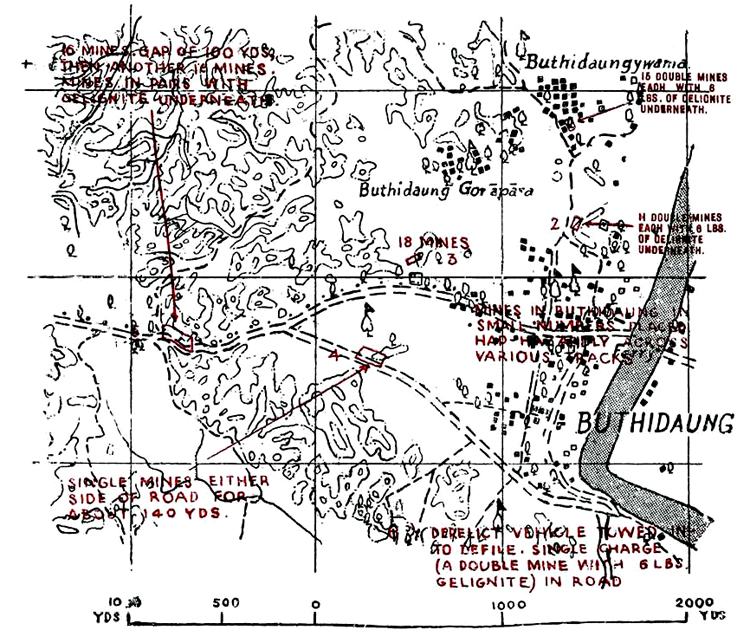
The mined approaches to Buthidaung
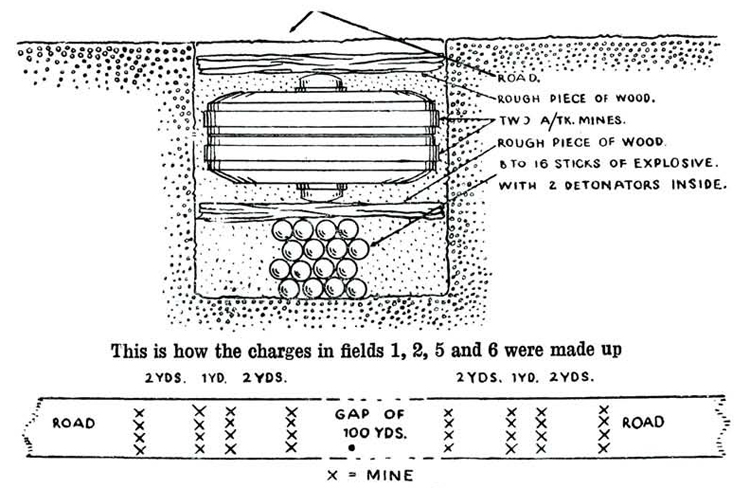
How field 5 was laid out
4. Field Works
Wire
25. The Japanese have used comparatively little wire up to the present, except in the case of beaeh defences and around one aerodrome. Double-apron fences have been constructed both of normal height and also about a foot high to serve as a double apron trip-wire fence.
In front of positions so far captured in Burma the type of fence most commonly seen consists of a row of 4 ft. posts to which are attached three strands of barbed wire. This fence may run parallel to the foremost trench and at a distance of about 20 yards from it, or it may zig-zag through the bushes and trees at the foot of the hill on which the locality is sited. In the latter case it appears to* be sited with the intention of leading troops, who follow it, in the direction of M. Gr. posts. An elaboration of this lay-out is to construct two fences (see Example).
Trip wires are used on paths and likely approaches to positions. These often have a few tins attached to them to give warning of our approach.
In addition to fences and trip wire attached to pegs, a single strand of loose wire is sometimes laid in hedges and bushes.
Steel and cement
26. There have been few instances of the use of either steel or cement for inland defences (as opposed to coastal defences) in Burma. But both these materials have been used in the construction of island defences in the Pacific, cement being used for coast defence gun emplacements and steel for observation posts. Cement pill-boxes have also been constructed on the Andamans. It is improbable that they will be met in great numbers inland in Burma.
Minefields
27. Up to the present the Japanese in Burma have not used mines in large numbers anywhere. The " field " is generally confined to roads and tracks and to the grass each side of them, but mines are sometimes laid on a broader front in order to cover denies or places in which vehicles are likely to deploy off the road.
28. The Type "93 " mine, which can be used in an anti-personnel or anti-tank role, is not very effective against tracked vehicles, but may blow a track. Lately, however, the Japanese have been boosting this mine and using it on a larger scale with some success. An improvement in his use of minefields and the type of mine employed is therefore to be expected.
29. Opposite is a sketch map showing how the approaches to Buthidaung were mined this year, and this example may be regarded as typical of the extent and layout of Japanese mine fields so far experienced in Burma.
5. Weapons
Machine Guns
30. Following normal practice the Japanese make the machine gun the principal weapon of the defence when the country is open enough. Automatic weapons are sited to fire along prepared lines—lanes being cut in the jungle if necessary—but it has been noticed recently that well placed smoke usually silences them, which suggests that fixed lines are not always used. Medium machine guns are sited well forward to cover the main lines of approach. They are generally sub-allotted to platoon localities.
During the defensive battle, MMGs sometimes fire along a line about 10 yards from the forward edge of Japanese F. D. Ls.
While automatic weapons are frequently to be found on high features and the Japanese have no qualms about occupying the crest of a hill, where at least a simple trench system is normally found, there is a new trend apparent in the siting of all automatic weapons ; they are coming further down the hill. One Japanese commander has gone so far as to say that M. Gs. should be sited on the forward slope about 35 yards down the hill thus avoiding our artillery shells which he expects either to-hit the crest or to fall on the rear slope.
Our troops attacking a hill feature about 70 feet high in the Arakan early in 1944 were half way up the hill when they were enfiladed with automatic fire which appeared to come from a direction either level with or slightly below them.
Where the sides of a hill are very steep, however, automatic weapons are still found on the crest.
In country of small hills interspersed with paddy fields and villages, machine guns are often dug into the banks of the square village ponds found in this type of country.
Mortars and Grenade Dischargers
31. Mortars of 3 inch or larger calibre may be allotted to forward battalions, but the high-angle weapon most frequently used by troops occupying foremost defended localities is a 2 inch grenade discharger of which there are three in each platoon. This is a rifled weapon which throws a small shell 700 yards.
Once an attack is launched, mortar and grenade discharger shelling is frequently directed on areas which cannot be reached by flat trajectory weapons. Particular attention is paid to probable lines of approach and likely forming up places.
The Japanese often bring down mortar fire on defensive positions occupied by their own troops. This particularly applies to bunker positions which have been surrounded or over-run by our forward elements but may still be in action. A good example of this occurred on the Arakan coast early in 1943, where our troops who had captured an area which contained a bunker were heavily bombarded by mortars whilst trying to throw grenades through the loop holes.
Anti-Tank Weapons
32. The Japanese 47 mm A. tk.gun has now been taken into general use by independent anti-tank gun units in Burma, and it is probable that all types of Japan ese artillery capable of engaging tanks will shortly have armour-piercing ammunition.
Besides the 47 mm weapon, A. tk guns likely to be met include a 13 mm and a 20 mm H.M.G. and the 37 mm gun which is usually found with infantry.
A hollow charge grenade has been captured in Burma. This is fired from a launcher attached to the muzzle of a rifle and it can probably be aimed with reasonable accuracy up to 50 or 60 yards.
The Type " 93 " (1933) mine is still in use, but only in pairs, whilst the magnetised anti-tank mine, the prussic acid bomb and Molotov cocktails are issued as tank hunting weapons.
Artillery
33. The primary tasks of Japanese artillery in the defence in Burma have been harassing and counter-battery, whilst a certain amount of defensive fire has also been experienced.
Harassing fire has been directed against—
(i) Areas showing signs of movement—for example, dust rising out of a valley, or vehicles seen entering a valley. (ii) Vehicles moving across the open (even single vehicles are frequently engaged).
(ii) Bodies of troops moving across the open. (iv) Hill features occupied by our foremost infantry. (v) Newly captured objectives (up to 20 shells of any calibre soon after we have occupied the objective). (vi) Headquarters.
Counter-battery fire usually takes the form of a shoot of 15 to 20 shells, whilst as an alternative to fire, counter-battery suicide squads, commonly numbering between 20 and 30 men infiltrate and attack gun positions with the object of placing charges and destroying the guns. Most of these attacks have failed in their object.
Defensive fire.—During the defensive battle Japanese artillery shells probable forming-up places, lines of approach and assaulting troops and tanks in the open.
34. Up to the present Japanese guns have normally been sited singly and, on rare occasions, in pairs. A normal shoot is 12 to 24 rounds, after which the gun, unless it is in a very safe place, is moved to an alternative position. Japanese artillery does not normally fire at night. With aircraft overhead guns near the battle area cease fire in order not to give away their positions.
Snipers
35. The extent to which snipers are employed varies greatly with each front. In the Arakan recently (March—April 1944) they were hardly ever met; on the other hand situation reports from the Imphal area include such references as " Sniper particularly active " and " After X Bn had reached its second objective Y Bn passed through them to deal with snipers ".
Although sniping varies a great deal in intensity, there are certain places where sniper posts may be expected—
(i) above small advanced positions,
(ii) on the flanks of localities,
(iii) covering lines of approach to the Japanese main positions,
(iv) covering paths in our own area,
(v) covering gaps made in our telephone cables (this has been reported once).
6. Counter Attack Immediate Counter Attacks
36. The Japanese launch immediate counter-attacks against troops who have captured part of a locality. These small local counter-attacks may be made by only a dozen men led by an officer ; they are preceded by a shower of grenade discharger shells and the charge is made with automatic weapons. This immediate counter attack may be launched five to ten minutes after the locality has been penetrated.
A wild war cry, to which is sometimes added the shout " Charge ! " in English, gives warning of what is impending.
Night Counter Attacks
37. As an alternative to immediate counter-attacks the Japanese sometimes wait till dark before they attempt to recapture a lost feature. If the first night counter-attack does not succeed, it is sometimes followed by a second and even a third attempt.
Meeting Counter Attacks
38. A third form of counter-attack has been experienced in the encounter battle, but it must be emphasised that it is exceptional. In this, the enemy does not wait for our troops to reach the hill or other feature he is occupying. Instead, he comes for ward to meet them, his advantage on these occasions usually being that he is going down-hill and we up ; also he may avoid any covering fire we have organized.
CHAPTER II. THE ADVANCE TO CONTACT
1. General
39. A force advancing is preceded by advanced guards the major tasks of which are to gain information, brush aside minor opposition and, when the main enemy force is encountered, to give the main body time to deploy and envelop it. In order to fulfil these tasks Japanese covering troops advance with speed on the broadest possible front.
The speed with which the advance is conducted cannot be over-emphasized, and it is important to note that the commonest reaction to first contact is wide en-velopment.
2. Reconnoitering and Striking Elements
40. Provided the terrain permits the use of transport, the several parallel columns are preceded by small parties of troops on bicycles or in lorries, and possibly accompanied by one or two tanks or armoured cars which cover their deployment on first contact. These leading elements are particularly vulnerable to ambush.
A formation often employed consists of four to five cyclists followed at a distance of some hundreds of yards by a group of about sixty more. These small parties are really no more than reconnoitering elements whose task on first contact is to move forward on foot in order to discover the strength of the opposition and the extent of the front occupied.
41. Behind them come either what may well be termed main guards, or the main body itself. Main guards are strong in infantry and engineers and normally include artillery or mortars. Also they will probably be accompanied by tanks or armoured cars.
3. First Contact
42. On making contact the leading elements extend on both flanks, shouting, firing and employing any other ruses calculated to make the defenders open fire and disclose their positions. They also site a machine gun to fire down the road or track on which they have been held up. This gun is carefully sited and protected and difficult to dislodge.
43. If possible the leading elements infiltrate, and once behind the forces opposing them they fire crackers and automatic weapons in order to give the impression that they have, in large numbers, encircled their opponents.
44. If the advanced elements are not able to infiltrate they take up a position astride the road and, supported by machine guns and mortars, endeavour to pin the opposition.
4. Demonstrations
45. Great importance is attached to demonstrations which vary from a few men dashing into the open to draw fire, to large bodies of troops being employed to make a feint attack in order to attract the defenders' attention away from the real one. Fire, loud talking, the rustling of bushes, calling out in English, Urdu or Gurkhali— all or any of these ruses may be employed to attract the defenders' attention in the wrong direction, or to persuade him to open fire prematurely and thus give his position away before he need do.
5. The Encounter Battle
46. It would appear from the speed with which the battle develops that the leading elements are in close communication with the forces following them. One man pack R/T sets are normally attached to the headquarters of advanced detach ments.
47. It is apparent from the short time between the first contact and first attack
that some units are committed to an enveloping role from the earliest stages and the
outflanking of the opposition begins almost simultaneously with the holding up of
the foremost elements. In small units—for example companies and platoons
attempts to envelop the opposing troops follow very shortly after first contact and
the speed with which these enveloping movements are launched suggests the employment of a tactical drill. Pressure is maintained frontally whilst the flank attack
or attacks proceed. As the opposition stiffens the normal attack develops. This
is discussed in the next chapter.
CHAPTER III. ATTACK
"Our plans and our reconnaissance must be kept secret and we must attack at an unexpected time and place We shall seldom be able to gain surprise by attacking the opposing forces on terrain which permits a fairly easy approach ".—Japanese Dictum.
1. Major Tactics of the Attack
48. A study of Japanese offensive operations indicates that with the regularity almost of a drill the Japanese constantly aim at placing bodies of troops across their opponents' L of C, and thus compelling them either to attack on ground of their own choosing, or to withdraw. These plans tend to overlook the air factor and the help the air arm can give to beleaguered garrisons.
49. In the first Burma campaign, from the time that the Japanese crossed the Salween River at Moulmein until the last action at Shwegyin on the Chindwin there are very few recorded instances of deliberate attacks. Rather was their superior mobility used to force us to attack troops who had succeeded in occupying a position behind u&. They chose an area on the L of C, to hold which would cause us the maximum embarrassment, and the focal point of the battle which ensued was often a road block. In fact, the Japanese fought defensively in country peculiarly suited to the defence. One big exception to this method during the first Burma campaign was an attack launched against one of our brigades at Kyaukse ; here the Japanese suffered considerable losses and the attack failed completely.
50. As a typical example of these tactics a narrative of the operation by 55 Division in February 1944 to isolate two British divisions in Arakan is given in some detail at Appendix " C ".
2. Minor Tactics of the Attack
Reconnaissance Prior to an Attack
51. When the Japanese do make setpiece attacks they precede them by normal careful reconnaissance made with the object of discovering our strength, dispositions and soft spots against which can be directed the main effort of attack. Various ruses are employed to draw fire, including exposing small parties in the open. If cover permits, scouts may be left in observation for long periods close to our foremost defended localities.
Stress is laid on the value of prisoners as a source of information when preparing; an attack.
Forward troops infiltrate, taking advantage of all available cover to creep> forward. This is in the nature of a battle reconnaissance which goes to ground when-held up by the defenders' fire but brings light machine gun and mortar fire to bear on any position it has discovered.
Frontal attacks
52. Small local frontal attacks are often made in order to capture some specific feature, but it is clear from captured documents that the Japanese also regard the frontal attack as a means of achieving a large scale break-through, for which "the whole strength will be concentrated at one spot and the break-through effected with lightning speed ". The penetration is to be deep, and the objectives are to be the enemy centres of command including Divisional Headquarters. It should be real ised, however, that such attacks are on a small scale, rarely exceeding battalion strength.
If the attack on the chosen sector does not succeed, it is not uncommon for the main effort to be directed temporarily against another part of the front the old axis being reverted to later.
Flank and Rear Attacks
53. Flank and rear attacks continue to be the form of attack most commonly attempted and whether it is a section or a division attacking the principles are the same ; part of the force is used to attract the enemy's attention to the front whilst the rest of the force attacks from the flanks or rear, preferably from the rear.
These tactics are clearly described in a training memorandum captured early this year. It reads— " The attack must be made in a direction that the enemy does not expect and where there is cover from enemy fire. In attacking the enemy on hill tops, use must be made of dead ground and positions must almost invariably bs assaulted from the rear. The enemy's routes to the position will usually be a guide as to which is the rear of the position. The following method of attack is usually successful... .Part of the force is employed to distract the enemy either by fire or shouting while a second party assaults from the reverse directions. It must be remembered that the .party detailed for distraction is liable to come under enemy hand grenade fire and it must therefore always be placed beyond throwing range. It is also subject to enemy artillery fire, and, in order to minimise casualties should be properly dispersed. The time for the distraction of the enemy must be co-ordinated with the time of the attack from the rear by the main body and not vice versa ".
3. Supporting Weapons
54. Whereas formerly the Japanese often regarded a swift bayonet charge as the only essential for a successful attack, supporting weapons are now very much in ^evidence, and field artillery and mortars often put down fairly heavy concentrations as a preliminary to an infantry assault supported by machine gun fire and accompanied by a few tanks.
55. In reading the following, it must be remembered that the close nature of
most of the Burma theatre of operations has given predominance to those weapons
'having a " searching " characteristic, such as the mortar bomb and grenade.
Weapons with a flat trajectory have only a limited use in this type of country.
If, however, future operations extend to more open country increased employment of weapons with a flat trajectory is to be expected.
Artillery
" Artillery should be disposed to give the maximum assistance to the assault. If the best possible use is not made of fire power to provide systematic support, it will be found that most attacks fail ".—Japanese Dictum, 1944.
56. The Japanese in Burma have only recently (April 1944) commenced using artillery on a large scale in putting down concentrations prior to attacking. The maximum artillery effort encountered up to June 1944 on the Imphal front in Burma is given below. With L. of C. conditions better than they were in this theatre and improved ammunition situations, heavier concentrations must be expected in the future.
57. This inoraased interest in, and use of artillery has been forced on the Japanese. They find now that they have to attack our prepared positions, and in order to do so artillery support is essential. The following extract from a report by one of our own observers well illustrates this point
" The Jap has shown, perhaps, no startlingly new methods in his tactics up here, but we have learned a lot about his old ones and we have compelled him to change some of them. A year ago, for example, you would never have found him making headlong attacks on Ningthoukhong and Bishenpur. To get our garrisons out of those places he would not have fought them but he would have gone somewhere else and made us fight him. Now, that ruse no longer works because he has discovered that we know the answer to the road block or his seizing of hills somewhat behind our forward troops. Now he finds that to get our forward positions he has to attack them ".
58. The Japanese normally employ their guns well forward and the speed with
which they insinuate them into the front-line has been particularly noticeable.
On occasions, mountain guns, well dug in, have been employed as anti-tank weapons
\to some effect.
Maximum Artillery Effort on the Imphal Front, Map 1944
(a) Firepower—
22 Med gun hows
14 Mtn guns
2 Regtl guns
2 Bn guns
(b) Wt of shelling—
200/300 rounds
(c) Duration—
(i) General HF 15/45 mins.
and registration (V slow)
(ii) HF prior to an 18/36 hrs.
attack (slow rate)
(iii) HF prior to main 45/60 mins (normal)
assault
(iv) CB fire 10/15 mins (normal)
V slow about 10 rounds per hr. Slow „ 20 „ „ „ Normal „ 20/40,, „ „
(d) Mtn guns operate usually in sees (2 guns),
Regtl or Bn guns singly,
Med guns in sees, sometimes mixed 150 mm and 105 mm.
Section positions are usually sited with one gun in depth behind the other. Tanks
59. Recent fighting in Burma between March and July, 1944 has seen the Japan ese employing tanks. The total number committed during this period was between seventy and eighty. Certain infantry battalions receive training in Japan in tank co-operation. One such battalion was engaged in these operations.
60. The normal role for tanks has been close support to infantry, in which they were used as mobile armoured pill-boxes. The number of tanks emploj^ed at one time varied between two and eight, and the infantry strength from about one company to a battalion.
On one occasion only did the Japanese offer armoured battle. Some of our tanks had gone forward to help a party of British and Gurkha troops, who were cut off with their wounded behind the enemy lines. On the march to join these-infantry, our tanks were ambushed by five Japanese tanks, which had their armament trained along the track. These tanks had been sited off the road on either side, and had been skilfully concealed beneath foliage and creepers. The leading pair of our tanks was caught by the full blast of all the Japanese guns at short range. A second salvo from the Japanese set one tank on fire by hitting the engine. The crew baled out, all escaping except one gunner, who was killed in his tracks by heavy machine-gun fire from the Japanese tanks. The remainder of our tanks went through the two which had been knocked out and attacked the others, disabling all five of them,. and killing the crews. This action lasted about eight minutes.
On another occasion in an attack on one of our road blocks, two light tanks were used in support of probably one weak infantry company. They broke through, and managed to get some motor transport past the block for the loss of about 5® men. We subsequently counter-attacked and restored the position.
61. On Tarawa Atoll in the South West Pacific seven light tanks were run down into previousy prepared positions, allowing the guns to fire through slits in special pillbox shields, already in place over the positions.
62. The limited use of tanks by the Japanese, and their emphasis on the purely infantry support role is inno way surprising, bearing in mind the limitations imposed by design, armour and armament of the tanks employed. The only Japanese tank capable of dealing effectively with our heavier tanks is the Medium Type "97 ** (1937) Special, which has as its main armament a long-barelled 47 mm gun. Other types are the Medium Tank Type " 97 ", mounting a short-barrelled, low velocity 57 mm gun—essentially an infantry support weapon—and the Light Tank Type" 95 " (1935), which mounts a 37 mm. gun. In addition to these there is also a Tankette mounting a 37 mm gun. None of these weapons, except the 47 mm whose -anti-tank potentialities have not yet been determined, is to be considered as a serious threat to our own tanks, but, as they all fire both armour piercing and high explosive shell, they are useful in the roles they have been given.
63. In future there can be little doubt that, bearing in mind the advantages•which we gained by our surprise use of tanks, and our successes, the Japanese will try to employ tanks on an increasing scale, mainly in close support of infantry.
Mortars
64. In the «ttack, mortars are used well forward to neutralise quickly and ..effectively defended localities holding up the advance. Targets are engaged with ^ which machine guns cannot deal and for which artillery is not available or perhaps rsuitable. Centres of resistance are often indicated to mortar detachments by firing tracer, the mortar fire being directed at the intersection of two tracer streams.
An important point is the mobility of the 81 mm mortar. Although of slightly larger calibre than our 3" mortar, it weighs only 52 lbs, firing a 6f lbs. bomb up to about 2000 yards. It may, therefore, be met where our own 3" mortar from considerations of terrain or time may not be able to get into action.
Mortars are skilfully used by the Japanese, who are adept at firing a few rounds and changing position rapidly. It is essential, therefore, to neutralise them as soon as they are first sighted.
Machine Guns
65. " The main task of the M.M.G. in the attack is close co-operation with, and support of forward troops. Machine guns operate with rifle companies to in crease tLeir fire power; these weapons are not designed for independent use. "— Japanese Training Manual.
Experiences in Burma show that the above principles are generally followed.
In the attack medium machine guns are used well forward, often in exposed positions, and concentrate their fire on centres of resistance which are holding up the attacking infantry. Indirect fire is rarely employed.
Small Arms
66. The principle of fire and movement is well understood by the Japanese soldier, but the standard of shooting with small arms, apart from their use of the grenade discharger, is not so high as that in our own army. For close support (within 100 yards of the enemy) the Japanese rely to a large extent on the 50 mm grenade discharger, which they use with great accuracy and skill, also on the L.M.G. which they keep well forward. This is well illustrated by the fact that the types " 96 " and " 99 " LMGs are both fitted with bayonet attachments.
The final assault with the bayonet is often made under a hail of grenades. The ;rifle is rarely fired from the hip.
Flame throwers
67. Although it is known that the Japanese in Burma are in possession of flame throwers, there is no definite proof that this weapon has yet been employed there.
In the South West Pacific it has frequently been identified with engineer assault detachments in attacks against strong points, and there is no reason to suppose that the flame thrower will not be used in the Burma theatre. The Japanese lay down that in such assaults all loop holes of strong points are to be attacl&d by flame-throwers simultaneously. To be effective the enemy point out that the flame thrower must be used at a range of 10 metres (10 '8 yards).
4. Attack Against Fixed Defences Preparation
68. The predominant considerations in an attack on a fortified position are surprise, preparation and concentration. The Japanese ability to achieve surprise extends to all forms of warfare and has already been discussed- Their preparations for an attack of this nature are extremely thorough, and in the case of Hongkong may be said to have extended over a number of years. Where possible, consular staffs, spies, and even officers and men in disguise have been employed in peace time to make accurate and comprehensive surveys of fixed defences and vital communications, while fifth columnists are employed for the same purpose in war. Besides the study of defences and communications, preparation includes the accumulation .of engineer stores of suitable size to bridge probable demolitions, and the seleetion and training of special assault troops who have been chosen for their high intelligence.
The operation begins with air attacks on aerodromes, anti-aircraft gun positions and headquarters, and later the air effort is directed against fortifications.
The fire of all types of artillery is brought to bear on pill-boxes and " direct fire with medium artillery " is recommended for " demolition and neutralizing fire ".
Assault
69. The assault is to be made by infantry and engineers, and the employment of tanks is envisaged " to neutralize loopholes and destroy pill-boxes ".
The technique of the assault is thus described by an officer who was in the battle of Hongkong :—
" Numbers of assault troops would infiltrate through our lines under cover of darkness, and would hide in trees and bushes whence they would snipe our troops from the rear.
" The position to be attacked would be subjected to very heavy dive-bombing and artillery fire during the day.
" Assault troops in parties of ten would stalk the position, making such good use of ground and cover that they were rarely seen. The position, meanwhile, would be subjected to intense mortar fire, and fire from machine guns to penetrate the iron doors and windows of concrete shelters and pill-boxes.
" When all parties of assault troops were in position in the dark, the mortar fire would suddenly increase. Then the parties of assault troops would rally, and assault the position, throwing hand grenades and firing Tommy[Probably the Typ ' 96 '' LMG] guns, and at the same time receiving supporting fire from light automatics and machine guns.
" If our troops took cover in their concrete shelters, the storm troops would surround the position, and, approaching from the rear, would drop hand grenades down the air vents of the shelters, killing the inmates ; any one trying to escape from a shelter was picked off by someone waiting with a Tommy* gun to receive him ".
5. Night Attacks
Stormy or foggy nights afford good opportunities to attack with surprise"—Japanese dictum Route marches at night for a distance of 30 Km (18-3/4 miles) are to be practised. This training can be carried out in the Mayu Range. Stress is to be laid on maintenance of direction—Captured document.
Where the Japanese have, in recent months, taken the offensive, moves, at any rate during the preliminary stages of the operation, have been made largely at night. Training for Night Attacks
70. The Japanese, who favour night attacks as a means of achieving surprise and closing early with the enemy, have been quick to realize that to be successful this type of operation demands a very high standard of training. The conscript is carefully trained to fight in the dark, his lessons beginning on the barrack square in bright moon-light and culminating in movement on a dark night across difficult country. His powers of seeing and hearing at night are developed and he is taught to move silently yet boldly. Finally, he is practised in control by whistle and Verey light.
General rules
71. Japanese regulations lay down certain essentials for the success of any night operation. They are Simplicity, Maintenance of Direction, Control and Surprise.
Whilst Simplicity is laid down as the first requirement, a high standard of training has enabled the Japanese to practise forms of night advance and attack which can hardly be regarded as simple ; these include the capture of successive objectives and the leap-frogging through of a second assault echelon.
Control
72. Direction is maintained by compass, by the employment of guides and by choosing unmistakable natural and.artificial features to march on. Flares, white stakes, strips of paper, chalk and flour have all been used, and finally a modern touch has been added by the employment of fifth columnists to light bonfires where they will best serve as a point to march on. The same method has been employed- by the Germans in Europe.
Night attacks are, where possible, directed uphill and the objectives chosen are usually well defined natural features such as a hill, bridge or stream.
A flare fired over the objective may be the signal for the assault, whilst Verey lights are occasionally fired to give direction.
Control is exercised by imitating bird calls, and red flares have often been used to show troops the direction of advance. Whilst the method is simple and—provided the leader knows where he is—fool-proof, the employment of flares sacrifices surprise and gives as much information to the observant defender as to the attacker.
Fire Support
73. The need for simplicity and for using small bodies of troops against limited objectives is still mentioned in training instructions which also point out the desirability of a silent approach—if necessary by crawling—as a preliminary to the assault.
However, the increased attention which the Japanese are paying to firepower has
also had its influence on night attacks, and in some cases the stealthy approach and" sudden onslaught " has given way to more deliberate methods. To quote from
a situation report:—
" During the night 19/20 April, the Japanese followed a concentration of 75 mm and 105 mm arty fire with an attack on our positions supported by four medium tanks. One of our pi posns was overrun ".
74. In the absence of artillery fire the assault is sometimes preceded by elements who crawl forward and put down a grenade barrage. In addition, the assault may be preceded or accompanied by machine gun fire. This has so far been high in order not to endanger the assaulting troops and must be regarded more as an element in the war of nerves than as covering* fire. It must be assumed, however, that given suitable lines of fire—which are usually available in hilly country—machine guns will be used to fire into the objective over the heads of the attacking infantry. Japanese regulations lay down that failing a more active role the medium machine guns of the attacking force will occupy a secure position and will co-operate with the reserve.
Attacks which do not at first succeed may be repeated two or three times during the night with intervals of one to two hours.
Three examples of Japanese night attacks in Burma will be found at Appendix " D ".
6. Consolidation
75. A training memorandum captured in February 1944 gives the following instructions on this phase of the attack :—
" In view of the fact that immediately after we have carried the enemy's position he brings superior airpower to bear and launches a counter-attack as soon as they have gained the objective troops will disperse forward and to the flanks. Troops on the actual position will be kept to a minimum. The main force will be held in concealment in the jungle nearby,, where it will await any enemy counter-attack which it will envelop and attack in the rear ".
This particular form of cunning has never been reported from the battle front but it is reasonable to assume that given favourable circumstances it will be attempted.
CHAPTER IV. PATROLS AND RAIDS
1. Information, Reconnaissance and Patrols Information
76. The Japanese in Burma have been unable to improve upon our 1/4 inch, 1 inch and 2-1\2 inch Ordnance Survey maps of which they are using both captured originals, and reproductions upon which translations have been super-imposed. The information which the earlier maps provided was in some cases supplemented by a detailed study in peace time of the probable area of operations. This study Involved the " planting " of commercial photographers in places of operational interest and other forms of " economic " penetration the primary task of which was espionage.
Considerable success was also achieved in organizing the fifth column through which it was possible to continue the collection of information after photographers, barbers, tattoo artists and all the other Japanese who had found their way westward had either left hastily or been interned. With fifth column assistance it was possible to obtain up-to-date information on dispositions and defences and during mobile operations to direct aircraft on to headquarters and other suitable targets.
Before the Manipur offensive in March 1944 the Japanese used patrols of fifth column agents trained in recording topographical information behind, forward and to the flanks of our positions. This well planned and organized system gave them valuable information for their subsequent advance and infiltration in this very close type of country.
Reconnaissance,
77. During the early days of the war in the South West Pacific and Burma, the
Japanese often subordinated reconnaissance to speed of advance. Frontal attacks
were launched against imperfectly known positions and bold decisions were taken even where information was lacking. The initial offensive had succeeded and what
ever the cost the momentum was to be maintained; the operations evolved them
selves into one vast encounter battle in which the Japanese, having seized the initiative, sought to maintain it. As resistance hardened, however, their attention to
reconnaissance became once more evident and operations in Burma in particular
show an intimate topographical knowledge which could only have been obtained
by extensive patrolling and by the employment of local inhabitants as guides.
Patrols
78. Patrols vary in strength from a Lance-Corporal with five or six men to an officer's patrol with eighteen or more other ranks. Normal Japanese patrol activity includes reconnaissance and attempts to draw our fire at night in order to pin-point our positions. At a time when we had little experience of jungle warfare, Japanese patrols had some success in infiltrating between localities and persuading troops new to the area to engage each other with fire at night. This ruse has now become ineffective, but it is mentioned here in case it is tried out again on troops new to Burma.
The use of small patrols in a purely reconnaissance role has often been reported. According to the nature of the country and the task involved these patrols may either remain in observation in one place or make a reconnaissance involving a march of several days during which they are entirely dependent on what they carry themselves. Patrols of this nature often consist of three to six other ranks commanded by an officer or N. C. O.
If it is considered that the task involved does not warrant the employment of a patrol a couple of scouts may be used instead. Their tasks may be to lie in hiding near our positions and observe.
What we understand by fighting patrols do not appear to be employed in the Japanese Army; instead, there are suicide raiding parties discussed below.
2. Raids
79. According to a document captured in the S. W. Pacific Area there are three distinct roles for units allotted the task of operating behind our F. D. Ls.—
(i) Raids on artillery positions and local Ls of C followed by withdrawal. The unit assigned to the task is called a Teishintai or raid-unit.
(ii Raids to disrupt our rear communications and then withdraw. The unit assigned to this task is called a Betsudotai which can be translated as " Detached force " or Flying column.
{iii) Penetration and occupation of a position. Position to be held to the last man. The role is to pave the way for the main attack which may leap-frog through it. The unit assigned this role is called a Toppatai or Penetration unit.
NOTE.—The three terms in italics will be used in the paragraphs which follow :—
80. There have been several examples of raid-units attempting counter-battery assaults in Burma and on one occasion they penetrated to a depth of 5000 yards in order to attack a Brigade Headquarters. One Gunner officer who had experienced five counter-battery suicide attacks—each made by a party of between 20 and 30— said that as long as one was ready for them they were of nuisance value only. In the five attacks he quoted we had a few casualties but not a single gun was put out of action.
81. Occasionally, as an alternative to actually attacking the gun positions small parties of Japanese armed with automatic weapons have shot them up from hill tops nearby.
82. Captured documents show that raid units have occasionally been given airfields as their objectives, their task being to destroy aircraft and airfield installations.
In these raiding parties sometimes infantry and sometimes engineers predominate. Except for the addition of explosives their arms and equipment are normal.
83. Whilst the functions of flying columns and penetration units are in theory somewhat different, in practice in Burma they have overlapped a great deal and in every case their task has formed an integral part of the general Japanese plan of operations. Thus, when our left flank was enveloped in the Arakan in February 1944 a detachment 150 strong, a large proportion of which were JIFs, infiltrated through the hills to a point on our L. of C. over 10,000 yards behind our foremost troops. Here they attempted to carry out their task which was " to disrupt the enemy's communications and throw his rear areas into confusion ". They did slight damage to some bridges and burned some transport but otherwise did not have much success ; it was clear, however, that they were intended to harass our main L. of C. west of the Mayu Range whilst the Jap offensive was proceeding on the East of the Range.
84. We have had two clear examples of penetration units in Burma—
(i) In March 1943 a detachment of about one company with medium machine guns attacked and occupied a hill about 3500 yds behind our F. D. Ls., at Rathedaung. This was one of the first moves in a general Japanese offensive in the Arakan.
(ii) In March 1944 the Japanese maintained a position about 2000 yds. behind our F. D. Ls., near Buthidaung. Except as a base from which patrols could operate and as a position which drew off some of our troops in occasional attempts to liquidate it, little tactical value can be claimed for it. It was in the centre of a mass of small hills and as the centre of this mass had nothing to do with our operations or L. of C. it could be left alone. In other words, the Jap had occupied a feature which, once we had driven him off the outer edge of it, we were no longer obliged to attack.
To sum up on the threat to our rear—
85. Parties of about a company may infiltrate and occupy a position 2000 to 4000 yards behind our F. D. Ls with the intention of holding out till the main Japan ese advance reaches them.
Small parties (20 to 30) may penetrate to a depth of up to 5000 yards and attempt to raid Brigade Headquarters and battery positions.
Larger parties (company to a battalion) may attempt penetration up to about 15,000 yds. (that is the maximum we have experienced) with a view to disrupting our L. of C. or attacking any suitable objective, such as an airfield, and causing confusion in rear areas generally.
86. The deeper the penetration the shorter the time spent on the objective.
CHAPTER V. ROAD BLOCKS
1. Purpose
87. The Japanese employ road blocks—
to cut off a force retiring,
to protect one or both flanks of an encircling movement.
or, as part of a defensive system.
2. Siting
88. As far as possible road blocks are sited in positions where they effectively prevent all movement until attacked and cleared; this is particularly the case in defence when they are most likely to be encountered on defiles, the possession of which is vital to an advancing force. The following sites have been chosen in the past—
Area of a bridge upon which several routes converged, Single road with dense jungle on both sides, Centre of a town or village.
The exact position may be just over the crest of a rise, or round the bend of a road—in fact, anywhere where vehicles will be close upon the road block before drivers can stop or turn round.
3. Construction
89. Roads may be blocked with felled trees or vehicles. Some blocks have been formed simply by firing at point blank range at the first few vehicles to round a bend or clear a crest. Occasionally roads have been blocked by a series of three obstacles sited at approximately half-mile intervals.
4. Fire Coyer
90. A road block position may be covered by a force varying from a small party with a machine gun to a whole regiment. If not brought quickly to battle and destroyed small holding forces are often reinforced, until finally the block be comes a well organised position defended with the greatest determination.
Blocks are normally covered by an infantry gun sited about 50 yards from the block in a position from which it can fire straight down the road. If we are using tanks, the 37 mm gun must also be expected. At the same time machine guns— light or medium—deny the road to unarmoured troops. Sites chosen invariably include cover on both sides of the road in which troops protecting the flanks of the road block conceal themselves.
APPENDIX "A". EXAMPLES OF JAPANESE DEFENSIVE LAYOUTS
Example 1. The defences on " Massif" or " 162 "
Massif was the name given to a mass of wooded height covering an area roughly 2000 yards by 2000 yards North of the Maungdaw—Buthidaung road near Buthidaung. The average height of this feature is 100 to 150 feet. The North-West corner of the feature was captured in March (1944).
The hill sides were very steep on this position and defences were therefore sited almost entirely on'the top of the hill, reliance being placed on natural camouflage for concealment. A continuous trench along the top of the hill linked up fox-holes, fire-trenches and bunkers and was in many cases itself suitable from which to fire. Short communication trenches running from front to rear linked up fire positions with the shelters and dug-outs on the rear slopes. Small one-man or two-man dug-outs were also dug into the side of the front-to-rear communication trenches.
The three-strand wire fences were parbly hidden by jungle and partly laid across open paddy fields. They could by no means by regarded as a serious obstacle and their chief interest lies in the fact that the points at which the inner fence approached nearest to the trench system were covered by M. Gr. emplacements. A few strands of trip wire were encountered when climbing the steep face of the hill.
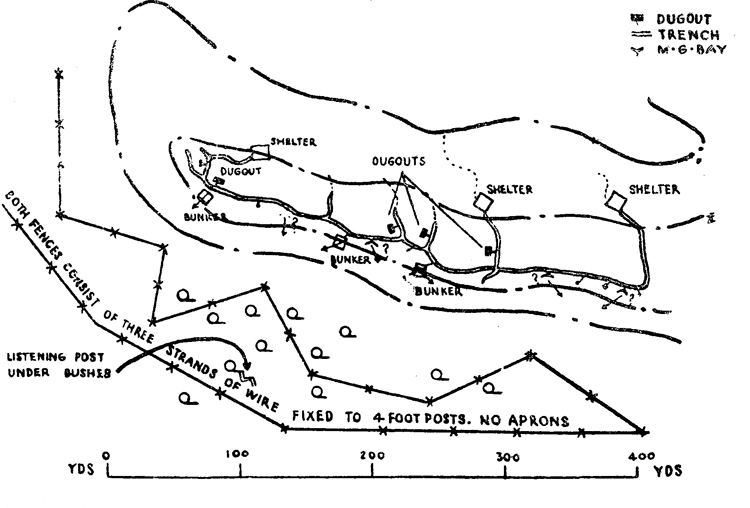
Example 2. A Battalion Position at Rathedaung
Except in the case of the locality illustrated in Example 6 it is only possible to show this posi-i-'tion generally. It is reproduced here because even without detail it gives some indication of the frontage and depth occupied by a battalion holding a defensive position amongsts small thickly wooded hills. This position was held by the Japanese for some weeks, and narrow flanking movements against it failed.
Forward localities were sited on the highest ground in the sector and organized for all round defence. Trenches in the most northerly localities were continuous.
Our own positions were North of those shown in the sketch map.

Example 3. Lophei Spur, Chin Hills
The Japanese position on the Lophei Spur was built for a garrison of one to two companies. The defence system was based on a few bunkers connected up to a large number of one-man posts designed for riflemen. These had no head cover, but were connected to the main communication trench by a covered trench. The occupant could remain in the covered portion during artillery fire or bombing and, as soon as the bombardment stopped, man his firing position. These communication trenches were 4 ft. to 5 ft. deep and the head cover consisted of one or two layers of pine log 8 inches to 1 ft. in diameter, with 3 ft. to 4 ft. of earth and shale over it. Headroom in most of these positions and in the accommodation shelters was from 5 ft to 6 ft.
In the main bunkers firing slits were well constructed and were about 2 ft. wide inside, 6 ft. wide outside, 8 inches in depth and 2 ft. in length. No baffle walls or blast screens were provided but most of the entrances were either long or curved. It would have been difficult to get grenades into the actual chambers, but once in, they would have injured or killed all the occupants. The major bunker positions had more than one way in, so that even if one was blocked the garrison could be reinforced through another passage. All the shelters were revetted and timber was sawn and fixed together by dogs. The standard of field engineering was high ; it appeared that the work had been carried out by the infantry garrison, with possibly a few engineers to "assist.

Example 4. "Boomerang "
This is a small feature on the West bank of the Kalapanzin, North of Buthidaung, which was held by a Suicide Company (JTBAKU CHUTAI) of 4 officers and 123 men armed with 3 MMGs, 9 LMGs and 3 Grenade Dischargers. The personnel of this detachment was drawn from various companies of the same battalion. After fierce fighting the position was captured by a battalion of the 2nd Punjab Regiment. According to a prisoner of war his battalion commander had warned this company that any one returning from the position unwounded would be shot. A number of short tunnels provided deep cover for the garrison.

Example 5. A Platoon locality
The locality illustrated below was one of three forming a company position which occupied a frontage of just under 1000 yards. Each locality was sited on a " pimple ". The area was covered with dense jungle and 50 yards was the maximum field of fire from this position until trees and bushes had been blasted away by aerial bombing.
As the localities were similar in layout and construction, only one of them—the left flank one-ie described in detail below.
Each locality was surrounded by a four-strand barbed wire fence sited about 20 yards from the foxholes, the wire perimeter measuring between 200 and 300 yards.
Two interesting features of these all-round defence positions are the one-man dug-outs constructed beside almost every foxhole, and the 3-bay LMG bunker. The dug-outs are constructed at the end of a trench and have an earth and timber head cover about 12 inches thick. Diagrams of the 3-bay LMG post appear at Appendix " B ", Example 1.

Example 6. Part of a Battalion Position
"This is an interesting example of a defended locality consisting almost entirely of unlinked weapon pits. It is possible that at least some of those on the hill have been linked by tunnels and that shelter from the shelling and aerial bombardment to which this position was frequently subjected, has been provided by burrowing deep into the hill side. This sketch was made from an aerial photograph and therefore shows only positions visible from the air, but it can safely be assumed that the line of weapon pits was continued under the trees on the south edge of the locality. It should be noted that in this drawing a black dot has been used to indicate both foxholes and MG positions.
This locality will be recognized as part of the battalion position given in Example 2.
APPENDIX "B". EXAMPLES OF MMG AND LMG POSTS IN BURMA
Example 1. The 3-Bay LMG Post
These diagrams show a post which was found in the platoon locality described previously.
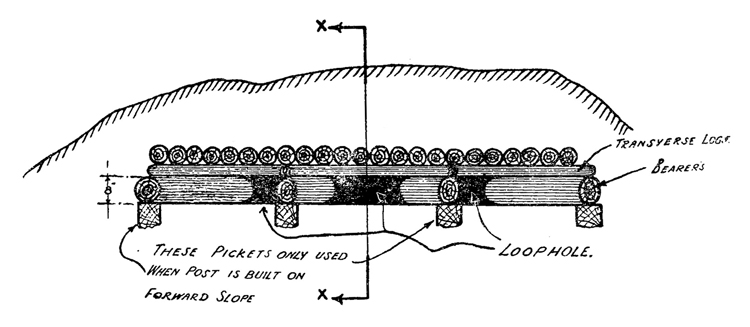
Front Elevation

Plan showing the detailed construction of the 3-bay LMGr post
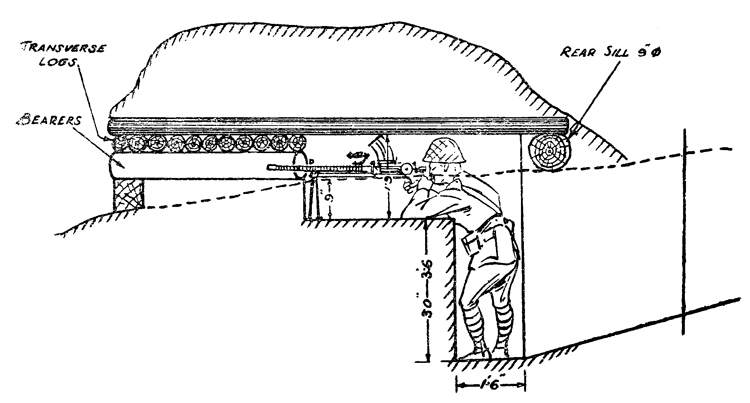
A cross-section on the line X—X
Example 2. Position dug into a roadside.
"This sketch illustrates a position dug into a roadside. A number of such positions, have been encountered in Burma.
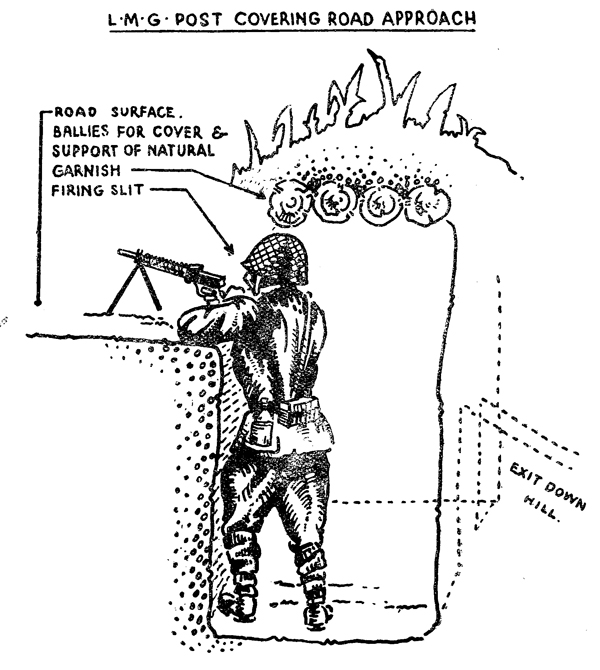
Example 3. A M.M.G. Bunker.
This post had 4 feet of earth on top. The logs from which the roof was constructed were 10' to 12 inches in diameter. The under-growth around was thick, tall, and undisturbed, and at a distance of 5 yards the firing slits could not be seen. The bunker was sited to cover a bend irt the Kalapanzin River and its banks.
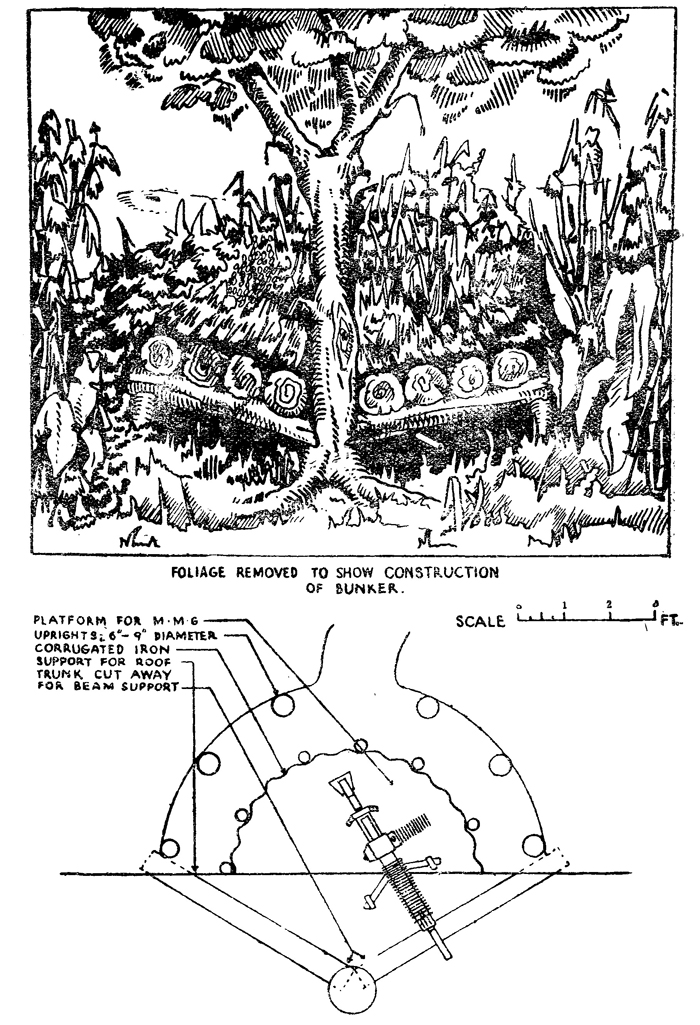
Example 4. Another Type of Bunker
The drawing below was made from a photograph showing the results of our shelling of one of ■ the bunkers in the "Massif" position, near Buthidaung. Other bunkers were completely obliterated, leaving only a shambles of timber, earth and corrugated iron. All had been pinpointed and destroyed before we launched our attack on the position.
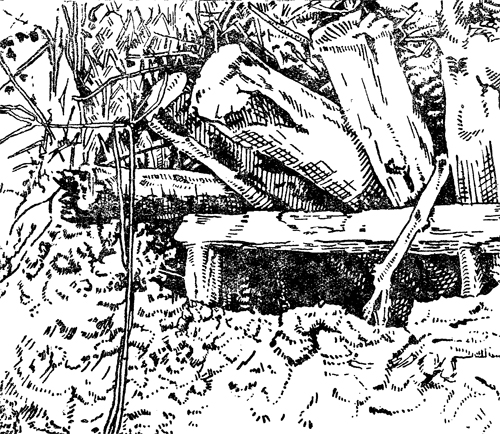
APPENDIX "C". An Example of Japanese Offensive Tactics, Arakan—February, 1944
COMPOSITION OF JAPANESE FORCES ENGAGED—GIVEN IN THE ORDER IN WHICH THEY APPEAR IN THE NARRATIVE.
Tanahashi Force
Comd. Col. Tanahashi.
112 Inf. Regt. (less 1 Bn., less one M.M.G. PI).
1 Bn., 143 Inf. Regt. (less 5 Coy.), (one mtn. gun attd.).
3 Bn., 55 Mtn. Arty. Regt. (Mtn. guns 2, Light mortars 4).
55 Engineer Regt. (less one Coy. and two Plo, but with main strength of 10 River Crossing
Materials Coy. attd.). One Sec. Div. Wireless. Medical and Water Purifying personnel.
Kubo Force
1 Bn., 213 Inf. Regiment (less one Coy. and one MMG PI.).
Sakurai Div. Inf. Group
Comd. Maj. Gen. Sakurai.
.55 Diy. Inf. Group HQ. and protection troops.
Div. Inf. Group Wireless Sec.
Water Purifying personnel.
Doi Force
Comd. Col. Doi.
143 Inf. Regt. (less 2 Bn., less 5 Coy.).
2 Coy. Med. Arty, (less one PL).
2 Bn. and 8 Coy. Mtn. Arty.
One PI. Engineers.
One Sec. of Div. Wireless. Medical Detachment.
The Japanese Plan
A fter the monsoon the opposing forces advanced towards each other until, by the end of January, their "dispositions were those shown approximately on Map 1. Towards the end of January the Japanese appreciated that we were building up j>ur strength in the area North of Buthidaung, and in order to forestall any plans we may have had in view, they decided to assume the offensive. This was originally to have been launched about the middle of February, but, in view of the progress of our own preparations, the attack actually tobk place a fortnight earlier. The Japanese plan was an ambitious one and was intended first to drive out and destroy our division East of the Mayu Range, and then to destroy our division West of the Mayu Range. It was assumed that under the pressure of this offensive these two divisions would be driven into the Naf River. The Japanese force with which this narrative deals was, therefore, not only intended to destroy our forces East of the Maya Range, but also to cross the range and destroy our division which was in the Maungdaw area.
On the night of 3/4 February the Tanahashi and Kubo forces left the Dabrugyaung area and moved North up the East side of the Kalapanzin River (see Map 2), passing through an area occupied by one of our brigades without being seen or heard. By the morning of 4 February they had reached Taung Bazar without meeting any opposition. 2 Battalion, 143 Regiment attacked this place from the West and captured it after slight resistance.
This battalion then formed a bridgehead West of the Kalapanzin River, and the rest of the force, less 2 Battalion 112 Regiment, crossed the river, and concentrated in the area 3 miles West of Taung Bazar. 2 Battalion 112 Regiment, which had been detached before the main force reached Taung Bazar, by-passed our positions and crossed the river some 5 miles North of that place.
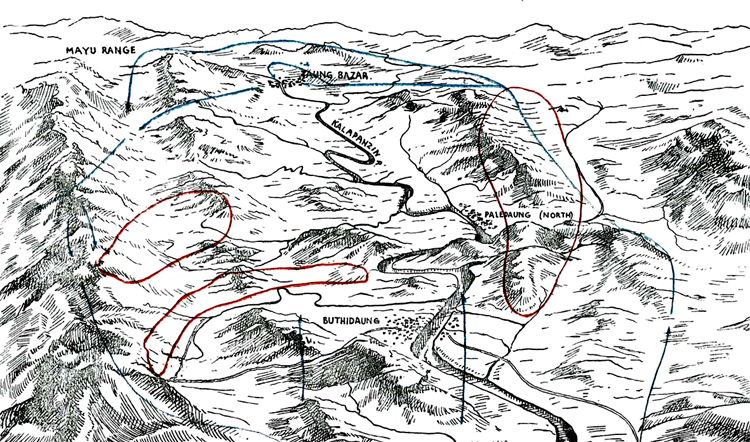
Drawing showing the general encirclement attempted by the Japanese,
On 5 February the Tanahashi and Kubo Forced were again divided. 2 Battalion US Regiment advanced southward towards the hills in the area of Shwechaing (see Map 3) to prevent our withdrawal WeGtward through the pass at the foot of which Shwechaing lies. They did not however, stay here, but continued South towards Ngakyedauk. Our tacts met this battalion in the area of Badana and inflicted heavy casualties, preventing further advance to Shweehaing by daylight. The Japanese, however, reached this objective that night (5/6 February).
In the meanwhile, the restof this force advanced South with the intention of seizing the East end of the Ngakyedauk Pass, but at midday on 5 February they met serious opposition at Ingyaung. Hero, they attacked alJ day but failed to dislodge our troops and fell back incurring considerable losses.
Kubo force crossed the Moyu Range, leap-frogging through 2 Battalion 112 Regiment at Shwechaing and reaching the Bawli-Maungdaw Road in the area of Cliota Maunghuama on the night of 5/6 February. Here, they damaged three bridges, and withdrew into the foot hills, contact, then being lost.

Map 1
During the night 5/6 February 2' Battalion 112 Regiment infiltrated southwards, and by 0400 hours 6 February they had reached tiie area at the East end of the Kgakyedauk Pass. At 0500 hours they attacked and overran our divisional headquarters, but were later driven out.
Major General Sakurai, who was directing the operation, now decided thai he could not wait for Colonel Tanahashi to close the Ngakyedauk Pass, and frontal attacks were made repeatedly on 6 and 7 February in the Sinohbyin area, 2 Battalion 114 Regiment, which had just been brought forward, taking part. All these attacks were repulsed.
Meanwhile, 2 Battalion 112 Regiment had established a strong road block on the Ngakyedauk Paso and were attacking the southern end. Enemy troops had Eucceeded in infiltrating along the Eastern slopes of the Mayu Eidge during the night 6/7th February, and there were about 100 Japanese South of Kreingyauug on the Tatmin Chaung. This chaung was being used by the enemy ac an L. of 0. Between 00 and 70 cooliec carrying rations were captured by us at Tatmin-gyaungwa on 7 February.
The situation in the Ingyaung area had become very confuted, small parties of our own and' Japanese troops becoming inextricably mixed, so that the latter could make no concerted attack.
From 7 to 8 February numerous email actions were fought, but without any decisive result. On fith February Doi Force, in position astride the Mayu Range, continued to launch diversionary attacks on the main front, and extended this activity to Maungdsw.
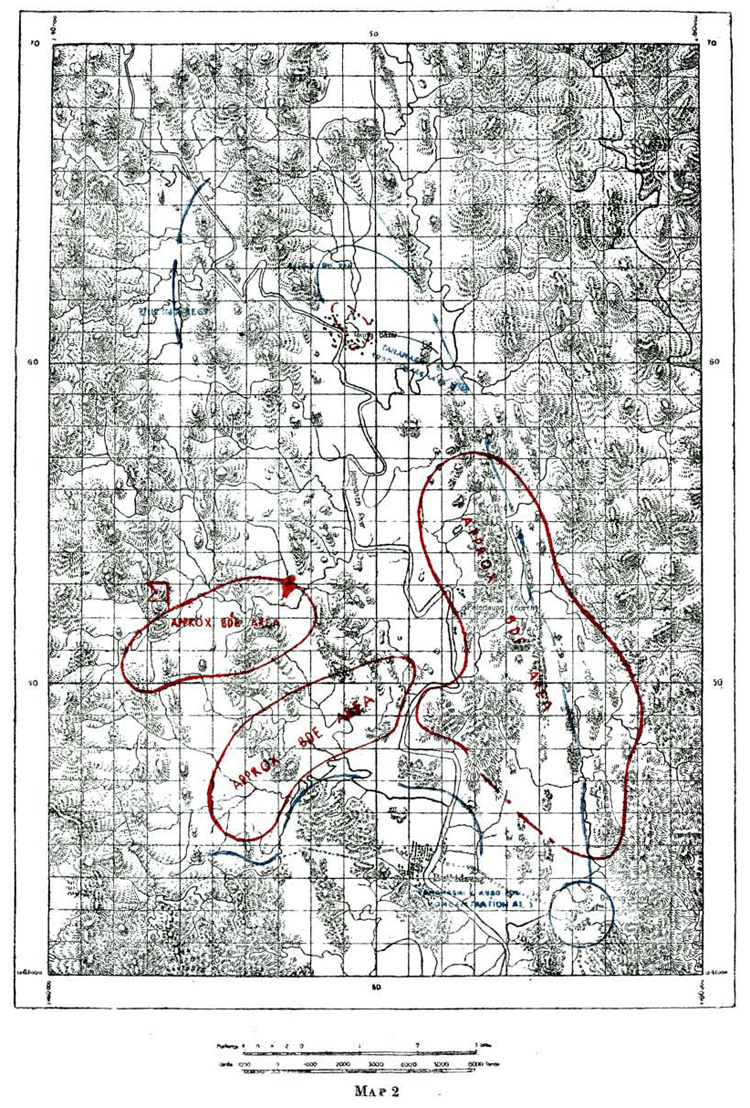
Map 2
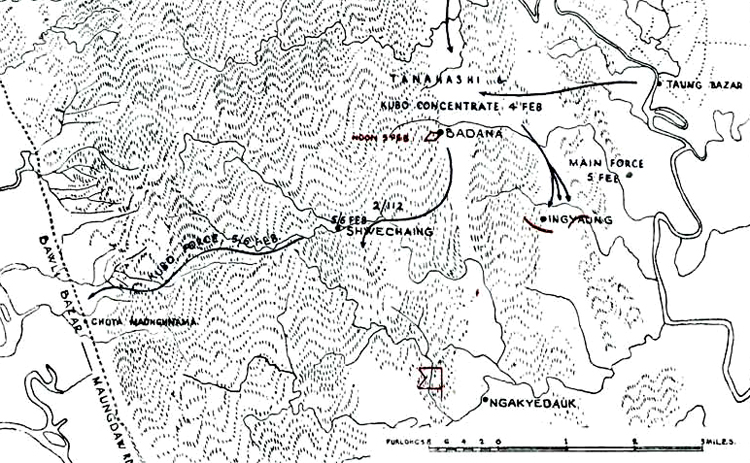
Map 3
Meanwhile, Colonel Tanahashi had been pushing that part of his main body which was still concentrated South from Ingyaung through the hills, and by 9 February this force was spread out from the Badana Chaung south through the hills to Awlanbyin.
Lt. General Hanaya, the Commander of the Division, had by now abandoned hope of destroying our divisions West of the Range, and ordered the Tanahashi Force to concentrate in Sinzweya area with the intention of destroying our forces there. On the same day we began to attack the Japanese in the area of the pass, where we captured positions and held them in spite of heavy counter-attacks by the Japanese on 10 and 11 February. The Japanese still held positions covering the Pass.
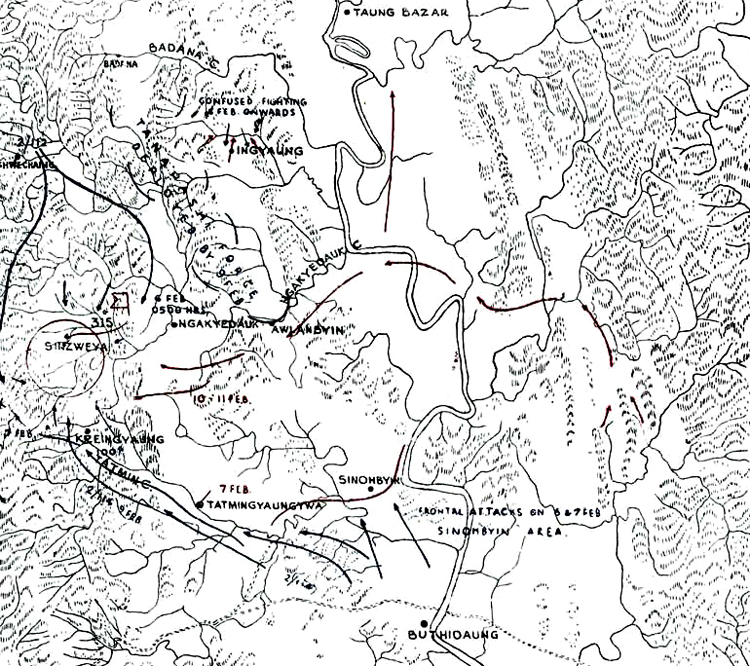
Map 4
During 9 and 10 February, the Japanese, as ordered, had been heavily attacking in the Sinzweya—Ngakyedauk area from North and South. The bulk of the Tanahashi Force was in the area Hill 315, and 2 battalion 144 Regiment had been taken from the Sinohbyin area for this attack, but the Japanese were unable to achieve any success.
By 11 February the Japanese had been put on the defensive generally, except in the areas Ngangyaung Bawli Road and on the Eastern slopes of the Mayu Range West of Ngakyedauk, where he was concentrating his efforts against our divisional box. By 13 February the Japanese had lost the initiative, and were suffering from difficulties of supply of both ammunition and food. From this date onwards the action became defensive on the Japanese side, while they attempted to withdraw.
The operation had provided another instance of how the Japanese, over-confident from their early successes, are inclined to use the minimum troops which they think are required to do the job. In this they diverge from German teachings which they follow so closely in many other respects. In this case, they used the minimum force and kept no reserves; and, when the operation failed, Colonel Tanahashi upon whose force the effectiveness of the encircling movement depended was, after being put on L. of C. duties in charge of the collection of supplies, sent back to Japan.
APPENDIX "D". EXAMPLES OF NIGHT ATTACKS IN BURMA
Example 1
The Battle of Pa-an
On 8 February 1942 a battalion of the Balueh Regiment took up a position at Huzeik, a village on the west bank of the Salween River. The position occupied was a saucer of open paddy land, surrounded by close jungle with thick undergrowth. The main road from Duyinzeik bounded the south of the position and then ran north along the river.
On the opposite bank of the river, 1,200 yards away, the Japanese occupied the town ot Pa-an. The role of the Balueh battalion was to prevent this Japanese force crossing the river in the Pa-an area.
To accomplish this the battalion was disposed around the saucer with battalion headquarters
in the centre. " A " Company held the river bank, " D " Company the northern face, "B"
Company the western face and " C " Company the southern face of the perimeter along the Duyinzeik road. In addition, patrols were constantly maintained along the river bank to Pagat m the
South and Mikayan in the North.
During the night of 10/11 February one of these patrols reported that the enemy had cross, ed the river near Pagat in strength. The patrol was over-run and a force was sent trom JluzeiK to assist it. The advance of this force was shadowed by the Japanese throughout its route, its position being signalled by the tapping of bamboos. However, it drove off the enemy.
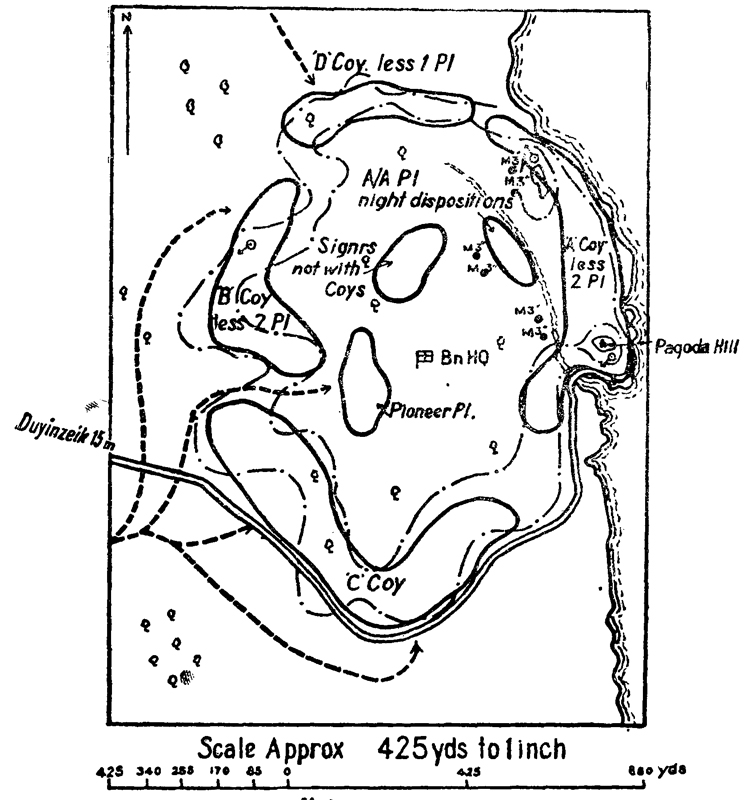

On the morning and afternoon of 11th February parties of the enemy were observed crossing the river north of Pa-an, and that evening patrols also reported the advance from Pagat in the South towards Kuzeik of a strong enemy force of about one battalion.
At 1630 hours a small .force attacked the Kuzeik position from the South along the rivet bank. A counter attack by " C " Company resulted in the withdrawal of the Japanese.
The enemy were next seen about 0100 hours when a section posted on the road one mile from our positions at Kuzeik reported that a battalion of Japanese were advancing in. strength from the direction of Duyinzeik.
A quarter of an hour later the main battalion positions were attacked from the West and South—west, the brunt of the first attack falling on " C " Company. Later attacks were also directed against " B " and " D " Companies from the North-West. The enemy made cat calls and shouted and chattered incessantly in an effort to draw fire and locate our positions : they also employed tracer ammunition and Chinese crackers.
It was now estimated that the Japanese had^deployed a whole regiment, and this superiority in numbers was having its effect on our defences. At 0230 hours, infiltrating between " B " and " C " Companies the enemy attacked " B** Company from the rear. " D " Company was also heavily engaged and the enemy had occupied its W©§t flank. Meanwhile, attacks were being made on battalion headquarters and on " A " Company.
The attacks were made in waves, each wave consisting of several parties of 10 to 15 men. These were armed with swords, bayonets and grenades and were supported by automatic weapons. Each party advanced in short rushes, the men lying prone after each advance.
By first light " B " and " D " Company positions had fallen into enemy hands and " A ""
Company was surrounded. There remainedjanly a very weak "C" Company and Battalion
Headquarters after the night's fighting. ThM BJ| ||l/*8- -jattack but this was thrown back by
the superior strength of the Japanese. B Ir IP ^ •"? felrf ffl '""'' " ' *•--
By 0800 hours the enemy occupied the •&mqj&Eitiip Kjpzei^: position.^; 1 ; ''.-"^Eimg*.
Comment.—This operation serves as a g«^^^a&^|©fnM o^ly' of theJ night .attack ojpinglso of
characteristic Japanese methods. Note the TWLCTO fe^^^^ig;: mpvefti^nt : the- fult^pireb^f the
attack came in along the defenders L. of C, whilst all enemy "^adfivrty.'observed jwfr ^fllaBfteern
minutes before the night attack had been on their South flank. "*■■ -3 ~
Once again the enemy used their now familiar methods of drawing fire.
The parties of 12 to 15 men were probably sections, and advancing by rushes was often, reported during the early phases of the Japanese war.
Example 2. An attack in the Upper Chindwin
A report of an attack on a camp in the Upper Chindwin Area states that the Japanese managed to creep up absolutely silently and unobserved by our sentries, almost to the perimeter of the camp. Decoy noises were made on three sides of the perimeter, and were immediately followed by an attack on the fourth side. The enemy succeeded in penetrating the perimeter, and four of them got in and made for the wireless station.
The attack was beaten off, but an hour later the enemy attacked again, using similar tactics; except that, on this occasion, a green flare was employed, lighting up the camp for about five minutes. This attack was also repulsed, and the enemy launched a third just before dawn. This attack was similar to the other two, and after about twenty minutes a red Verey light was fired, and the enemy withdrew.
Comment.—There are two points worthy of note here. The first is the deceptive tactics, which, the enemy normally employs; the second is the use of flares for signalling. The Japanese uses, these both by day and by night.
On this occasion again, the Japanese made repeated attacks during the hours of darkness 3 finally withdrawing at daybreak.
Example 3. Diversionary Tactics
During the nights of 4/5 and 5/6 November, 1943, the Japanese attacked our positions in the area of pts. 1619 and 1749. On the night of 4/5 November, at about 2345 hours, the Pt. 174J9 feature was attacked by a party frdmthe. South-West. At the same time a diversionary attack was made by another party of enemyvfrom the East with rifle and grenade discharger fire. The attack was beaten -off without casualties to ourselves, and, although enemy movement was iheard throughout the night, no further attack was made.
The attack on the night of 5/6 November commenced at about 1945 hours and continued until 0300 hours. There was then a lull of some two hours, after which the enemy put in an attack which continued until daylight, when he finally withdrew. This attack was put In on the Pt. 1619 •feature, and is estimated to have been made by one or two platoons. Rifles, L.M.Gs. and grenade dischargers were used, and the enemy attacked from all directions. He succeeded in cutting all telephone lines in the area, but wireless communication was established in the morning. Prior to the attack the enemy created a lot of noise, shouting and whistling, etc.
Comment
Note that a diversionary attack may be made at night as well as during daylight. Here the silent approach was sacrificed in the hope that noise would give the impression of large ^numbers and affect our morale.

